 AGENDA
AGENDA
Ordinary Council Meeting
Thursday, 13 March 2025
Time: 10:00am
Location: Council Chambers,
Memorial Ave, Kaikohe
Membership:
Kahika
- Mayor Moko Tepania - Chairperson
Kōwhai
- Deputy Mayor Kelly Stratford
Cr
Ann Court
Cr
Felicity Foy
Cr
Hilda Halkyard-Harawira
Cr
Babe Kapa
Cr
Penetaui Kleskovic
Cr
Steve McNally
Cr
Mate Radich
Cr
Tāmati Rākena
Cr
John Vujcich

1 Karakia
Timatanga / Opening Prayer
Ka tuku mātou kia kaha mai ngā māngai kua
whiriwhirihia mō Te Kaunihera o Te Hiku o te Ika ki te mahi me te
ngākau auaha me te whakamahi i ngā pūkenga me te mātauranga
i roto i ngā wānanga me ngā whakataunga kia whakatūria ai
tētahi Hapori e matatika ana, e tū kotahi ana ka mutu ka whakapiki
anō i te oranga o tō tātou rohe, ka whakatau anō i ngā
take o te rohe i runga i te tika me te pono.
We ask that through Council discussions and decisions the
representatives we have elected may govern the Far North District with
imagination, skill and wisdom to achieve a fairer and more united Community
that enhances the wellbeing of our district and solves the District’s
problems efficiently and effectively.
2 Ngā
Whakapāha Me Ngā Pānga Mema / Apologies and Declarations of
Interest
Members need to
stand aside from decision-making when a conflict arises between their role as a
Member of the Council and any private or other external interest they might
have. This note is provided as a reminder to Members to review the matters on
the agenda and assess and identify where they may have a pecuniary or other
conflict of interest, or where there may be a perception of a conflict of
interest.
If a Member
feels they do have a conflict of interest, they should publicly declare that at
the start of the meeting or of the relevant item of business and refrain from
participating in the discussion or voting on that item. If a Member thinks they
may have a conflict of interest, they can seek advice from the Chief Executive
Officer or the Manager - Democracy Services (preferably before the meeting).
It is noted that while members can seek advice the final
decision as to whether a conflict exists rests with the member.
Elected
Member - Register of Interests
3 Ngā
Tono Kōrero / Deputations
·
Whati from Ngati Rehia, Jo Civil and Rio Greening speaking to Te
Pātukurea – Item 6.2 (15 minutes).
·
Kelly van Gaalen from Pioneer Village presenting an overview of
the Pioneer Village status, business development, community engagement and
future strategy (5 minutes).
·
Dave Davies-Colley from Northland Basketball presenting to
Council why an indoor sports stadium is the best future use of the Old
Warehouse Building (5 minutes).
·
Jo Civil on behalf of Ngati Hineira – Rangitane Maritime
Development (15 minutes).
4 Ngā
Kōrero A Te Kahika / Mayoral Announcements
5 Te
Whakaaetanga o Ngā Meneti o Mua / Confirmation of Previous Minutes
5.1 Confirmation
of Previous Minutes
File
Number: A5056463
Author: Maria
Bullen, Democracy Advisor
Authoriser: Aisha
Huriwai, Manager - Democracy Services
Take Pūrongo / Purpose of the Report
The minutes are attached to allow Council to confirm that
the minutes are a true and correct record
of previous meetings.
|
tŪtohunga / Recommendation
That Council confirm the minutes of the Council
meeting held 13 February 2025 are a true and correct record.
|
1) TĀhuhu kŌrero / Background
Local Government Act 2002 Schedule 7 Section 28 states that
a local authority must keep minutes
of its proceedings. The minutes of these proceedings duly
entered and authenticated as prescribed
by a local authority are prima facie evidence of those
meetings.
2) matapaki me NgĀ KŌwhiringa /
Discussion and Options
The minutes of the meetings are attached.
Far North District Council Standing Orders Section 27.3
states that no discussion shall arise on the
substance of the minutes in any succeeding meeting, except
as to their correctness.
TAKE TŪTOHUNGA
/ REASON FOR THE RECOMMENDATION
The reason for the recommendation is to confirm the minutes
are a true and correct record of the
previous meetings.
3) PĀnga PŪtea me ngĀ
wĀhanga tahua / Financial Implications and Budgetary Provision
There are no financial implications or the need for
budgetary provision as a result of this report.
Āpitihanga / Attachments
1. 2025-02-13
Council Minutes - A5076019 ⇩ 
Hōtaka Take Ōkawa / Compliance Schedule:
Full consideration has been given to the provisions of the
Local Government Act 2002 S77 in relation to decision making, in particular:
1. A
Local authority must, in the course of the decision-making process,
a) Seek
to identify all reasonably practicable options for the achievement of the
objective of a decision; and
b) Assess
the options in terms of their advantages and disadvantages; and
c) If
any of the options identified under paragraph (a) involves a significant
decision in relation to land or a body of water, take into account the
relationship of Māori and their culture and traditions with their
ancestral land, water sites, waahi tapu, valued flora and fauna and other
taonga.
2. This
section is subject to Section 79 - Compliance with procedures in relation to
decisions.
|
He Take Ōkawa /
Compliance Requirement
|
Aromatawai Kaimahi /
Staff Assessment
|
|
State the level of significance (high or low) of the
issue or proposal as determined by the Council’s
Significance and Engagement Policy
|
This is a matter of low significance.
|
|
State the relevant Council policies (external or
internal), legislation, and/or community outcomes (as stated in the LTP) that
relate to this decision.
|
This report complies with the Local Government Act
2002 Schedule 7 Section 28.
|
|
State whether this issue or proposal has a District wide
relevance and, if not, the ways in which the appropriate Community
Board’s views have been sought.
|
It is the responsibility of each meeting to confirm
their
minutes therefore the views of another meeting are not
relevant.
|
|
State the possible implications for Māori
and how Māori have been provided with an opportunity to contribute to
decision making if this decision is significant and relates to land and/or
any body of water.
State the possible implications and how this
report aligns with Te Tiriti o Waitangi / The Treaty of Waitangi.
|
There are no implications for Māori in confirming
minutes from previous meeting. Any implications on Māori arising from
matters included in meeting minutes should be considered as part of the
relevant report.
|
|
Identify persons likely to be affected by or have an
interest in the matter, and how you have given consideration to their views
or preferences (for example – youth, the aged and those with
disabilities).
|
This report is asking for minutes to be confirmed as
true
and correct record, any interests that affect other
people should be considered as part of the individual reports.
|
|
State the financial implications and where budgetary
provisions have been made to support this decision.
|
There are no financial implications or the need for
budgetary provision arising from this report
|
|
Chief Financial Officer review.
|
The Chief Financial Officer has not reviewed this
report.
|
|
Ordinary
Council Meeting Agenda
|
13 March 2025
|







6 Ngā
Pūrongo / Reports
6.1 Adoption
of Statement of Proposal for Fees & Charges for 2025/26
File
Number: A5086583
Author: Sue
Fox, Management Accountant
Authoriser: Charlie
Billington, Group Manager - Corporate Services
Take Pūrongo / Purpose of the Report
To adopt a schedule of fees and charges for the 2025/26 financial
year.
WhakarĀpopoto matua / Executive Summary
· Under
the Local Government Act 2002 (the LGA), Council is required to review fees and
charges annually.
· The
adoption of fees and charges must occur prior to the start of the financial
year to which they apply.
· In
most cases, increases are limited to the Local Government Cost Index (LGCI)
inflation factor which is forecast at 2.6% for 2025/26. Exceptions are
discussed in this report.
|
tŪtohunga
/ Recommendation
That Council:
a) adopts
the Statement of Proposal to consult on the Schedule of Fees and Charges for
2025/26.
|
1) TĀhuhu kŌrero / Background
Council reviews and adjusts its fees and charges on an
annual basis.
Although many of our fees and charges may be set by Council
resolution under section 150 of the Local Government Act 2002, some must follow
a formal process with public consultation in accordance with section 83 (the
Special Consultative Procedure or SCP).
We therefore carry out the annual review of fees and charges
as follows:
1. A
review of fees and charges is conducted and an inflationary adjustment applied
to allow for any increases that may affect the goods or service. This review
also allows any other fees or charges to be altered, amended or renewed if
required. A Statement of Proposal (SOP) is prepared for consultation alongside
the proposed schedule of fees and charges. A consultation period of four weeks
for written submissions is followed by hearing of verbal submissions (if
required) and deliberations. The council will then consider any further changes
and adoption of the schedule in early June with an enactment date of 1 July
2025.
The fees/charges that have changed
are shaded in the Schedule for ease of reference.
All adjustments are consistent with
Council’s decision as part of the Long Term Plan 2024-27 to adjust fees
annually in line with changing circumstances and specifically in line with
inflation. They ensure consistency with the Council’s Revenue and
Financing Policy.
2) matapaki me NgĀ KŌwhiringa /
Discussion and Options
In general, fees have been adjusted by inflation (LGCI)
which is forecast at 2.6% for the 2025/26 year).
Exceptions are:
· Some
fees and infringements are set by statute (e.g. Sale and Supply of Alcohol Act
2012) and are therefore not adjustable.
Inflationary adjustments are proposed for the following
(refer to the Schedule of Fees and Charges attachment):
· Dog registrations,
other fees, impounding fees
· Building consents
· Vehicle crossing
application and inspection fees
· Bylaw enforcement
· Cemeteries
· Environmental
health licences
· Fire prevention
· Food act
· Gambling venue
fees
· Mobile shop,
street stall and hawkers licences
· Alfresco dining
· Leases and
licenses of Reserves
· Legal services
· Libraries
(organisation borrower)
· Official
information – operative District Plan
· Property
information - staff time, physical map requests, postponement fees
· Resource consents
· Transport network
· Applications and
inspections relating to works on Council infrastructure (stormwater, wastewater
and water)
No changes are proposed for the
following:
· Hokianga Ferry
charges
· Official
information - LGOIMA requests, supply of publications, agendas, minutes,
photocopying and scanning charges)
· Property
information – digital data supply
· Rubbish disposal
at transfer stations
· Venues for hire
No change for legislated fees:
· Amusement devices
· Alcohol licencing
The fees and charges recommended for adjustments are
detailed below:
Changes to resource consents fees
Reinstatement
of the Objection fee: During the 2023/24 financial year, a crucial fee
associated with objections to conditions was inadvertently removed, and this
omission continued into the 2024/25 (current) financial year.
Previously,
this fee was approximately $1,000.00 and served as an incentive for ensuring
conditions were accurately set at the decision stage. The absence of this fee
has led to additional staff time being spent without corresponding cost
recovery.
To
address this, the council proposes reinstating the objection fee to mitigate
these unrecouped costs and encourage accuracy in the initial decision-making
process. The fixed fee for ‘Objections on a council decision’ has
been added to cover the complexity and work undertaken to review a resource
consent decision.
Additional resource consent fees
The following fees are proposed for clarification purposes:
Hourly processing
charges: That fees for hourly processing charges have been added for a Senior Resource Consent Engineer and Planning Support - Senior / Team Leader and administration charge. This is based on actual
averages of time taken to perform duties to process resource consent
applications.
Pre-Application
Meetings & Concept Development Meetings (PAM’s &
CDM’s): are charged on the actual cost and can involve a lot of
different departments across the council. To recover cost for time spent
working on these applications we have calculated an instalment fee of $345.00.
Decrease
to fee - Engineering plan approvals: The fee has
been decreased as we are changing the way these are processed to include
(construction management plans, sediment control plans, as-built plan, site
visit for LUC condition plans). All these vary in processing time and
complexity and depending on what plans an engineer is viewing it can take from
30 minutes for a simple plan – up to four hours and a site visit for a
complex plan.
Travel
cost for resource consents: rewording of proposed fee wording for clarification
Other fees and charges 2025/26 amendments
The majority of fees and charges have been adjusted by a
2.6% inflationary increase, unless set by legislation etc.
Animals:
Dog impounding: Increase fee for second and subsequent
impounding fee. This fee now incorporates the third and subsequent impounding
fee and has been increased to cover additional costs as well as acting as a
deterrent. The third and subsequent impounding fee will be removed.
Daily handling fee: This fee has been increased to cover
shelter operational costs and general price increases for subsistence etc.
Building consents
Certificate of title request: This fee has been increased
beyond the 2.6% inflationary adjustment to include the $2.00 LINZ fee increase.
Field advice notice: Remove this fee as no longer required.
Swimming pool inspections: Amend schedule to reflect actual
costs as each inspection differs.
The inclusion of Building Specialist into the hourly rates.
Vehicle crossings
Amendment of wording to clarify actual costs of service.
Bylaw enforcement
Return of seized noise equipment: Introduction of fee set at
same charge as seized signs.
Licence to occupy application: Introduced to cover the cost
of process applications.
Certificates, License and Permits
Health license: Amendment to wording to clarify additional
charges if required.
Electronic property file requests: A minimal increase
above inflation to reflect the increase time required to process requests.
Lease and License of Reserves: Temporary license to
occupy road reserves and reserves: Introduction of fee charging for occupying
road and reserves processing and application fees.
Libraries: Faxing: Removal of faxing fees as no
longer applicable.
Land Information Memoranda (LIMs): Marginal increase
to overall cost to reflect the significant processing time for applications.
Additional charges should the application process take longer will be charged
at the research fee rate ($40.00 per half hour)
Council could decide not to adjust fees and charges as
proposed. However, by doing so Council risks not recovering the actual and
reasonable costs associated with these activities, placing the burden on the
general ratepayer and creating the potential for steeper increases in future
years.
TAKE TŪTOHUNGA
/ REASON FOR THE RECOMMENDATION
The reason for the recommendation is to ensure an adopted
schedule of fees and charges is in place prior to the start of the 2025/26
financial year.
3) PĀnga PŪtea me ngĀ
wĀhanga tahua / Financial Implications and Budgetary Provision
Forecast revenue from the Schedule of Fees and Charges for
2025/26 is recognised in the budget adopted as part of the Annual Plan for
2025/26.
Āpitihanga
/ Attachments
1. Proposed
fees and charges schedule 2025-26 - A5063320 ⇩ 
2. Statement
of Proposal - Fees and Charges 2025-26 - A5063398 ⇩ 
Hōtaka Take Ōkawa / Compliance Schedule:
Full consideration has been given to the provisions of the
Local Government Act 2002 S77 in relation to decision making, in particular:
1. A
Local authority must, in the course of the decision-making process,
a) Seek
to identify all reasonably practicable options for the achievement of the
objective of a decision; and
b) Assess
the options in terms of their advantages and disadvantages; and
c) If
any of the options identified under paragraph (a) involves a significant
decision in relation to land or a body of water, take into account the
relationship of Māori and their culture and traditions with their
ancestral land, water sites, waahi tapu, valued flora and fauna and other
taonga.
2. This
section is subject to Section 79 - Compliance with procedures in relation to
decisions.
|
He Take Ōkawa /
Compliance Requirement
|
Aromatawai Kaimahi /
Staff Assessment
|
|
State the level of significance (high or low) of the
issue or proposal as determined by the Council’s
Significance and Engagement Policy
|
Low Significance
|
|
State the relevant Council policies (external or
internal), legislation, and/or community outcomes (as stated in the LTP) that
relate to this decision.
|
Local Government Act, Resource Management Act
|
|
State whether this issue or proposal has a District wide
relevance and, if not, the ways in which the appropriate Community
Board’s views have been sought.
|
District-wide relevance
|
|
State the
possible implications for Māori and how Māori have been provided
with an opportunity to contribute to decision making if this decision is
significant and relates to land and/or any body of water.
State the
possible implications and how this report aligns with Te Tiriti o Waitangi /
The Treaty of Waitangi.
|
No specific implications.
|
|
Identify persons likely to be affected by or have an
interest in the matter, and how you have given consideration to their views
or preferences (for example – youth, the aged and those with
disabilities).
|
No specific demographic identified.
|
|
State the financial implications and where budgetary
provisions have been made to support this decision.
|
The
proposals outlined are in intended to meet the funding arrangements specified
in the Revenue and Financing Policy. Adjustments as proposed support cost
recovery intentions for the relevant activities.
|
|
Chief Financial Officer review.
|
The Chief Financial Officer wrote this report.
|
|
Ordinary
Council Meeting Agenda
|
13 March 2025
|
























|
Ordinary Council
Meeting Agenda
|
13 March 2025
|
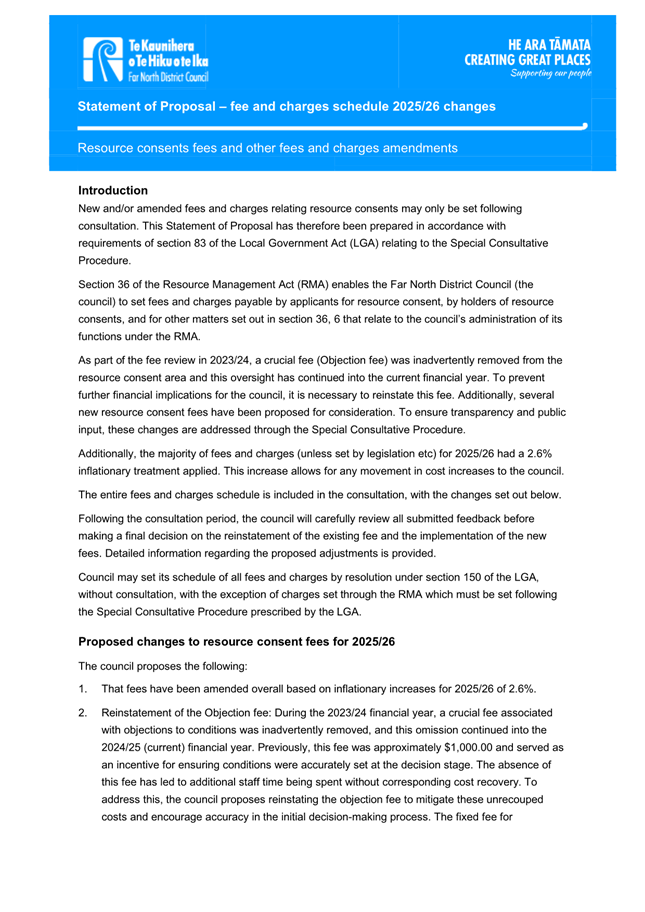



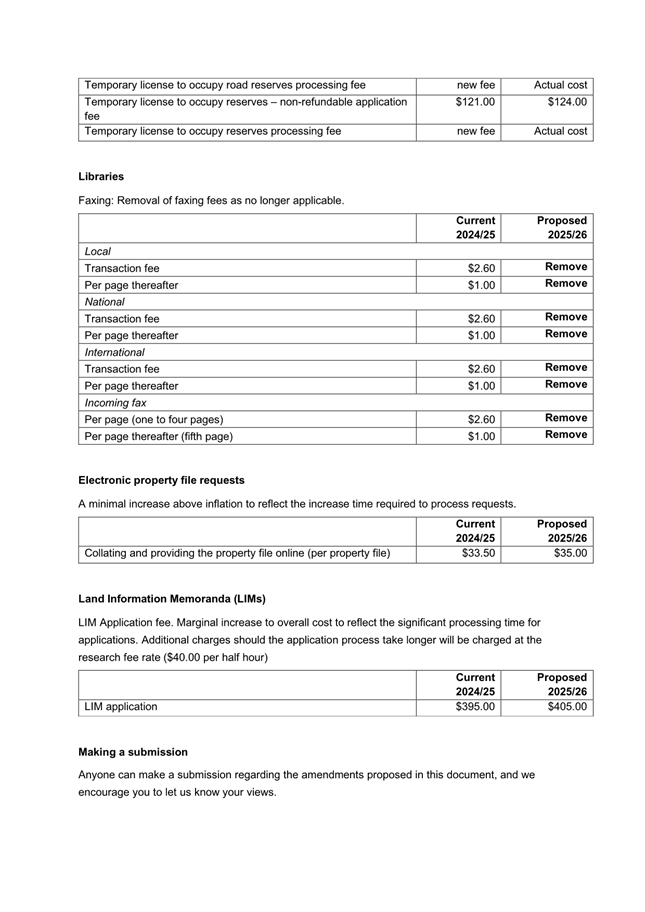
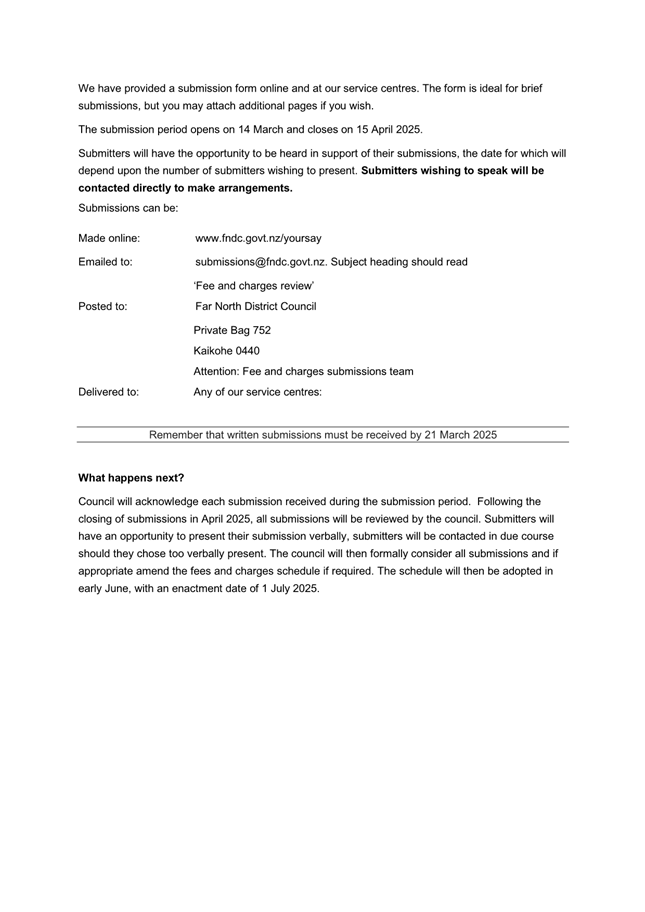
6.2 To
Undertake Public Consultation on The Draft Version of Te Pātukurea Kerikeri
Waipapa Spatial Plan
File
Number: A5090250
Author: Jaye
Michalick, Team Leader – Growth Planning & Placemaking
Authoriser: Roger
Ackers, Group Manager - Planning & Policy
Take Pūrongo / Purpose of the Report
To seek approval from Council to undertake public
consultation using a special consultative procedure (SCP) under the Local
Government Act (2002), between 20 March 2025 and 22 April 2025 on the draft Te
Pātukurea Kerikeri-Waipapa Spatial Plan (the draft plan).
WhakarĀpopoto matua / Executive Summary
· The
draft plan shows how future growth over a 30-year time period for Kerikeri and
Waipapa will take place, describing where future housing, business and
industrial development will happen and the form this development will take. It
also describes the related infrastructure and amenity investment necessary to
achieve the plan’s outcomes.
· It
is based on blue sky population growth assumptions and promotes urban change
with 95% of growth directed to an urban environment.
· It
is based on a hybrid growth scenario (elements of scenarios D, E & C), that
was created following evaluation of the six growth scenarios that were
consulted on in November 2024. It shows future growth being balanced between
Kerikeri and Waipapa, expanding from the existing urban areas.
· The
Hapū Rōpū has endorsed the draft spatial plan.
· The
draft plan includes an Implementation Plan. The Implementation Plan looks
at the actions required in the short, medium and long-term, it is based on
staging of growth and ongoing monitoring and evaluation. This is the roadmap to giving
effect to the Spatial Plan.
· The
use of a Special Consultative Procedure (SCP) is discretionary, but the project
team recommends using the SCP, given the significance of the influence that the
spatial plan will have on future development in Kerikeri-Waipapa. It will also
ensure that Council can have confidence in the consultation process as a basis
for making final decisions on the adoption of Te
Pātukurea Kerikeri-Waipapa Spatial Plan.
· By
undertaking a SCP, submitters can make an oral submission on the draft plan
direct to Elected Members.
· The
proposed SCP is supported by a comprehensive engagement plan for public
consultation. This will be the last stage of public consultation before
the spatial plan is finalised. Public engagement is legally required to
complete the plan.
· If
development of the Plan is delayed by not undertaking consultation in March /
April, it will have an impact on the Proposed District Plan (PDP) Hearing
schedule, due to the interdependences of the projects.
|
tŪtohunga
/ Recommendation
That Council approve:
a) the draft Te
Pātukurea Kerikeri-Waipapa Spatial Plan,
detailed in Attachements 1 & 2 for pubilc consultation using the Special Consultative
Procedure to take place between 20 March and 22 April.
b) any
grammatical or other immaterial corrections to the draft spatial plan may be
approved in writing by either the Chief Executive or Mayor, prior to
publication of the draft on 20 March.
|
1) TĀhuhu kŌrero / Background
· Te
Pātukurea Kerikeri Waipapa Spatial Plan is being prepared under resolution
2021/40 of the Strategy and Policy Committee, which required a review of the
2007 Kerikeri Waipapa Structure Plan.
· Te
Pātukurea is a key strategic document, which will support Council
decision-making and provide certainty to our partners, the development sector
and infrastructure providers about our intentions for urban change over the
next 30-plus years. It does this by spatially identifying areas for projected
residential, industrial and commercial growth. It sets out the actions that
will be required to achieve the four objectives set out for the plan. The
objectives relate to resilient infrastructure, built form, transportation and
environmental protection or enhancement.
· Public
engagement in November/December 2023 informed the development of the spatial
plan objectives.
· On
October 17, 2024, Council endorsed carrying out public engagement on the six
Kerikeri-Waipapa growth scenarios. Public engagement on these
scenarios was held during November 2024.
· An
evaluation process that considered public feedback resulted in the development
of a hybrid growth scenario.
· The
hybrid growth scenario is a composite of elements of both scenario D –
Kerikeri South, and scenario E – Waipapa. The hybrid scenario also
incorporates a portion of scenario C – North Waipapa Road
Expansion.
· In
December 2024 Council workshopped the growth scenarios evaluation process and
outcomes and endorsed the resulting preliminary hybrid scenario.
· In
January 2025 Council workshopped a refined hybrid scenario and reviewed
detailed growth provisions, and investment implications for this
scenario.
· In
February 2025, Council workshopped key content of the draft plan in preparation
for finalisation to seek Council approval to take the draft plan out for public
consultation.
· The
Hapū Rōpū has endorsed the draft spatial plan.
· Staff
are working to a timeline of having a Council decision on the Te Pātukurea Kerikeri-Waipapa Spatial Plan at the 18 June 2025
Council meeting, due to its interdependencies with the Proposed District Plan
Urban Environment Section 42a Hearing Report.
2) matapaki me NgĀ KŌwhiringa /
Discussion and Options
The hybrid growth scenario presented in the draft spatial
plan is the outcome of an evaluation process that brings together
infrastructure cost analysis, subject matter expert analysis, a cultural impact
analysis, and the results of public engagement.
The scenario provides for the anticipated growth in the
Kerikeri-Waipapa area, while balancing growth that seeks to achieve good urban
form with community values and aspirations, and the costs of infrastructure
investment. The scenario aligns with the Hapū Rōpū
aspirations for the Kerikeri-Waipapa area.
Its plans for housing, commercial and industrial growth
balanced between brownfield and greenfield development, focused on the existing
Kerikeri and Waipapa urban centres, while ensuring the separate identities of
these communities continue to develop.
The scenario covers a 30-year time period and is based on
blue sky population growth that promotes urban change, with 95% of development
to occur within an urban environment. It caters for 4690 additional
households, an additional 18.5 hectares of business land and an additional 4.7
hectares of industrial land.
Special Consultative Procedure
(SCP)
When seeking and receiving the views of interested parties
on policy or plan development or adoption, Council has discretion over how it
consults the public. Council must have regard for the significance of the
matter under consideration in deciding how and when to consult.
Te Pātukurea Kerikeri-Waipapa Spatial Plan is a
significant matter as it will set the long-term context for how development
occurs in Kerikeri-Waipapa, the district’s largest urban area. The
spatial plan will influence future Long-Term Plans and District Plans, as well
as many other subsidiary Council actions. Te Pātukurea holds special
significance for the district as the Kerikeri-Waipapa area is forecast to
receive approximately 50% of district-wide growth in the coming decades.
At present Kerikeri-Waipapa receives more than 20% of daily
arrivals for work or education from outside the area, and from a catchment that
extends to Doubtless Bay, Ōkaihau/Hokianga, Kaikohe and Kawakawa, and
includes many district-wide settlements. Interested parties therefore include
all residents, business owners and operators, collectives, and organisations
within the Kerikeri-Waipapa area and it is likely there are many interested
parties within the wider district.
For these reasons, a Special Consultative Procedure is
proposed for the final phase of public consultation on the draft spatial
plan. This procedure provides for oral submissions and is intended to
ensure a high-level of Council and community confidence in the spatial plan,
which will direct other plan making functions of Council.
Proposed Public
Engagement Methods
Key features of the draft spatial plan
public consultation are:
· Period:
the Special Consultative Procedure will occur between 20 March and 22 April,
2025.
· Engagement
activities/events comprising:
o consultation materials made available throughout the study area,
including service centres
o direct communication with engagement database, stakeholders, and
advisory groups
o website content and online survey
o in-person events
o media and social media campaign
o targeted rangatahi engagement, in partnership with Healthy Families
Far North
o oral submissions, 1 and 2 May, 2025, Turner Centre, Kerikeri.
· Key
engagement questions and messages:
o Do you support the draft spatial plan? Yes/No and why.
o Please outline any specific changes to the draft spatial plan that you
would like us to consider.
o Do you think the proposed planning and urban design principles will
help us achieve our plan objectives? Yes/No and why.
o Do you agree with the actions set out in the draft implementation
plan? Yes/No and why.
o Te Pātukurea will be a plan for everyone. That’s why we
want you to have your say, so we can capture the diverse views of our community
to shape how our district develops over the next 30 years. This will include
how where we live looks and feels, where and how we live, how we get around,
where we work and how we care for our environment.
TAKE TŪTOHUNGA
/ REASON FOR THE RECOMMENDATION
Council
has supported the development of the Te Pātukurea Spatial Plan to date and
has approved earlier rounds of public engagement on this project (in
November/December 2023 and November 2024). Having completed public
engagement on draft growth scenarios, a robust evaluation process was used, to
determine the preferred growth scenario which is reflected in the draft
plan. Elected Members have been involved in two workshops that have
contributed to the refinement of the draft plan. The draft plan has been
endorsed by the Hapā Ropū.
The use of
a SCP is a robust form of public consultation. The SCP will be the last of
three stages of public engagement on the development of Te Pātukurea prior
to final adoption of the plan targeted for mid-2025. Public engagement is
required legally to complete the development of the final plan. The use
of the SCP is supported by a comprehensive plan for public engagement.
3) PĀnga PŪtea me ngĀ
wĀhanga tahua / Financial Implications and Budgetary Provision
The estimated costs for the SCP are $10,000. These
costs have been budgeted for within the 24/25 financial year cost centre for
this project and will come out of the Growth Planning and Placemaking Team
budget.
The main additional costs for
undertaking an SCP are related to holding the oral submissions.
Āpitihanga
/ Attachments
1. Statement
of Proposal and Draft Te Pātukurea KerikerI Waipapa Spatial Plan -
A5090247 ⇩ 
2. Draft
Implementation Plan for Te Pātukurea Kerikeri Waipapa Spatial Plan -
A5090248 ⇩ 
Hōtaka Take Ōkawa / Compliance Schedule:
Full consideration has been given to the provisions of the
Local Government Act 2002 S77 in relation to decision making, in particular:
1. A
Local authority must, in the course of the decision-making process,
a) Seek
to identify all reasonably practicable options for the achievement of the
objective of a decision; and
b) Assess
the options in terms of their advantages and disadvantages; and
c) If
any of the options identified under paragraph (a) involves a significant
decision in relation to land or a body of water, take into account the
relationship of Māori and their culture and traditions with their
ancestral land, water sites, waahi tapu, valued flora and fauna and other
taonga.
2. This
section is subject to Section 79 - Compliance with procedures in relation to
decisions.
|
He Take Ōkawa /
Compliance Requirement
|
Aromatawai Kaimahi /
Staff Assessment
|
|
State the level of significance (high or low) of the
issue or proposal as determined by the Council’s
Significance and Engagement Policy
|
The decision being sought by this paper is not defined
as being of high significance in accordance with our Significance and
Engagement Policy, as the project does not involve the transfer of ownership
or control of a strategic asset, and it is not inconsistent with Council
plans or policies. However, it is recognised that, for the Kerikeri-Waipapa
area, there will be a moderate to high level of interest by those communities
and this is why public consultation following the special consultative
process is considered appropriate.
|
|
State the relevant Council policies (external or
internal), legislation, and/or community outcomes (as stated in the LTP) that
relate to this decision.
|
Resource Management Act 1991 and where relevant the
current planned three phased amendment of this Act.
National Policy Statement – Urban Development 2020
Local Government Act 2002
Far North District Council Operative and Proposed
District Plans
FNDC Integrated Transport Strategy
FNDC Far North 2100
Te Tai Tokerau Regional Accessibility Strategy
Toi Mana Arts Culture and Heritage Strategy
|
|
State whether this issue or proposal has a District wide
relevance and, if not, the ways in which the appropriate Community
Board’s views have been sought.
|
The geographical extent of Te Pātukurea is
contained within the Bay of Island Whangaroa Community Board (BOIWCB) ward.
However, the implications from the adoption of spatial plan for Kerikeri
Waipapa has district wide relevance as the subsequent district wide spatial
strategy will incorporate Te Pātukurea and the process for that
project. The growth options are also based on the assumption that 50%
of the district’s growth will occur in this area.
Members of the BOIWCB with an interest in the Kerikeri
Waipapa areas have participated in workshops focused on the development of
draft spatial plan. Any feedback discussed has contributed to the draft
spatial plan being taken out for public consultation across March and April
2025.
|
|
State the
possible implications for Māori and how Māori have been provided
with an opportunity to contribute to decision making if this decision is
significant and relates to land and/or any body of water.
State the
possible implications and how this report aligns with Te Tiriti o Waitangi /
The Treaty of Waitangi.
|
There are wide reaching implications for Māori,
whenua Māori, awa and moana that come from the recommendation in this
report. Māori have been provided with the opportunity to participate in
the decision-making process by the forming of a Hapū Rōpū
Governance Group made up of Hapū with an interest in the
Kerikeri-Waipapa Area. The Hapū Rōpū have regular hui
(approximately monthly) with the project team, to participate in the
development and decision making processes throughout the project. The
Hapū Rōpū will continue to be involved in the project until
the completion of the public consultation phase on the draft spatial plan, at
which point responsibility for adoption of Te Pātukurea will be handed
over to the decision makers (elected members).
Hapū are supportive of the draft spatial plan to be
taken out for public consultation. Māori can also independently of the
Hapu Ropu submit on the draft plan.
|
|
Identify persons likely to be affected by or have an
interest in the matter, and how you have given consideration to their views
or preferences (for example – youth, the aged and those with
disabilities).
|
There are numerous community groups who have been
engaged throughout the project to date, these groups will continue to be
engaged with at relevant milestones across the project. The wider public,
including a targeted rangatahi/youth section will be consulted on this draft
spatial plan to enable their views to be considered prior to recommended a
final version of the spatial plan for adoption by elected members.
|
|
State the financial implications and where budgetary
provisions have been made to support this decision.
|
There is no requirement for further budgetary
provisions to be made as result of the recommendation in this report.
|
|
Chief Financial Officer review.
|
Type here
|
|
Ordinary
Council Meeting Agenda
|
13 March 2025
|

|
Ordinary
Council Meeting Agenda
|
13 March 2025
|

6.3 Committee
Recommendations and Resolutions - February 2025
File
Number: A5105849
Author: Maria
Bullen, Democracy Advisor
Authoriser: Aisha
Huriwai, Manager - Democracy Services
TAKE PŪRONGO / Purpose of the Report
· To
increase governance oversight of Committee business/discussions.
· Communicate
resolutions of Committee meetings.
· Escalate
Committee recommendations to Council.
WHAKARĀPOPOTO MATUA / Executive SummarY
· The following Committee meetings were held
in February 2025
- 19 February 2025 - Te Miromiro Assurance
Risk and Finance
- 25 February 2025 – Te Koukou
Transport and Infrastructure Committee
- 27 February 2025 – Te Kuaka Te Ao
Māori Committee
· Copies of the Committee meeting minutes are
attached for information.
· Links to the agendas containing the reports
that formed the basis of the recommendations below are included in this report.
|
TŪTOHUNGA
/ Recommendation
That Council
Te Kuaka-
Te Ao Māori Committee: Item 5.7 Te Kahu O Taonui
Update 1 January 2025 - 28 February 2025.
Moved: Cr
Penetaui Kleskovic
Seconded: Katie Murray - Te
Kahu o Taonui Representatives
That Te Kuaka – Te Ao
Māori Committee:
a) receive
the report Te Kahu o Taonui Update 1 January 2025 - 28 February 2025.
b) and
that Te Kuaka support a recommendation that Council, before 1 April 2025,
direct the CE to dedicate at least 2 new FTE’s in Te Hono to ensure:
a. Development
of Whenua Māori and
b. Streamlining
and expediting the consenting process and facilitation between landowners and
relevant stakeholders.
c. and
allocate a budget of $700k per annum.
And:
c) that
Te Hono have their own General Manager at Senior Leadership Level.
d) that
Council make submissions to Central Government to support the removal of
regulatory barriers to the cost of consenting and development of Whenua
Māori.
Te Koukou
– Transport and Infrastructure Committee: Item 5.1 Transport Portfolio
Member Reports
That Te Koukou recommend to Council that:
a) That the CEO to approve the transfer of
the FNDC Local Share from NZTA Activity class Local Road Pothole Prevention
category 212 to 111 to advance the final phase of the 2024-25 sealed pavement
maintenance programme and that;
b) Any final accounting variation be
addressed by way of a minor amendment to the funding impact statement
2024-25.
|
tĀHUHU KŌRERO / Background
This is a regular report to provide
greater governance oversight of discussions that occur at Committee meetings
and to avoid duplication of reading for Councillors for decisions that are
recommended to them, from each Committee meeting.
Copies of Committee meeting minutes
that have occurred since the last ordinary Council meeting are attached for
information.
From time to time,
Committee’s discuss items that are outside their delegations. This
report, when necessary, will highlight recommendations from each Committee to
Council for decision.
Information about Council,
Committee or Community Board meetings is publicly available at https://infocouncil.fndc.govt.nz/
MATAPAKI ME NGĀ KŌWHIRINGA /
Discussion and Next Steps
The Committee meetings
held since the last Council meeting are listed here, along with a link to
information where a recommendation from the Committee is made to Council.
PĀNGA PŪTEA ME NGĀ WĀHANGA
TAHUA / Financial Implications and Budgetary Provision
This
report does not intend to repeat the financial implications, options or
decision-making requirements for the recommendations listed. Please review the
agendas via the provided links for further information.
Āpitihanga
/ Attachments
1. Te
Miromiro Assurance Risk and Finance Committee Minutes 19 February 2025 -
A5078440 ⇩ 
2. Te
Koukou Transport and Infrastructure Committee Minutes 25 February 2025 -
A5087585 ⇩ 
3. Te
Kuaka Te Ao Maori Committee Minutes 27 February 2025 - A5098125 ⇩ 
|
Ordinary
Council Meeting Agenda
|
13 March 2025
|
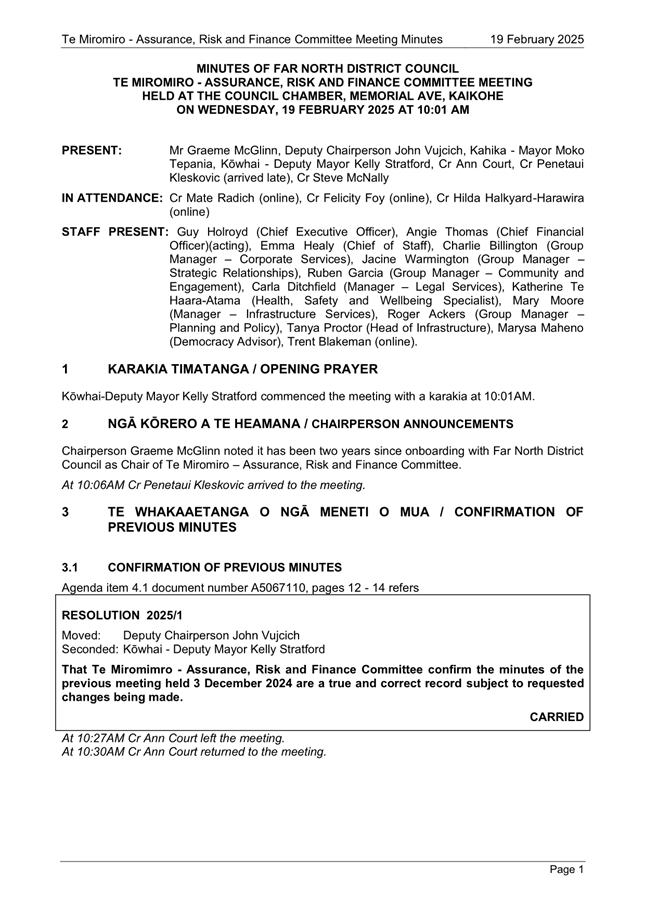
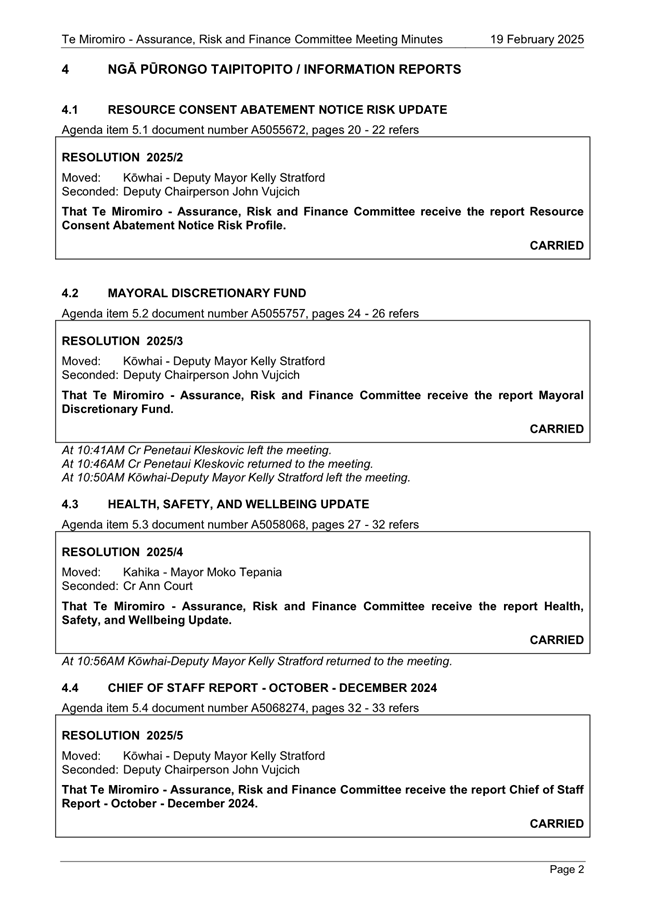
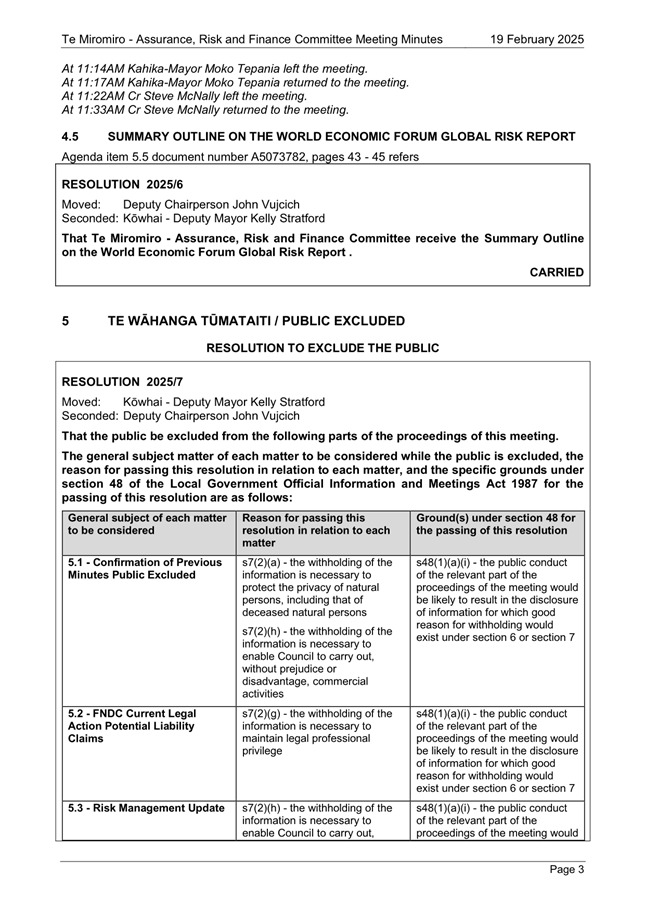

|
Ordinary Council
Meeting Agenda
|
13 March 2025
|
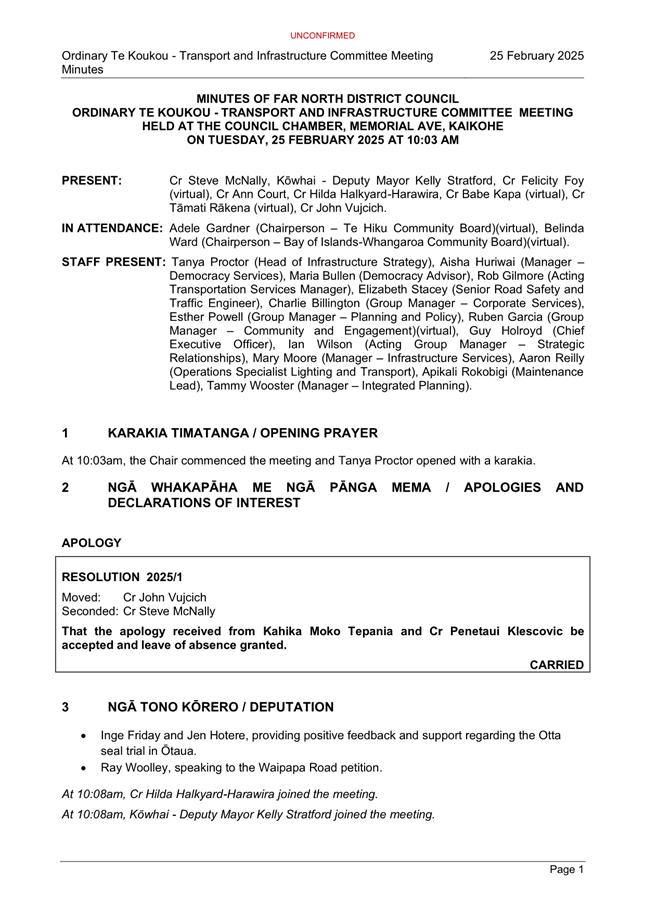

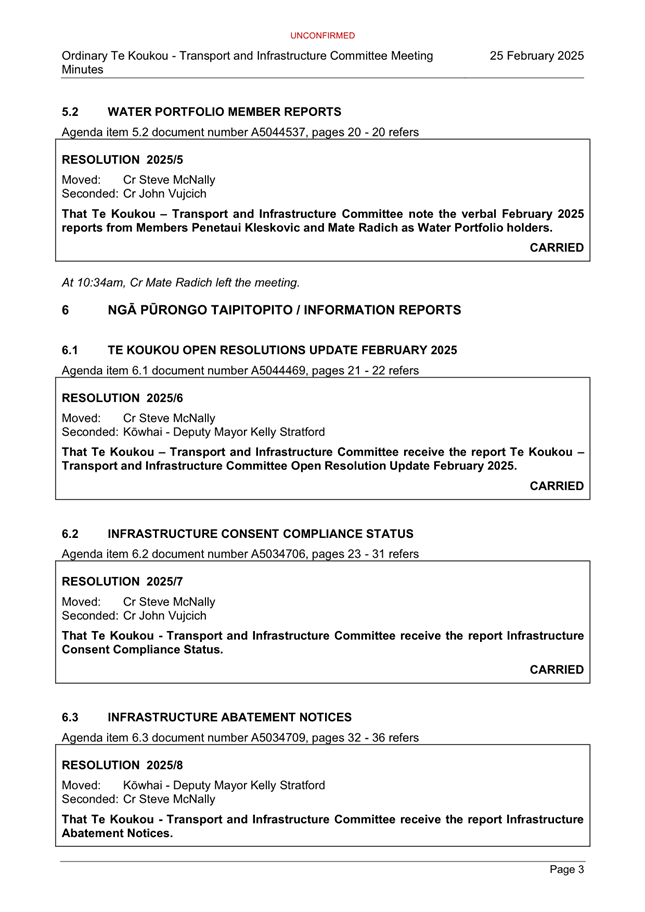
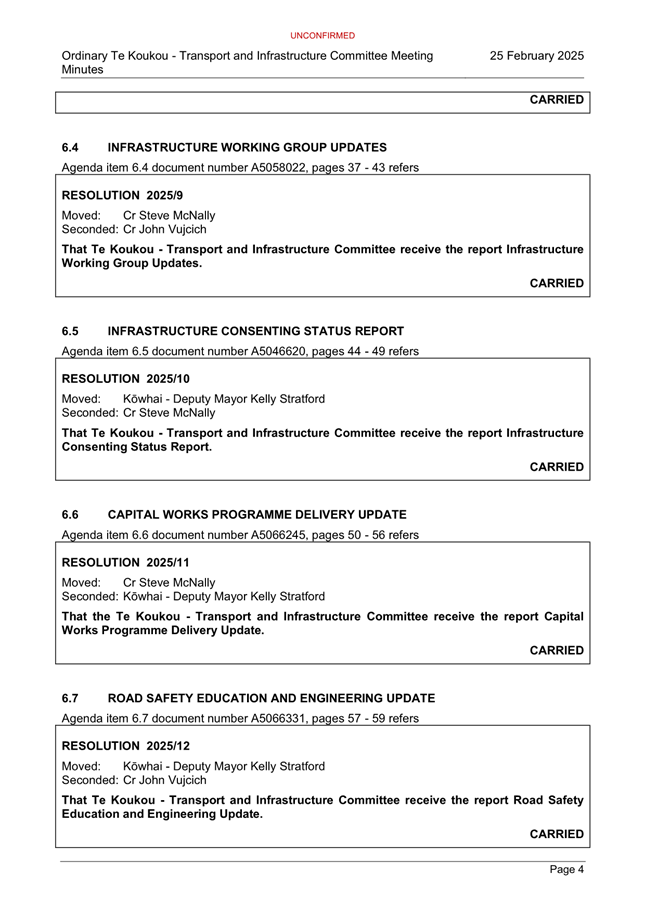
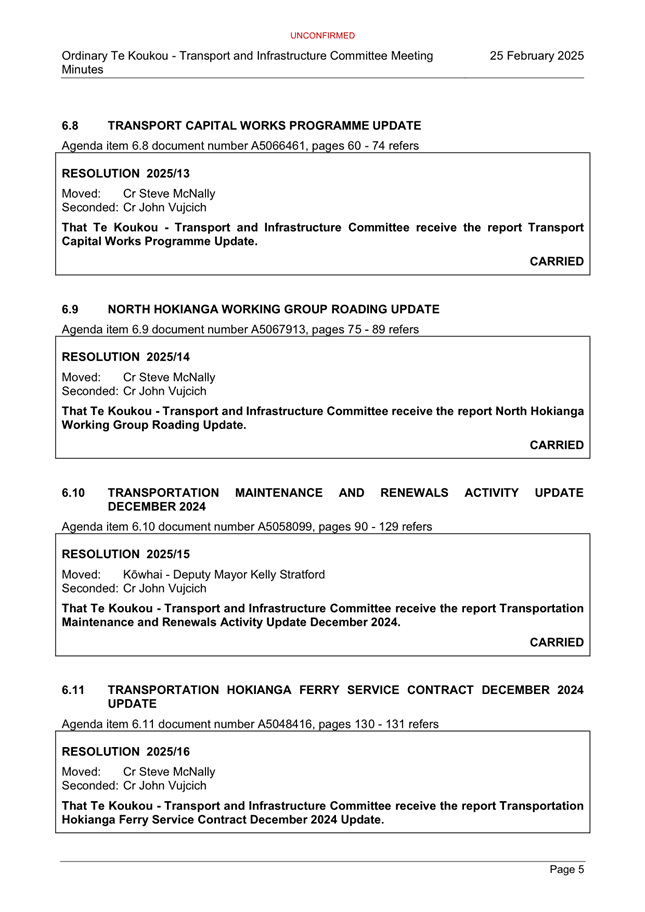
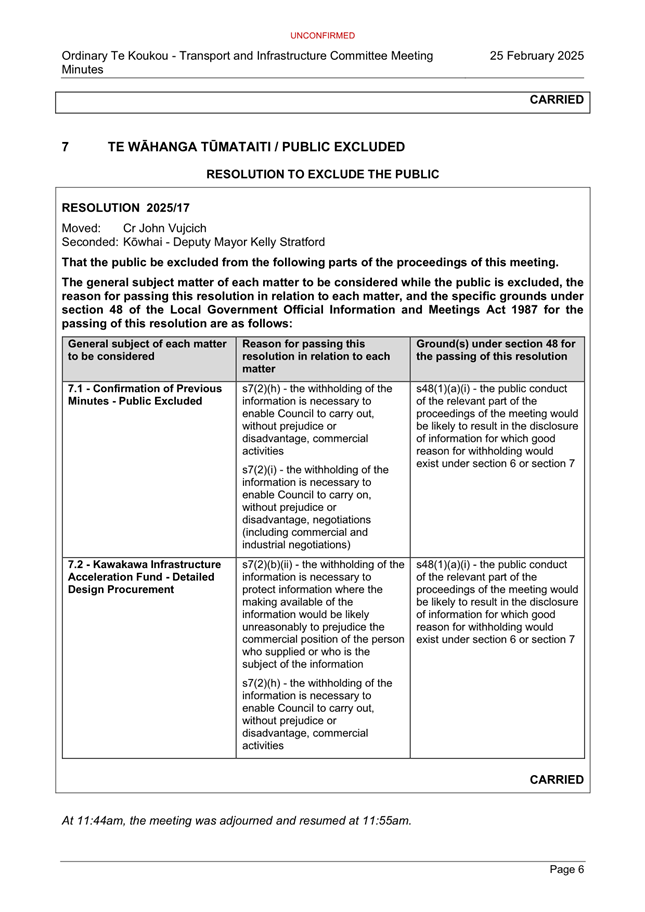
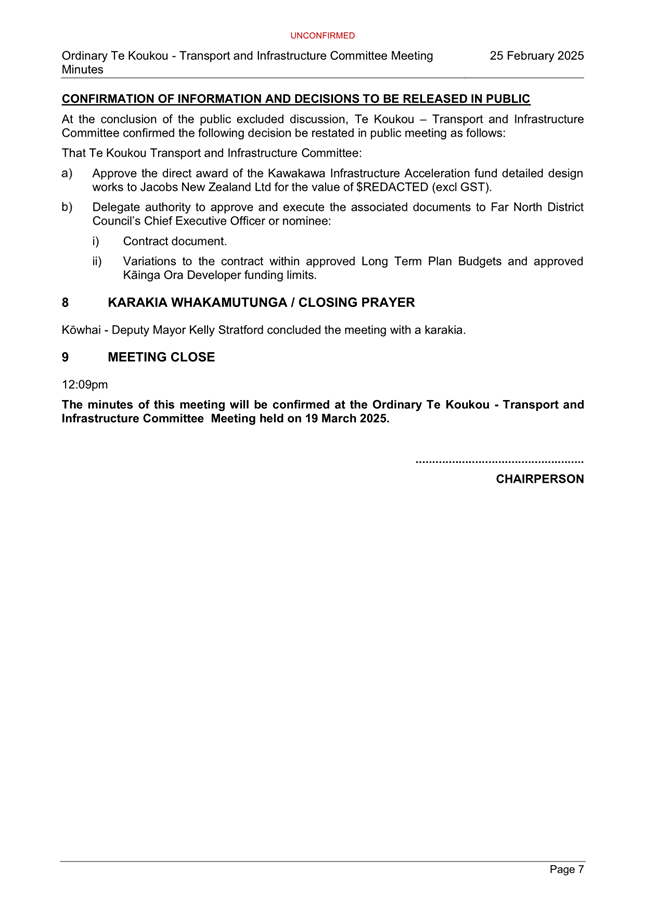
|
Ordinary Council
Meeting Agenda
|
13 March 2025
|
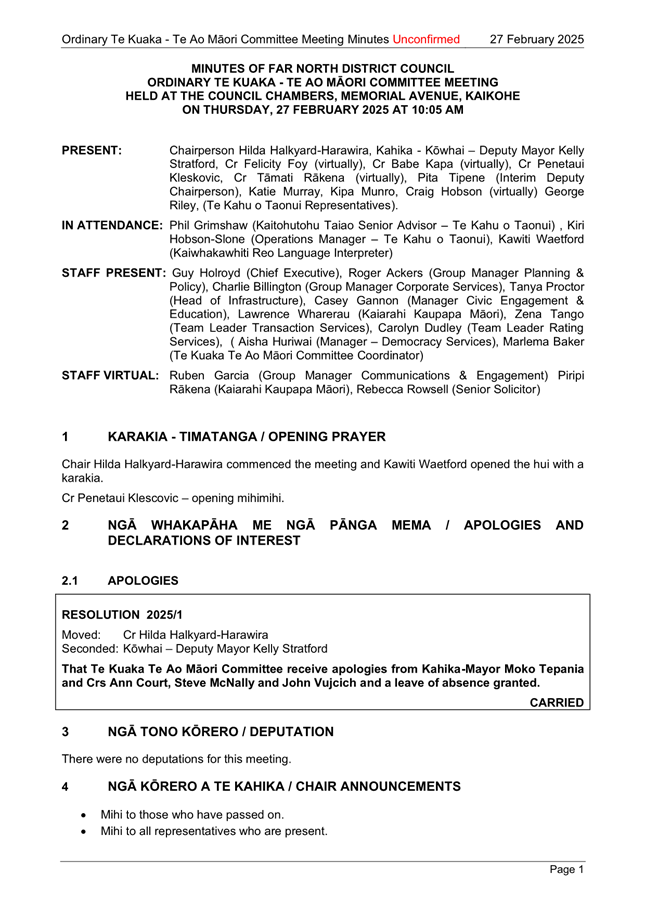
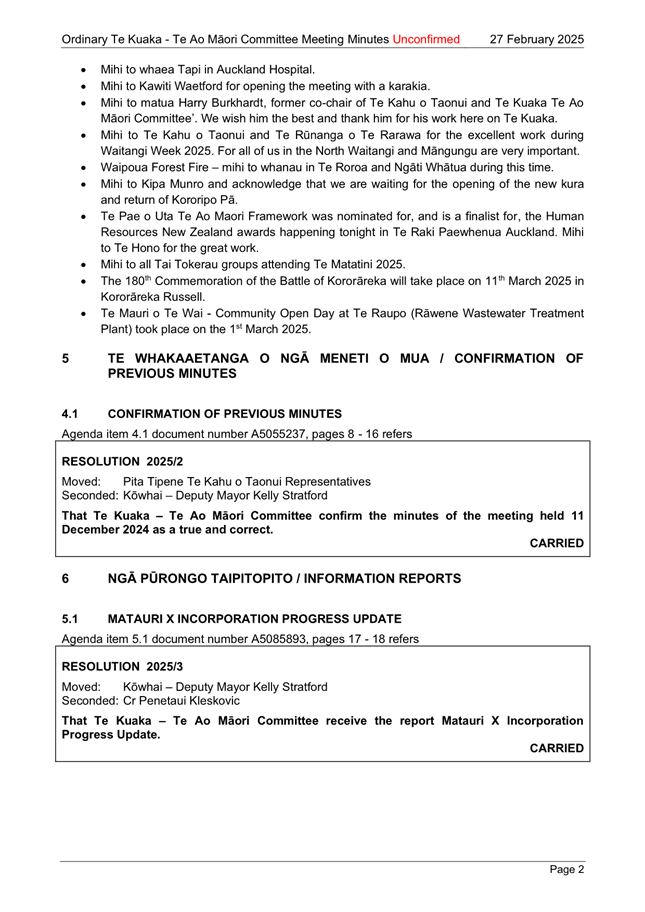

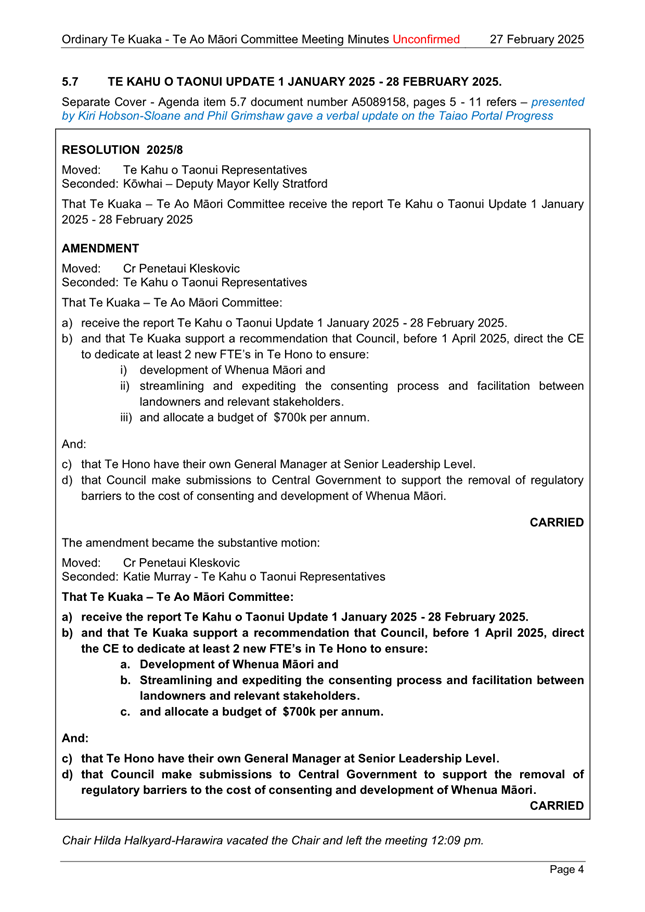
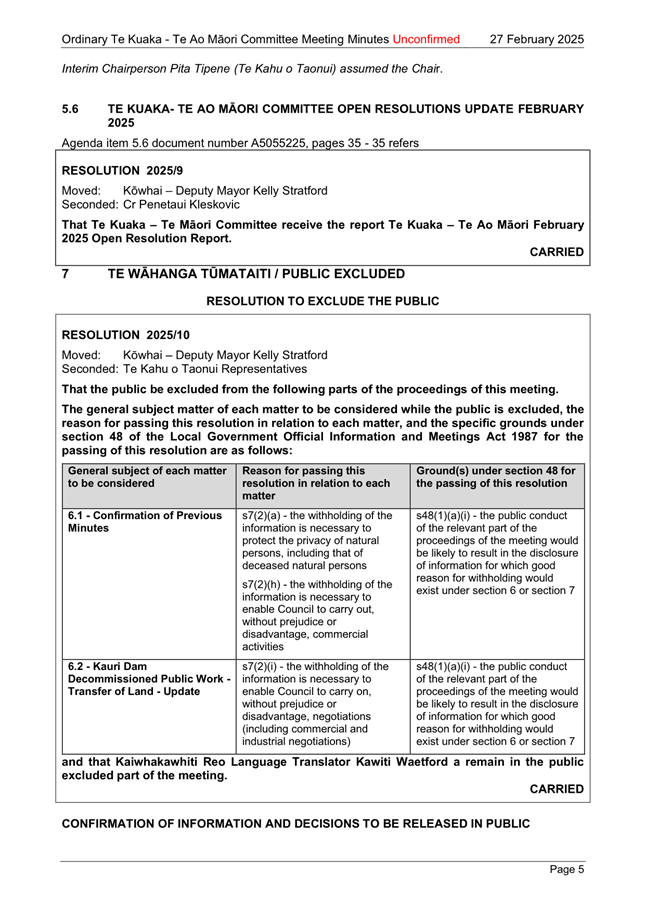
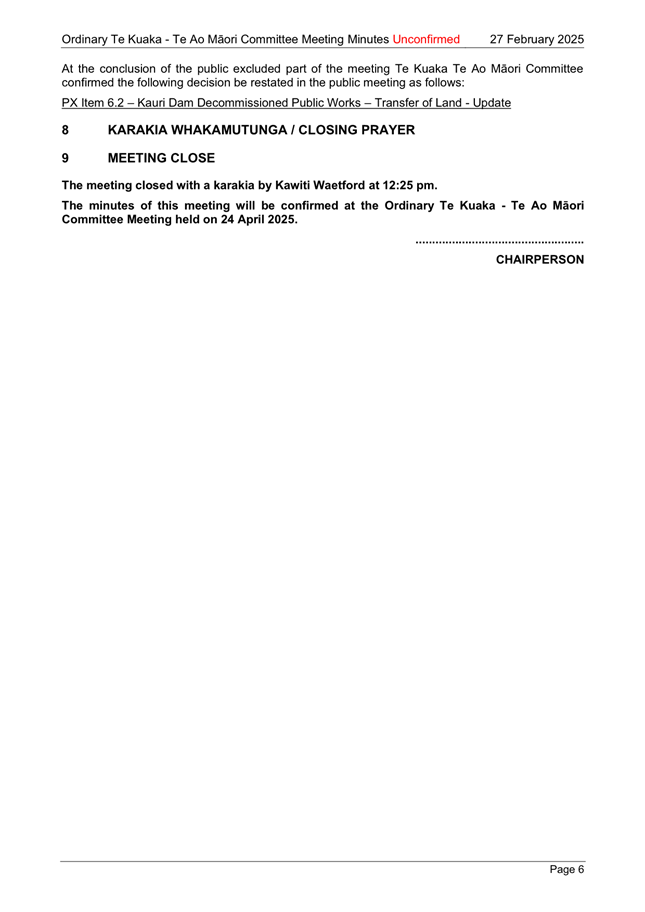
6.4 Te
Kuaka Terms of Reference Update
File Number: A5098522
Author: Marlema
Baker, Democracy Advisor
Authoriser: Aisha
Huriwai, Manager - Democracy Services
Take Pūrongo / Purpose of the Report
To adopt changes to Te Kuaka Te Ao
Māori Committee (Te Kuaka) terms of reference regarding membership.
WhakarĀpopoto matua / Executive Summary
· Council appointed Harry Burkhardt as the
Chair of Te Kuaka Te Ao Māori Committee who has since resigned.
· Council has also signed a Memorandum of
Understanding (MOU) with hapu Ngāti Rehia.
· Te Kuaka was created with our iwi/hapu
partners to bring a Te Ao Māori lens to Council.
·
|
tŪtohunga
/ Recommendation
That Council adopt the following changes to the Terms
of Reference:
a) Add
that the Committee must appoint an iwi/hapu member as Chairperson or Deputy
Chairperson.
b) to
add a seat at the table for a hapu representative with a signed Memorandum of
Understanding with Council.
|
1) TĀhuhu kŌrero / Background
Council adopted a terms of
reference for Te Kuaka – Te Ao Māori Committee on 29 June 2023.
The purpose of Te Kuaka Committee
is to strengthen a Te Ao Māori perspective within Council decision-making
across policies and strategies.
To help add value to the
relationship Harry Burkhardt, who held the role of Co-Chair of Te Kahu o
Taonui, was appointed the Chairperson of Te Kuaka – Te Ao Māori
Committee. In December 2024 he resigned from Te Kahu o Taonui and as a result
could not continue as Chairperson of Te Kuaka. The new Co-Chair for Te Kahu o
Taonui, Mr Aperahama Edwards, is also the Chairperson of Ngati Wai. The
interests of Ngati Wai are in the Whangarei area, outside the scope of activity
for Far North.
Currently Cr Hilda
Halkyard-Harawira, is appointed as Deputy Chairperson.
In addition, on the 11 December
2024 Council signed Te Aro Manatū MOU with Ngāti Rehia. During
discussions a comment was made that in order to add value to the partnership it
would also be great to have Ngāti Rehia, as a hapū, represented at Te
Kuaka – Te Ao Māori Committee.
2) matapaki me NgĀ KŌwhiringa /
Discussion and Options
This report proposes changes to Te
Kuaka – Te Ao Māori Committee terms of reference.
· That
an iwi or hapu representative must be appointed as either Chairperson or Deputy
Chairperson of Te Kuaka – Te Ao Māori Committee
· That a
hapū with a signed MoU with Council, will have representation (with voting
rights) on Council’s Te Kuaka Te Ao Māori Committee. (currently
Ngāti Rehia and potentially Te Whiu)
TAKE TŪTOHUNGA
/ REASON FOR THE RECOMMENDATION
To confirm changes to the terms of
reference in alignment with the original intent of valuing the contribution
that our iwi/hapu partners can bring to the Council decision-making table.
3) PĀnga PŪtea me ngĀ
wĀhanga tahua / Financial Implications and Budgetary Provision
Council recognises that non-elected
members appointed to Committees may incur personal expense to participate.
Council has an Appointed Members Allowance Policy to ensure that non-elected
members can be remunerated and are eligible for reasonable reimbursements to
ensure they are not incurring personal expense.
Operational budget is allocated to
ensure there is sufficient provision for this each year should Council decide
to make external appointments.
Āpitihanga
/ Attachments
1. Te
Kuaka Terms of Reference - A5104593 ⇩ 
2. Resignation
of Harry Burkhardt as Te Kahu o Taonui Co-Chair - A5095452 ⇩ 
Hōtaka Take Ōkawa / Compliance Schedule:
Full consideration has been given to the provisions of the
Local Government Act 2002 S77 in relation to decision making, in particular:
1. A
Local authority must, in the course of the decision-making process,
a) Seek
to identify all reasonably practicable options for the achievement of the objective
of a decision; and
b) Assess
the options in terms of their advantages and disadvantages; and
c) If
any of the options identified under paragraph (a) involves a significant
decision in relation to land or a body of water, take into account the
relationship of Māori and their culture and traditions with their
ancestral land, water sites, waahi tapu, valued flora and fauna and other
taonga.
2. This
section is subject to Section 79 - Compliance with procedures in relation to
decisions.
|
He Take Ōkawa /
Compliance Requirement
|
Aromatawai Kaimahi /
Staff Assessment
|
|
State the level of significance (high or low) of the
issue or proposal as determined by the Council’s
Significance and Engagement Policy
|
This is a matter of low significance.
|
|
State the relevant Council policies (external or
internal), legislation, and/or community outcomes (as stated in the LTP) that
relate to this decision.
|
This report seeks to enable Council to continue
strengthening relationships with iwi and hapu in support of Council’s
Long Term Plan and Te Pae o Uta.
This report also seeks to better enable iwi and hapu to
engage in Council’s decision-making in accordance with the Local
Government Act.
|
|
State whether this issue or proposal has a District wide
relevance and, if not, the ways in which the appropriate Community
Board’s views have been sought.
|
The views of the Community Board have not been sought.
|
|
State the
possible implications for Māori and how Māori have been provided
with an opportunity to contribute to decision making if this decision is
significant and relates to land and/or any body of water.
State the
possible implications and how this report aligns with Te Tiriti o Waitangi /
The Treaty of Waitangi.
|
This report seeks to better build Council’s
relationships with iwi and hapu and provide iwi and hapu with more
opportunities to contribute to decision making in accordance with Te Kuaka Te
Ao Māori Committee’s terms of reference.
|
|
Identify persons likely to be affected by or have an
interest in the matter, and how you have given consideration to their views
or preferences (for example – youth, the aged and those with
disabilities).
|
Te Kahu o Taonui and Ngati Rehia have been included in
communications to date.
|
|
State the financial implications and where budgetary
provisions have been made to support this decision.
|
Staff are confident that there is sufficient budget to
support this decision.
|
|
Chief Financial Officer review.
|
The Chief Financial Officer has not reviewed this
report.
|
|
Ordinary
Council Meeting Agenda
|
13 March 2025
|
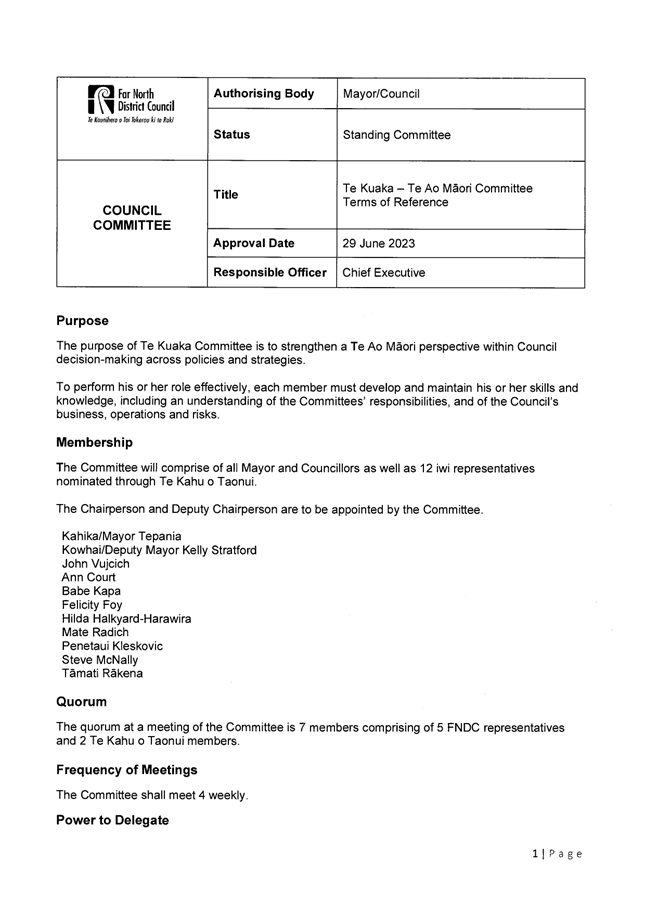
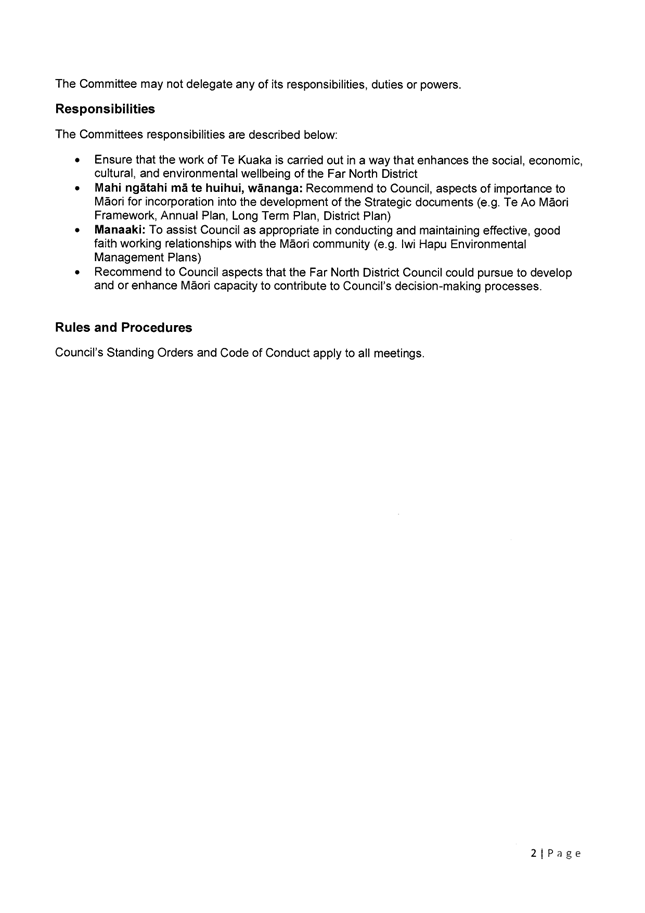
|
Ordinary Council
Meeting Agenda
|
13 March 2025
|
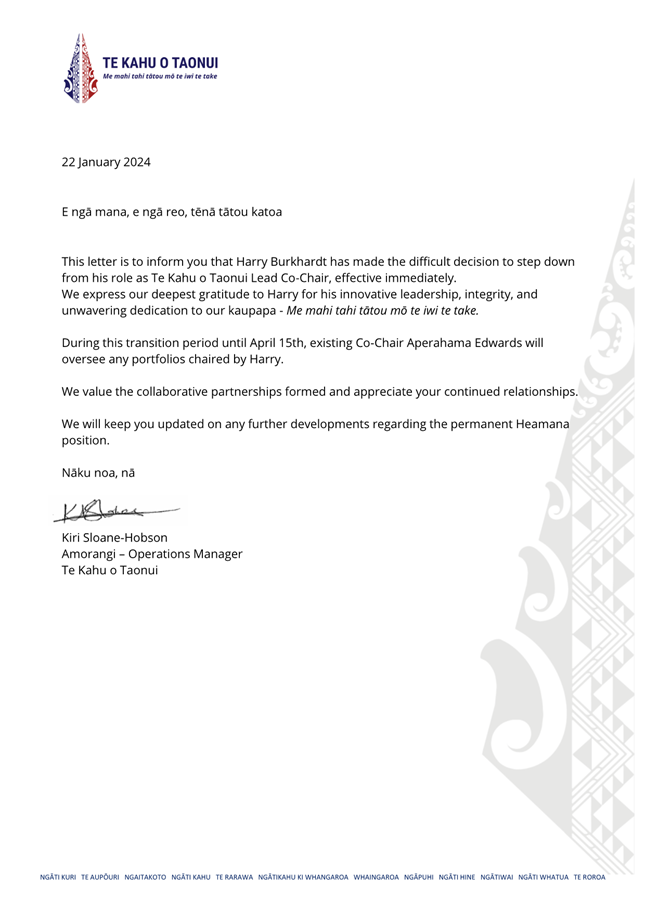
6.5 2025
Triennial Elections - Order of Candidate Names on Voting Documents
File
Number: A5102426
Author: Casey
Gannon, Manager - Civic Engagement and Education
Authoriser: Ian
Wilson, Acting Group Manager - Strategic Relationships
Purpose of the Report
Seek approval to retain the status quo of alphabetical names
of candidates on voting documents for the 2025 triennial elections.
Executive Summary
· Regulation 31 of the Local Electoral Regulations 2001 provides the
opportunity for Council to choose the order of candidate names appearing on the
voting documents.
· There are three options - alphabetical, pseudo-random (names drawn
out of a hat in random with all voting documents printed in this order) or
random order (names randomly drawn by computer with each voting document
different).
· Alphabetical order has been the adopted option for previous
elections.
|
tŪtohunga
/ Recommendation
That Council adopt the alphabetical order of candidate
names, as permitted under Regulation 31 of the Local Electoral Regulations
2001, for the 2025 triennial elections.
|
1) Background
Triennial elections will be held on Saturday 11 October
2025.
Regulation 31 of the Local Electoral Regulations 2001
provides the opportunity for Council to choose the order of candidate names
appearing on the voting documents from three options - alphabetical,
pseudo-random (names drawn out of a hat in random with all voting documents
printed in this order) or random order (names randomly drawn by computer with
each voting document different).
The decision on the order of candidate names must be made in
early 2025 to enable printing of voting documents. If no decision is
made, the order of names defaults to alphabetical.
2) Discussion and Options
Council may determine which order the names of candidates are
to appear on the voting documents.
Council has previously resolved to adopt alphabetical order
for triennial elections.
Option 1 - Alphabetical Order
Alphabetical order is simply listing candidate names
alphabetically and is the order traditionally used in local authority and
parliamentary elections.
Comments regarding alphabetical order are:
· voters are easily
able to find candidate names for whom they wish to vote for. Some
candidates and voters over the years have argued that alphabetical order of
candidate names may tend to favour those candidates with names in the first
part of the alphabet, but in practice this is generally not the case - most
voters tend to look for name recognition, regardless of where in the alphabet
the name lies;
· the order of
candidates on the voting document matches the order of candidates listed in the
candidate directory (candidate profile statements).
This is the preferred option as voters are
familiar with the concept of alphabetical order on voting documents.
Option 2 - Pseudo-Random Order
Pseudo-random order is where candidate names are randomly
selected and the order selected is the order appearing on all voting documents
relevant to that issue. The names are randomly selected by a method such
as drawing names out of a hat.
Comments regarding pseudo-random order are:
· the candidate
names appear in mixed order (not alphabetical) on the voting document;
· possible voter
criticism/confusion as specific candidate names are not easily found,
particularly where there are a large number of candidates;
· the order of
candidates on the voting document does not match the candidates listed in the
candidate directory (candidate profile statements) which is alphabetical.
Option 3 - Random Order
Random order is where all candidate names are randomly
selected and the order of names is different on every voting document.
The names are randomly selected by computer so that the order of names is
different on each voting document.
The random order enables names to be placed on each issue in a
completely unique order on each voting document.
Comments regarding random order are:
· the candidate
names appear in mixed order (not alphabetical) on the voting document;
· possible voter
criticism/confusion as specific candidate names are not easily found,
particularly where there are a large number of candidates;
· the order of
candidates on the voting document does not match the candidates listed in the
candidate directory (candidate profile statements) which is alphabetical.
Reason
for the recommendation
To allow Council to choose the
preferred method of listing the names of candidates on the voting documents, as
provided for under Regulation 31 of the Local Electoral Regulations 2001, for
the 2025 triennial elections.
3) Financial Implications and Budgetary
Provision
There is no price differential in
printing costs between the three orders of candidate name options. The
cost of the election is provided for in existing budgets.
Attachments
1. Far
North District Council 2025 LG Elections - Electoral Officer Order of Names
Report Feb 2025 - A5102536 ⇩ 
Compliance schedule:
Full consideration has been given to the provisions of the
Local Government Act 2002 S77 in relation to decision making, in particular:
1. A
Local authority must, in the course of the decision-making process,
a) Seek
to identify all reasonably practicable options for the achievement of the
objective of a decision; and
b) Assess
the options in terms of their advantages and disadvantages; and
c) If
any of the options identified under paragraph (a) involves a significant
decision in relation to land or a body of water, take into account the
relationship of Māori and their culture and traditions with their
ancestral land, water sites, waahi tapu, valued flora and fauna and other
taonga.
2. This
section is subject to Section 79 - Compliance with procedures in relation to
decisions.
|
Compliance
requirement
|
Staff
assessment
|
|
State the level of significance
(high or low) of the issue or proposal as determined by the Council’s
Significance and Engagement Policy
|
Low degree of significance. The
order of candidate names on voting documents does not meet the threshold of
high significance under the policy.
|
|
State the relevant Council
policies (external or internal), legislation, and/or community outcomes (as
stated in the LTP) that relate to this decision.
|
There is no Council policy on the
matter of local government elections. Councils requirements are bound by the
Local Electoral Act 2001 and the Local Electoral Regulations 2001.
|
|
State whether this issue or
proposal has a District wide relevance and, if not, the ways in which the
appropriate Community Board’s views have been sought.
|
District wide relevance –
however, elections are bound by NZ legislation and affect every voter within
New Zealand.
|
|
State the possible implications for Māori
and how Māori have been provided with an opportunity to contribute to
decision making if this decision is significant and relates to land and/or
any body of water.
|
There are no specific
implications for Māori beyond those applicable to any voters within the
Far North District.
|
|
Identify persons likely to be
affected by or have an interest in the matter, and how you have given
consideration to their views or preferences.
|
There are no identified persons
likely to have an interest in the matter.
|
|
State the financial implications
and where budgetary provisions have been made to support this decision.
|
Budget has been allocated for
this triennial, legislated requirement.
|
|
Chief Financial Officer review.
|
The Chief Financial Officer has
not reviewed this report.
|
|
Ordinary
Council Meeting Agenda
|
13 March 2025
|
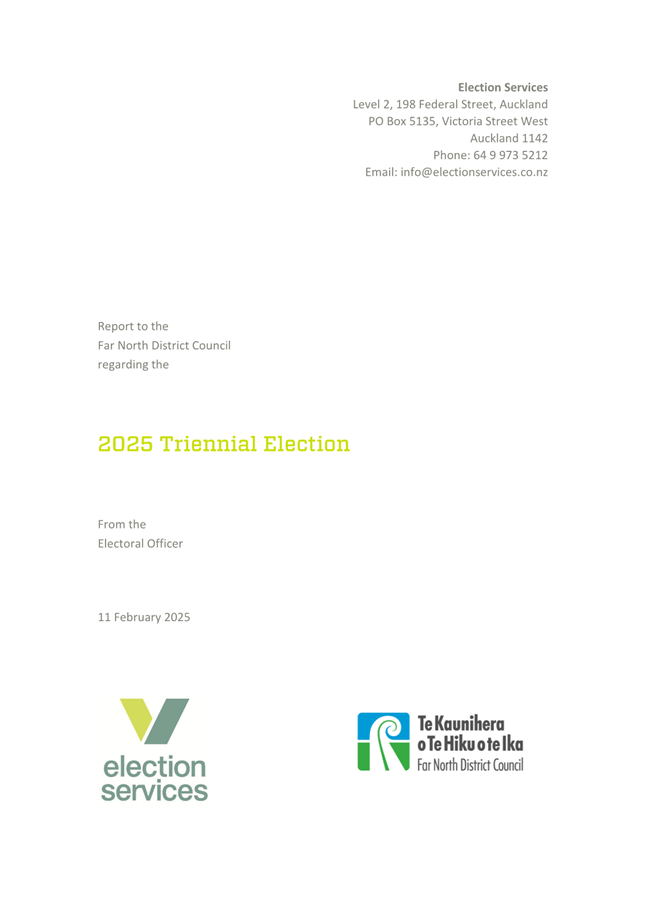

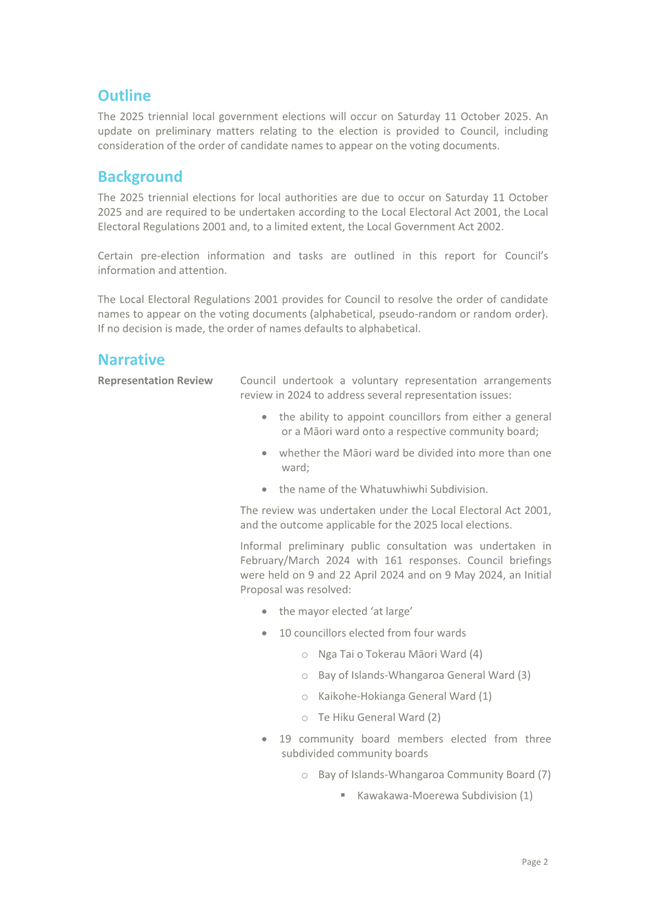
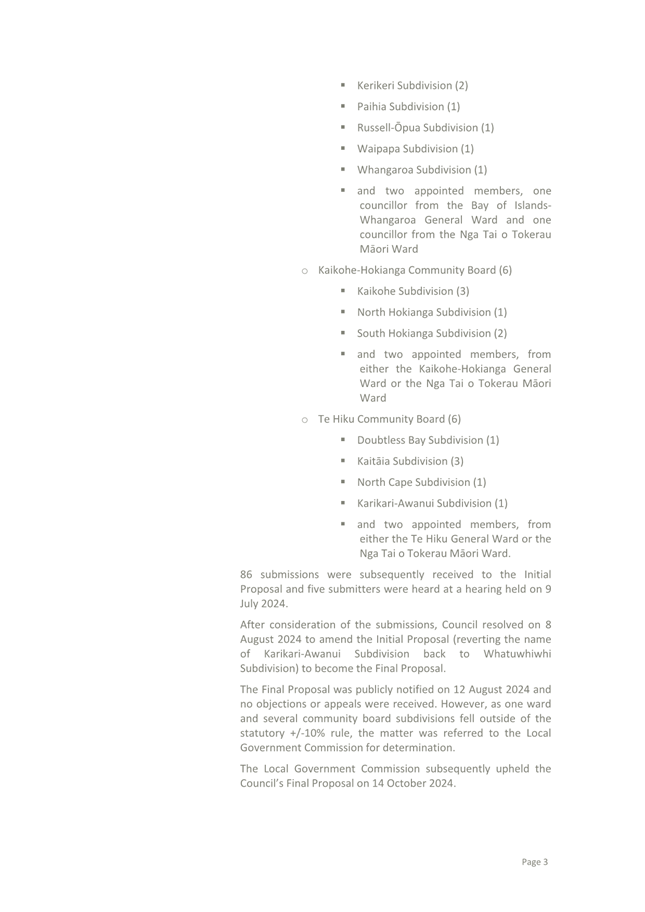
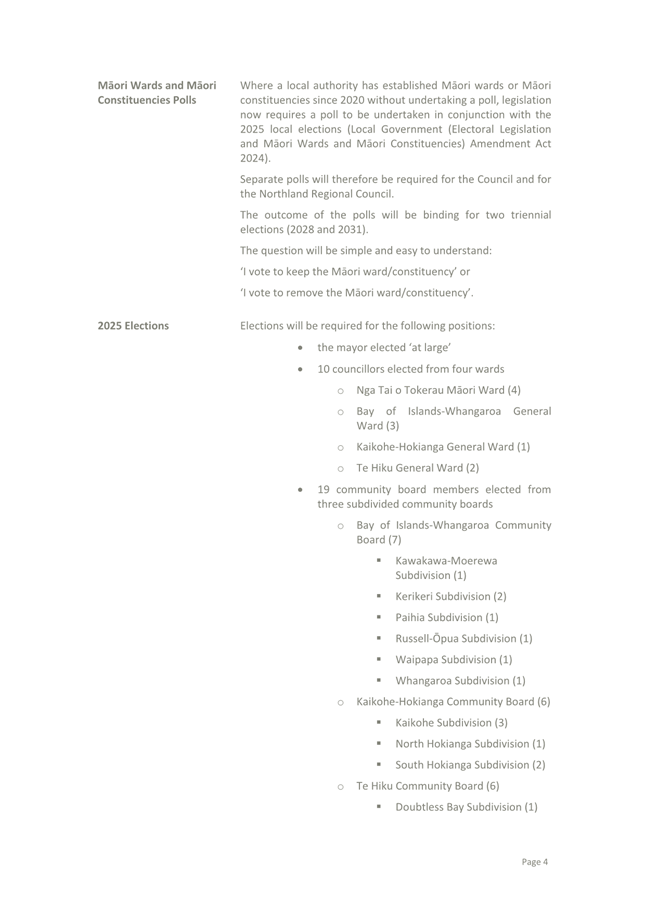
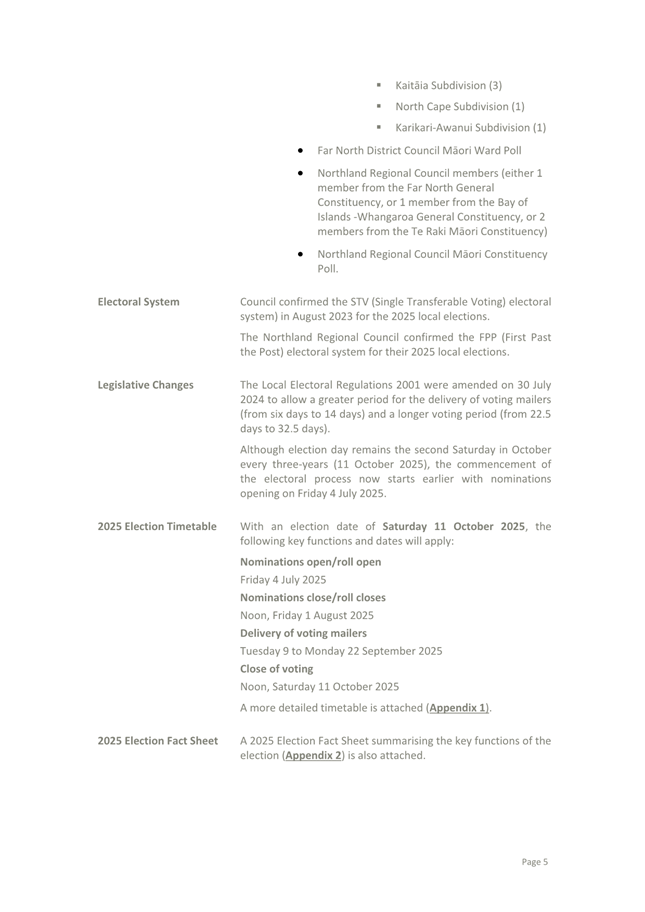

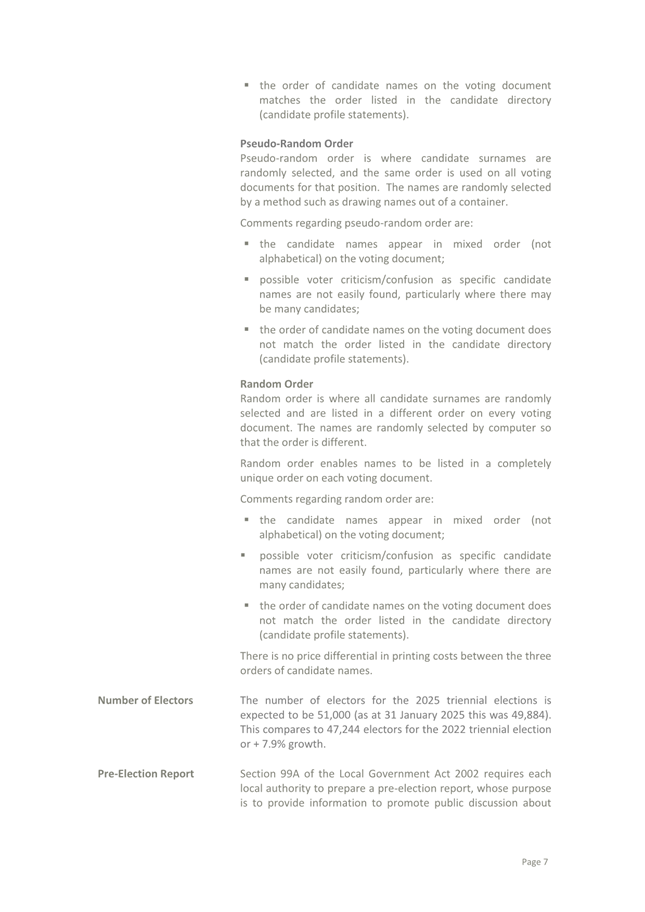
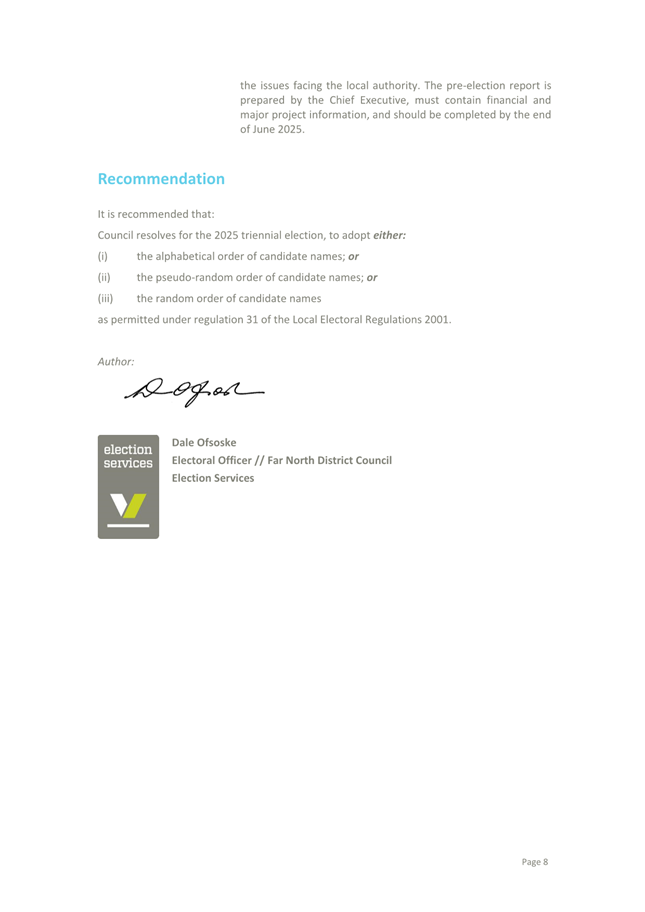
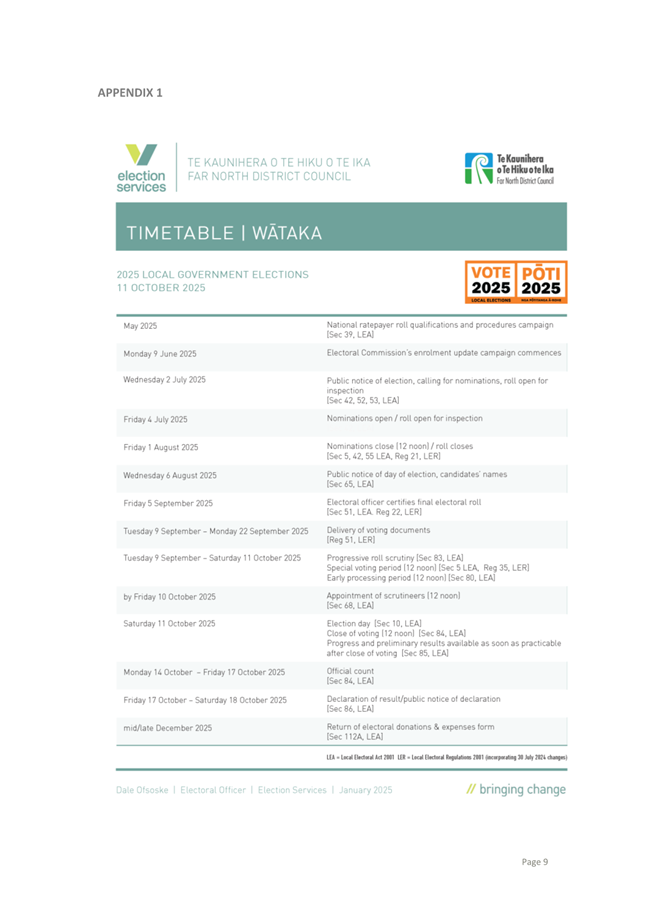
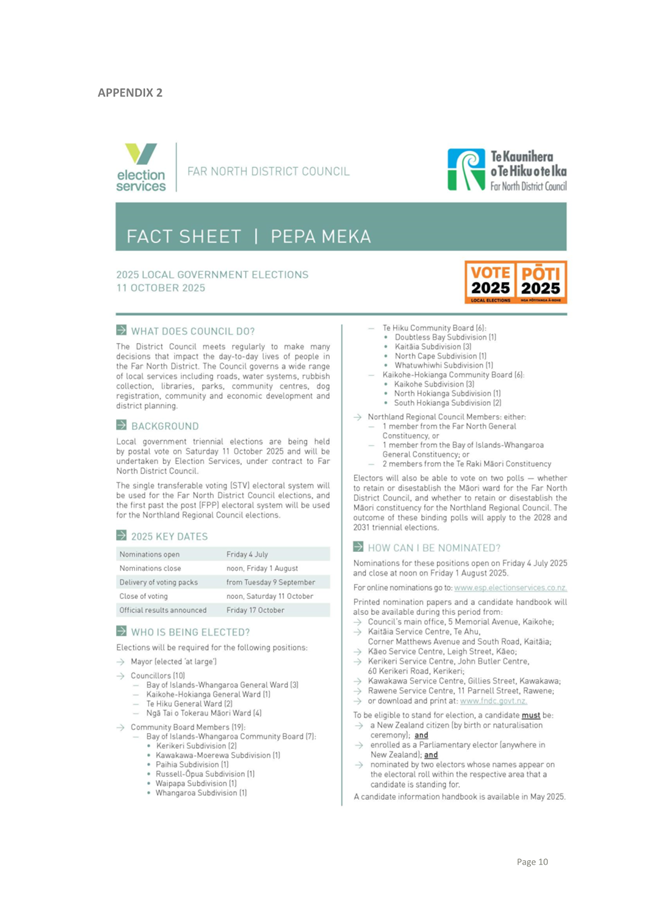
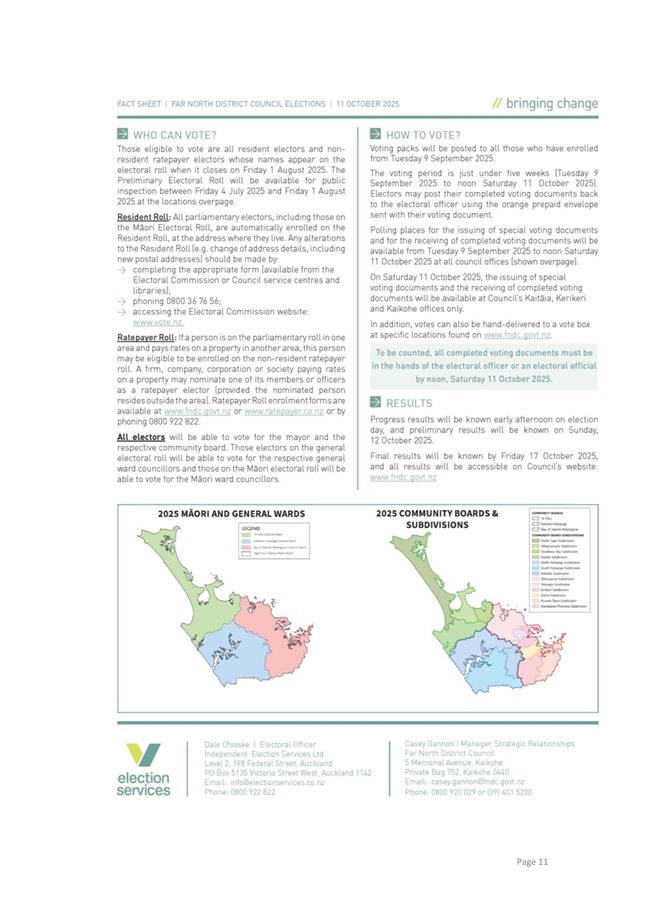
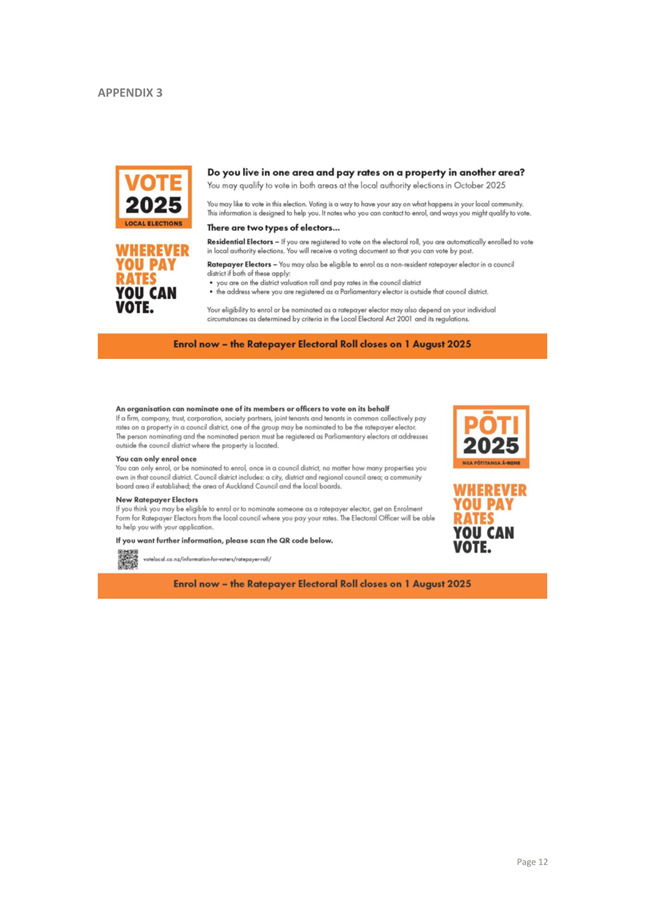
6.6 Insulation
requirements in housing and other buildings - Letter to Hon Chris Penk
File
Number: A5104708
Author: Steve
Rylands, Senior Policy Advisor
Authoriser: Roger
Ackers, Group Manager - Planning & Policy
Take Pūrongo / Purpose of the Report
To seek approval of a letter from Council to the Minister
for Building and Construction.
WhakarĀpopoto matua / Executive Summary
· The letter requests that the Minister direct MBIE to investigate:
o the establishment of a separate climate zone for the far north for
the purposes of calculating housing insulation and glazing requirements,
reflecting the unique climate of the far north
o changing the regulations that specify the calculation of insulation
requirements for homes with solar and wind energy that are also connected to
the grid so reducing compliance costs.
|
tŪtohunga
/ Recommendation
That Council approve
the letter from the Mayor to Hon Chris Penk, Minister for Building and
Construction.
|
1) TĀhuhu kŌrero / Background
FNDC recently submitted on an MBIE discussion document[1] which sought
feedback on proposed changes to the regulations governing energy efficiency,
insulation and glazing in houses and small buildings. Most of the questions in
the discussion document were technical, and we supported most of the proposed
changes to the regulations.
2) matapaki me NgĀ KŌwhiringa /
Discussion and Options
The
proposals in the letter go well beyond the scope of the FNDC submission to
MBIE. The most important proposal in the letter is that the
Minister direct MBIE officials to investigate the establishment of a separate
climate zone for the far north. In the absence of a letter to the
Minister, and a direction to MBIE, our proposal will not be advanced by the
Government.
Option 1
(Recommended)
Send the
letter to the Minister for Building and Construction.
Option 2
Do not send
the letter to the Minister for Building and Construction.
Option 1 is
recommended because it raises the profile of our proposals. It asks the
Minister to direct MBIE to investigate them.
Option 2
would rely on the submission in response to the discussion document (see
footnote 1). The proposals in the submission do not have the scope or
profile of the proposals in the letter. Importantly, if we rely on the
submission alone, MBIE would have no mandate to investigate a separate climate
zone for the far north.
TAKE TŪTOHUNGA
/ REASON FOR THE RECOMMENDATION
The proposed letter is the most effective way in which
Elected Members can advance these proposals. The letter provides a
heightened profile to the case for change that cannot be achieved through
Option 2.
3) PĀnga PŪtea me ngĀ
wĀhanga tahua / Financial Implications and Budgetary Provision
There are no financial implications.
Āpitihanga
/ Attachments
1. 20250304
- Letter from Council to Hon Chris Penk re Insulation Standards - A5104736 ⇩ 
Hōtaka Take Ōkawa / Compliance Schedule:
Full consideration has been given to the provisions of the
Local Government Act 2002 S77 in relation to decision making, in particular:
1. A
Local authority must, in the course of the decision-making process,
a) Seek
to identify all reasonably practicable options for the achievement of the
objective of a decision; and
b) Assess
the options in terms of their advantages and disadvantages; and
c) If
any of the options identified under paragraph (a) involves a significant
decision in relation to land or a body of water, take into account the
relationship of Māori and their culture and traditions with their
ancestral land, water sites, waahi tapu, valued flora and fauna and other
taonga.
2. This
section is subject to Section 79 - Compliance with procedures in relation to
decisions.
|
He Take Ōkawa /
Compliance Requirement
|
Aromatawai Kaimahi /
Staff Assessment
|
|
State the level of significance (high or low) of the
issue or proposal as determined by the Council’s
Significance and Engagement Policy
|
Low significance
|
|
State the relevant Council policies (external or
internal), legislation, and/or community outcomes (as stated in the LTP) that
relate to this decision.
|
The proposals in the letter are directly relevant to the
Housing Strategy, which is currently in development.
|
|
State whether this issue or proposal has a District wide
relevance and, if not, the ways in which the appropriate Community
Board’s views have been sought.
|
The proposals have district wide relevance. The
views of Community Boards were not sought.
|
|
State the
possible implications for Māori and how Māori have been provided
with an opportunity to contribute to decision making if this decision is
significant and relates to land and/or any body of water.
State the
possible implications and how this report aligns with Te Tiriti o Waitangi /
The Treaty of Waitangi.
|
The decision is not significant and does not relate to
land and/or any body of water. Māori have not been consulted on
the contents of the letter.
Māori will benefit from the proposals. This
is because Māori are disproportionately disadvantaged by the high costs
of building homes.
|
|
Identify persons likely to be affected by or have an
interest in the matter, and how you have given consideration to their views
or preferences (for example – youth, the aged and those with
disabilities).
|
The proposed changes will benefit everyone
|
|
State the financial implications and where budgetary
provisions have been made to support this decision.
|
There are no financial implications for Council.
|
|
Chief Financial Officer review.
|
No applicable.
|
|
Ordinary
Council Meeting Agenda
|
13 March 2025
|
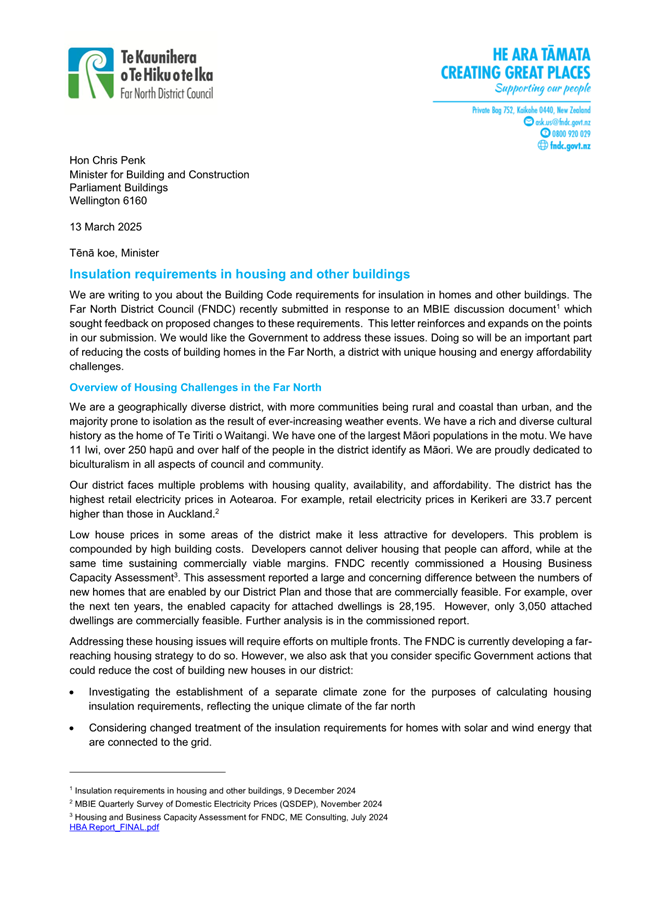
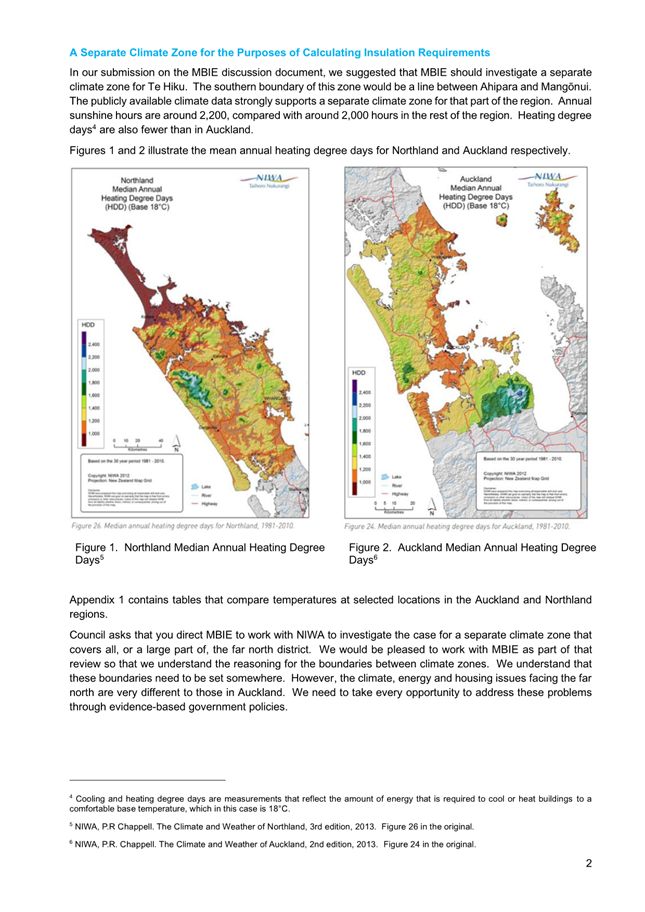
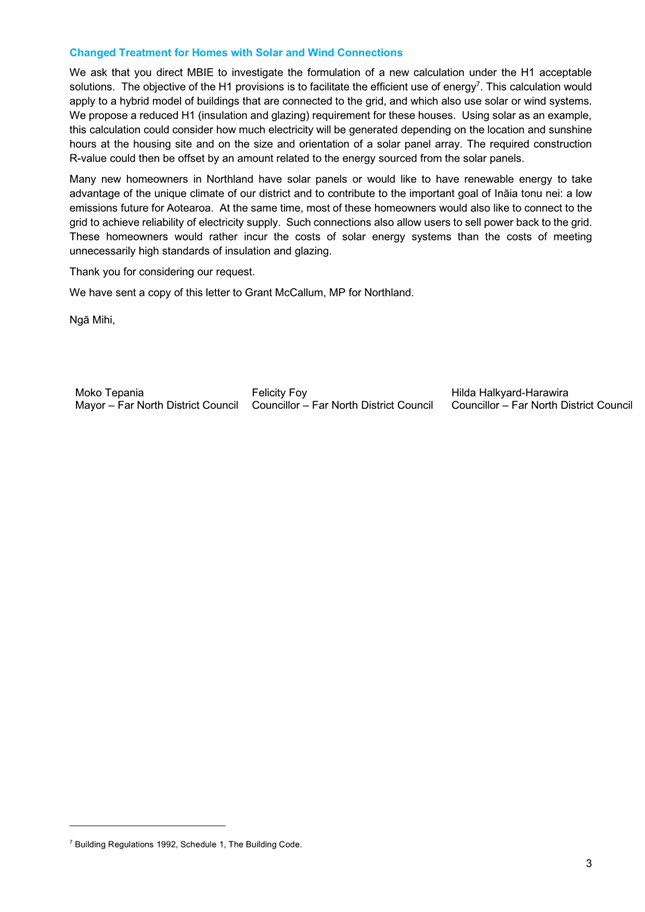
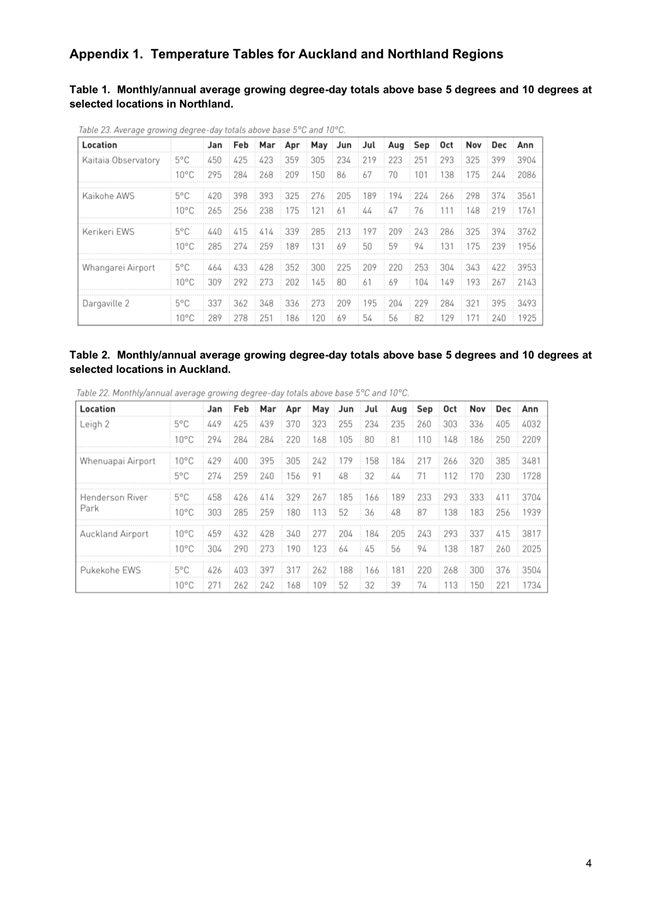
7 Ngā
Pūrongo Taipitopito / Information Reports
7.1 Community
Board Minutes - February 2025
File
Number: A5070102
Author: Maria
Bullen, Democracy Advisor
Authoriser: Aisha
Huriwai, Manager - Democracy Services
TAKE PŪRONGO / Purpose of the Report
To provide an overview of
resolutions made by Community Boards with an opportunity for Chairpersons to
speak with Council about pertinent discussions held at Community Board.
WHAKARĀPOPOTO MATUA / Executive SummarY
Minutes from Te
Hiku, Bay of Islands-Whangaroa and Kaikohe-Hokianga Community Board February
2025 meetings are attached for Council information.
|
TŪTOHUNGA
/ Recommendation
That Council note the following Community Board minutes:
· 18 February
2025 Te Hiku Community Board.
· 20 February
2025 Bay of Islands-Whangaroa Community Board;
· 21 February
2025 Kaikohe-Hokianga Community Board;
|
tĀHUHU KŌRERO / Background
This report is to provide Council with an overview of
resolutions made at Community Board meetings and for Community Board
Chairpersons to raise any Community Board issues with Council.
MATAPAKI ME NGĀ KŌWHIRINGA /
Discussion and Next Steps
This is intended as an information report but shows on the
agenda as a standard report to place it earlier on the agenda.
From time-to-time Community Boards may make recommendations
to Council. This report is not considered to be the appropriate mechanism for
Council to make a decision from a Community Board recommendation. Council could
however move a motion to formally request a report on a particular matter for
formal consideration at a subsequent meeting. The report would then ensure that
Council have sufficient information to satisfy the decision-making requirements
under the Local Government Act 2002 (sections 77-79).
These minutes include recommendations to Council. Staff will
provide separate reports to seek decisions in future of Council for:
· Application for
Easement Over Waipapa Esplanade Reserve
· Application for
Easement and License to Occupy over Russell Esplanade Reserve
· Recommendation for
Vesting of Recreation Reserve (Kaikohe)
· Ground Lease
requests over Kaikohe Landfill
· New Ground Lease
to Kohukohu Bowling Club.
PĀNGA PŪTEA ME NGĀ WĀHANGA
TAHUA / Financial Implications and Budgetary Provision
There are no financial
implications or need for budget provision in considering this report.
Āpitihanga
/ Attachments
1. 2025-02-18
Te Hiku Community Board Minutes - A5076086 ⇩ 
2. 2025-02-20
Bay of Islands-Whangaroa Community Board Minutes - A5086914 ⇩ 
3. 2025-02-21
Kaikohe-Hokianga Community Board Minutes - A5081365 ⇩ 
|
Ordinary
Council Meeting Agenda
|
13 March 2025
|
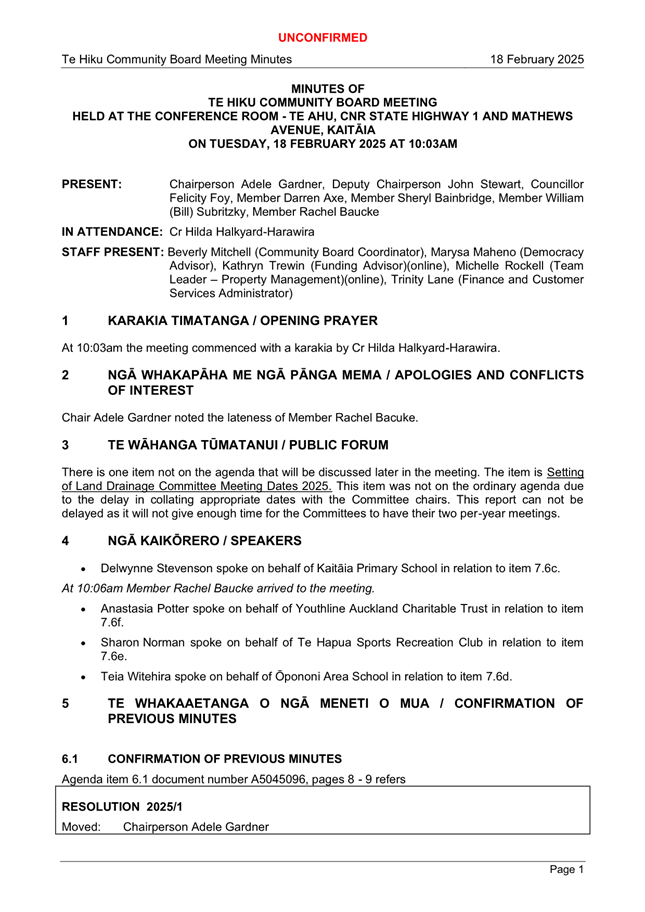
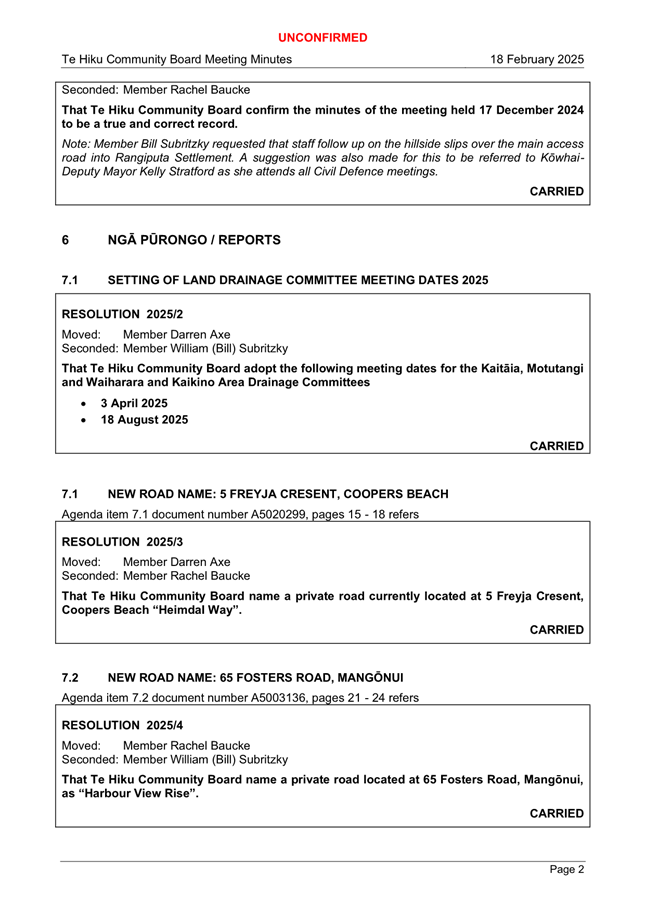
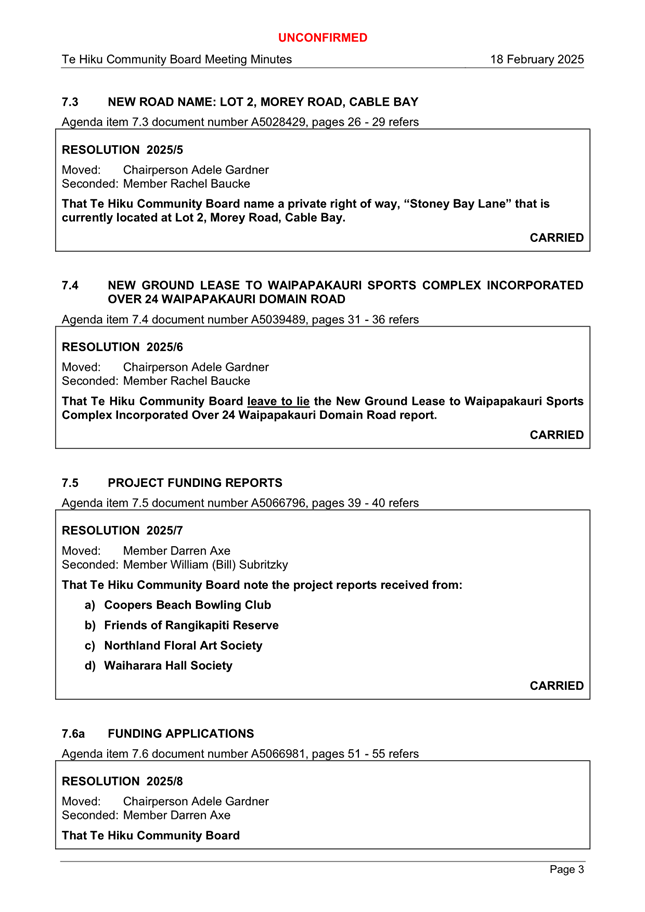
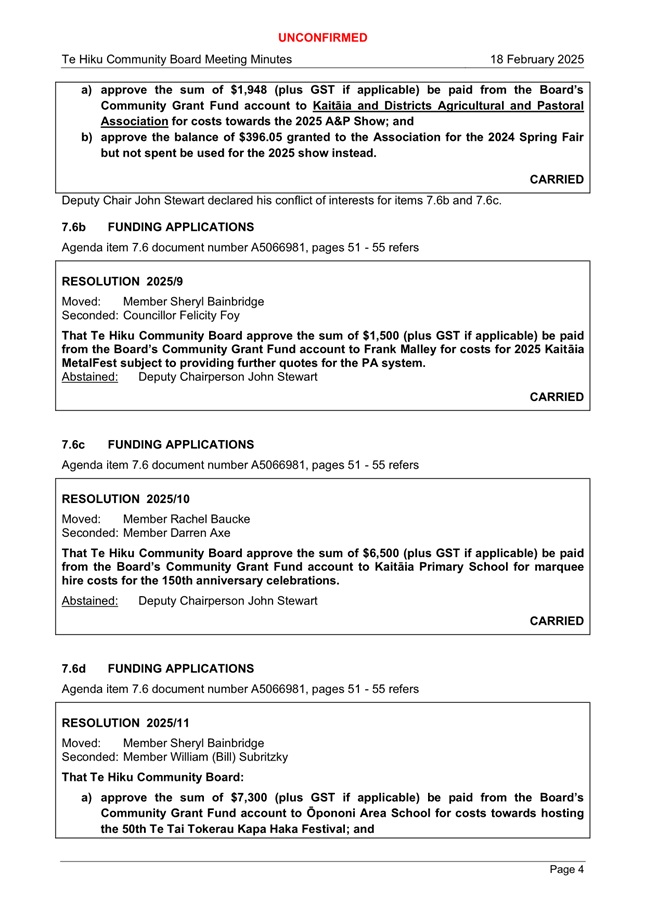


|
Ordinary Council
Meeting Agenda
|
13 March 2025
|
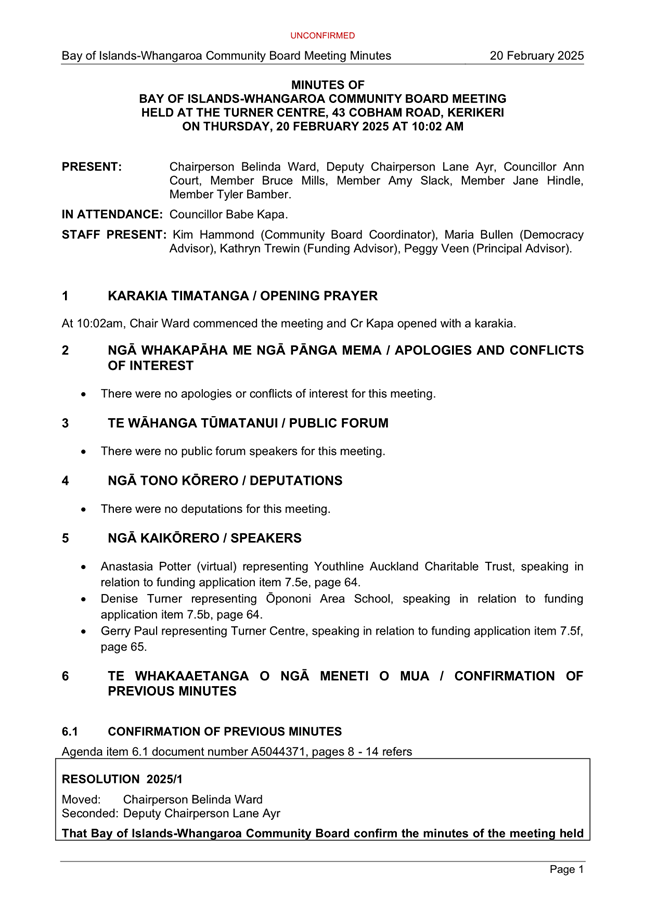
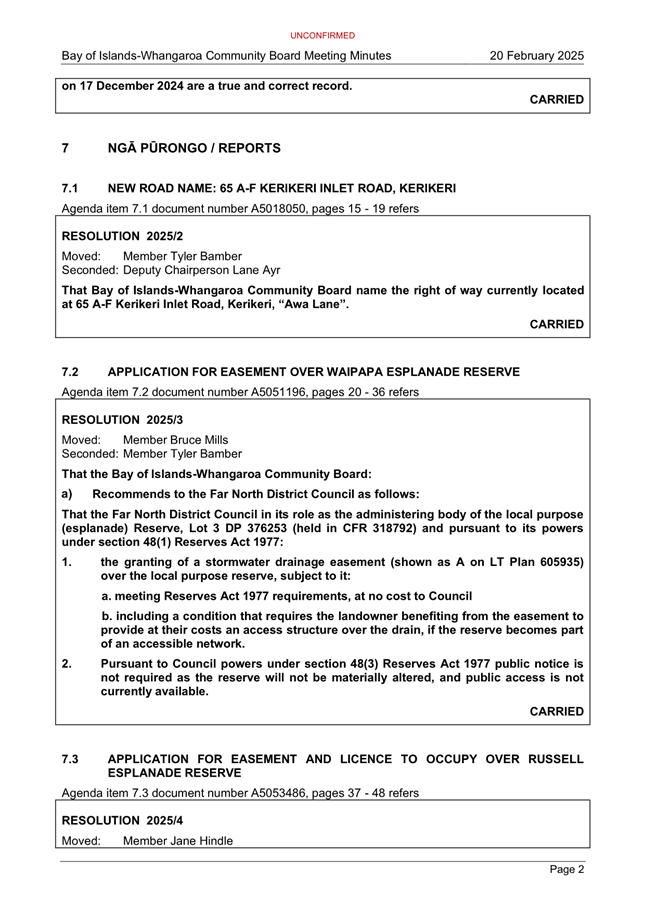
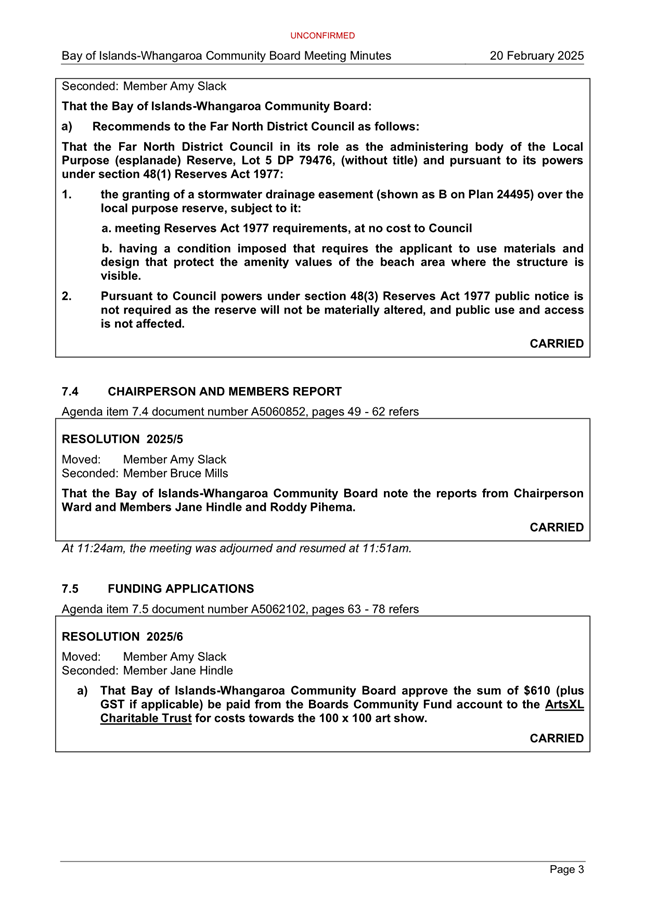
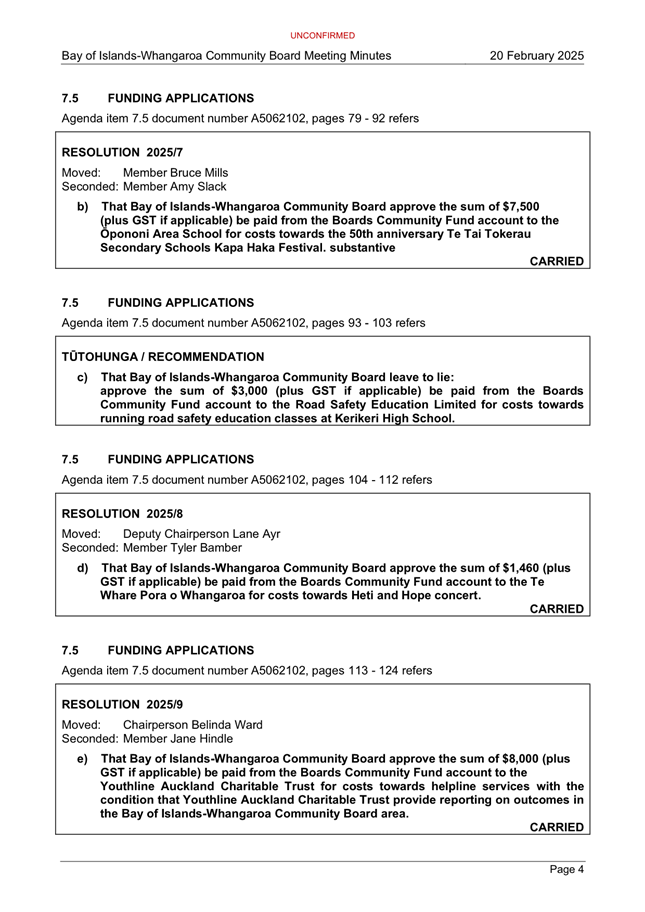
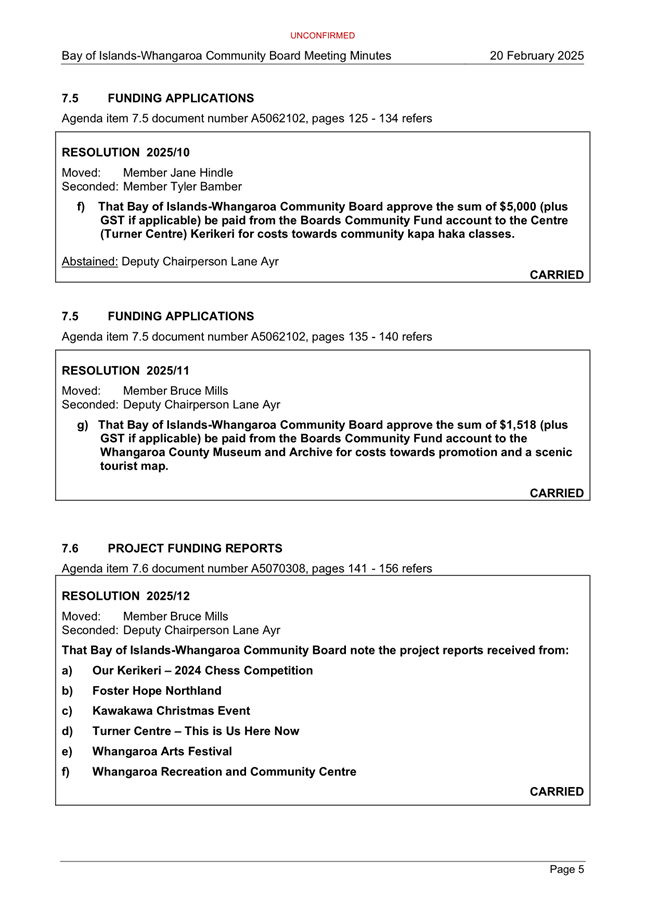
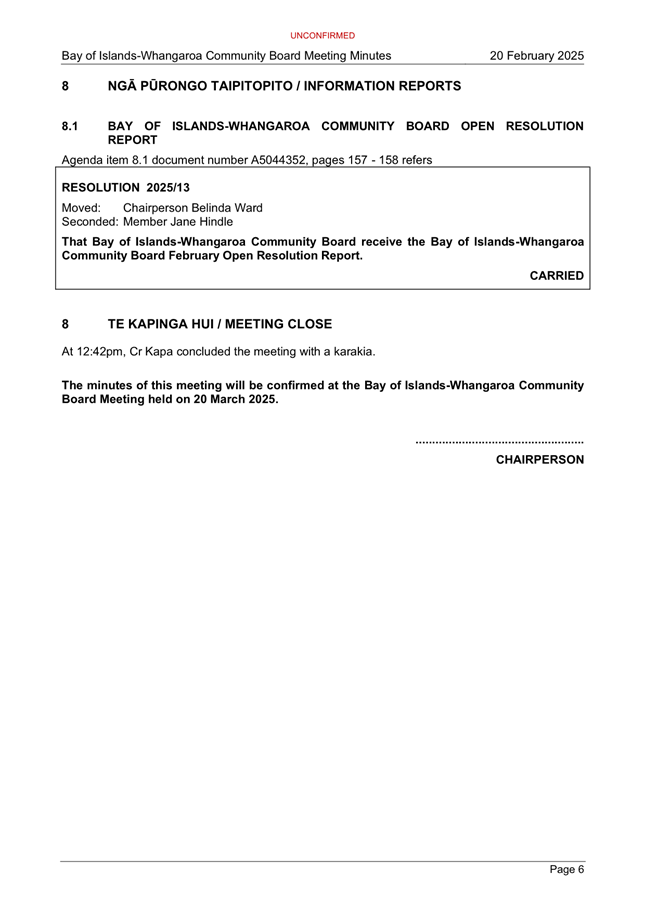
|
Ordinary Council
Meeting Agenda
|
13 March 2025
|
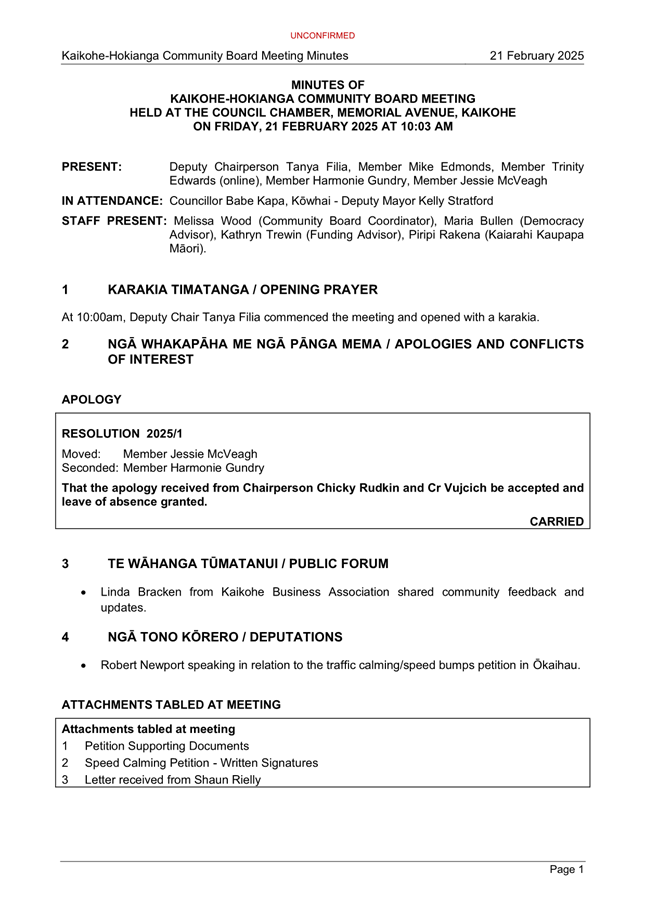
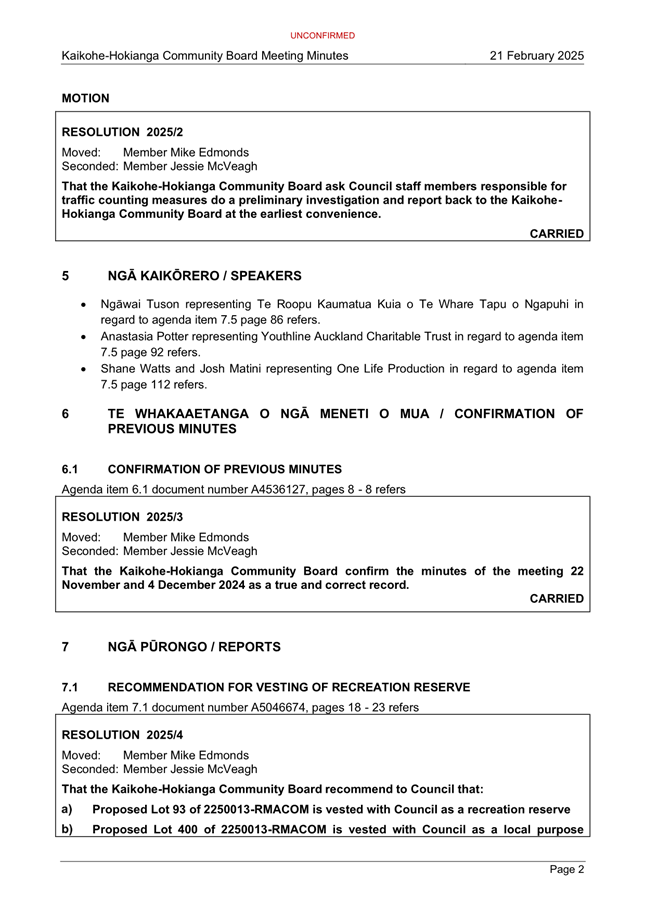
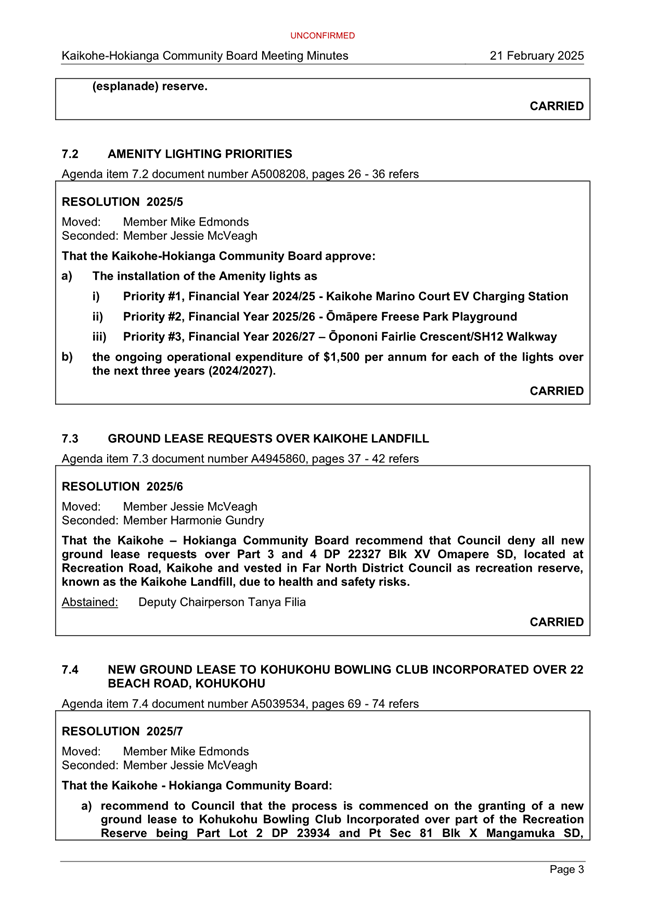



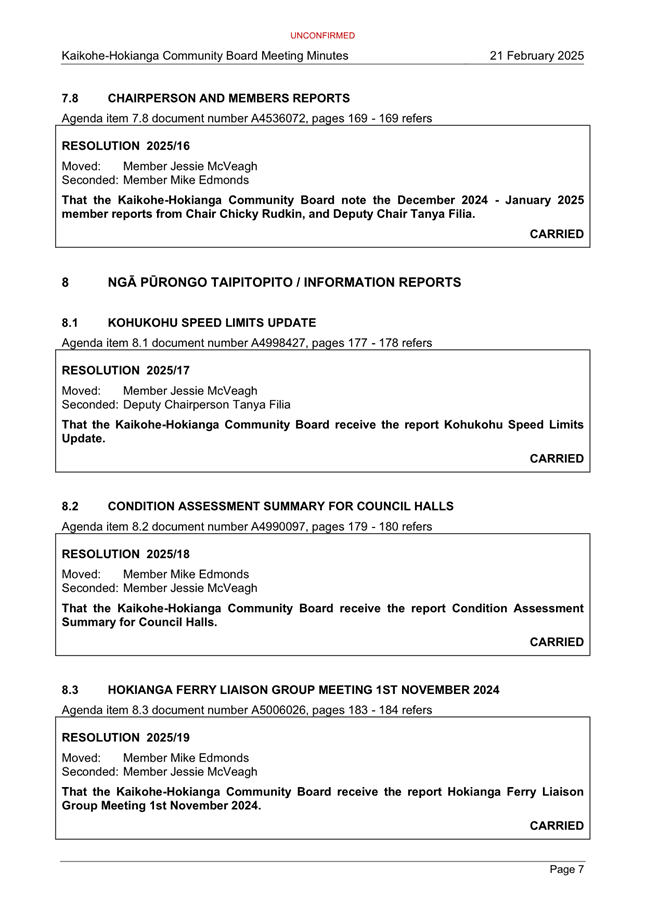

7.2 Mayor
and Councillor's Reports
File
Number: A5056539
Author: Maria
Bullen, Democracy Advisor
Authoriser: Aisha
Huriwai, Manager - Democracy Services
TE TAKE PŪRONGO / Purpose of the Report
This report is a mechanism to have open communication and
transparency on activities undertaken by Councillors as elected
representatives.
|
NGĀ
TŪTOHUNGA / Recommendation
That Council note the reports submitted by Kahika Moko
Tepania, Kōwhai - Deputy Mayor Kelly Stratford and Councillors
Babe Kapa, Ann Court, John Vujcich, Steve McNally and Hilda
Halkyard-Harawira.
|
TE tĀHUHU KŌRERO / Background
Kahika-Mayor Tepania has
reintroduced Council members reports as a mechanism to have open communication
and transparency on activities undertaken by Councillors as elected
representatives. Members reports are compulsory for Councillors.
TE MATAPAKI ME NGĀ KŌWHIRINGA /
Discussion and Next Steps
Members reports are attached for
information.
REASON
FOR THE RECOMMENDATION
To formally receive the Mayor and
Councillor reports.
NGĀ PĀNGA PŪTEA ME NGĀ WĀHANGA
TAHUA / Financial Implications and Budgetary Provision
There are no financial implications
or the need for budgetary provision as a result of this report.
ngĀ
Āpitihanga / Attachments
1. Kahika-Mayor
Moko Tepania Members Report - A5103168 ⇩ 
2. Kōwhai
- Deputy Mayor Kelly Stratford Members Report - A5103508 ⇩ 
3. Cr
Babe Kapa Members Report - A5101570 ⇩ 
4. Cr
Ann Court Members Report - A5101583 ⇩ 
5. Cr
John Vujcich Members Report - A5101581 ⇩ 
6. Cr
Steve McNally Members Report - A5103177 ⇩ 
7. Cr
Hilda Halkyard-Harawira Members Report - A5103567 ⇩ 
|
Ordinary
Council Meeting Agenda
|
13 March 2025
|

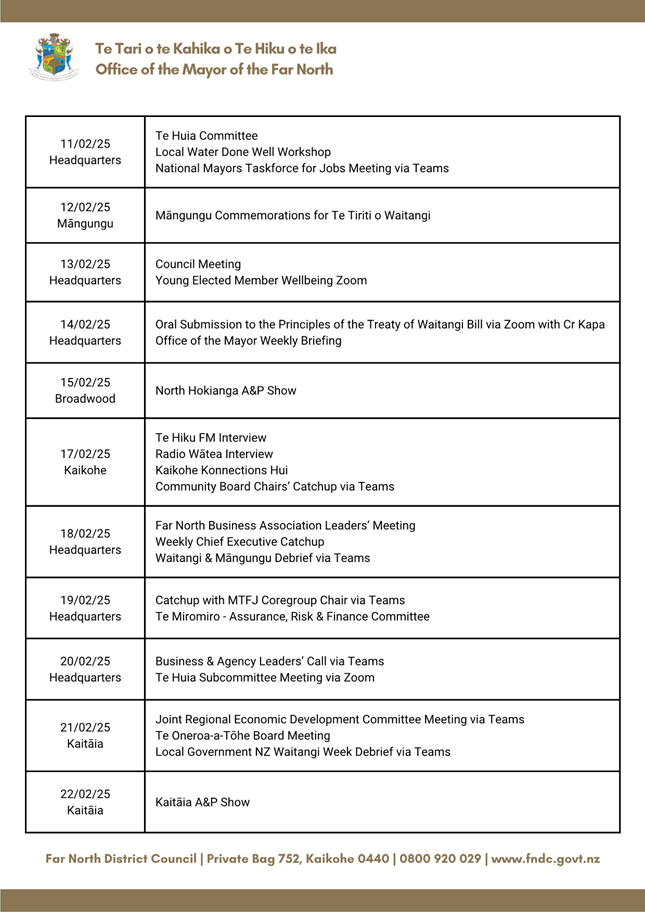
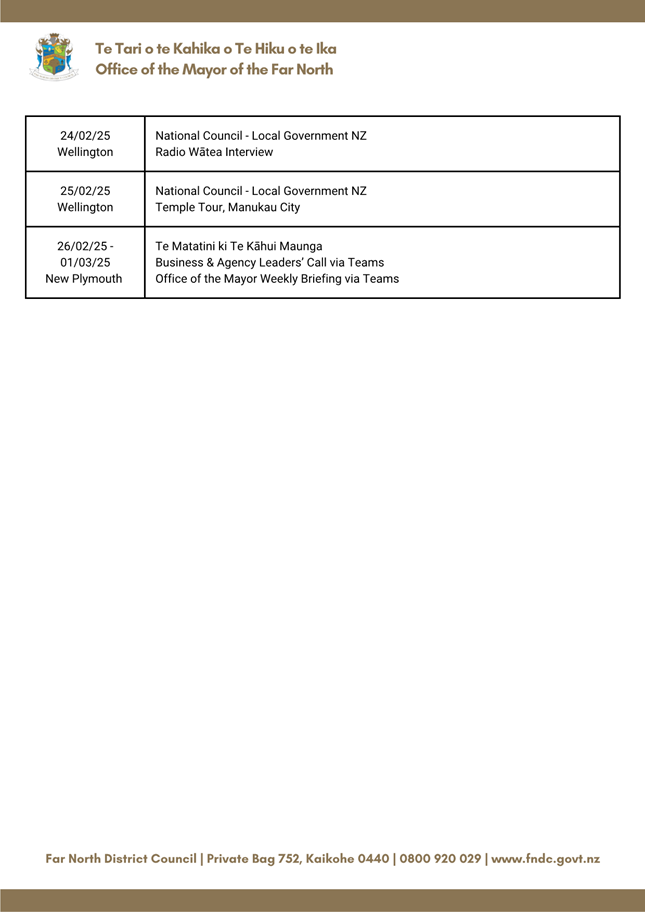
|
Ordinary Council
Meeting Agenda
|
13 March 2025
|
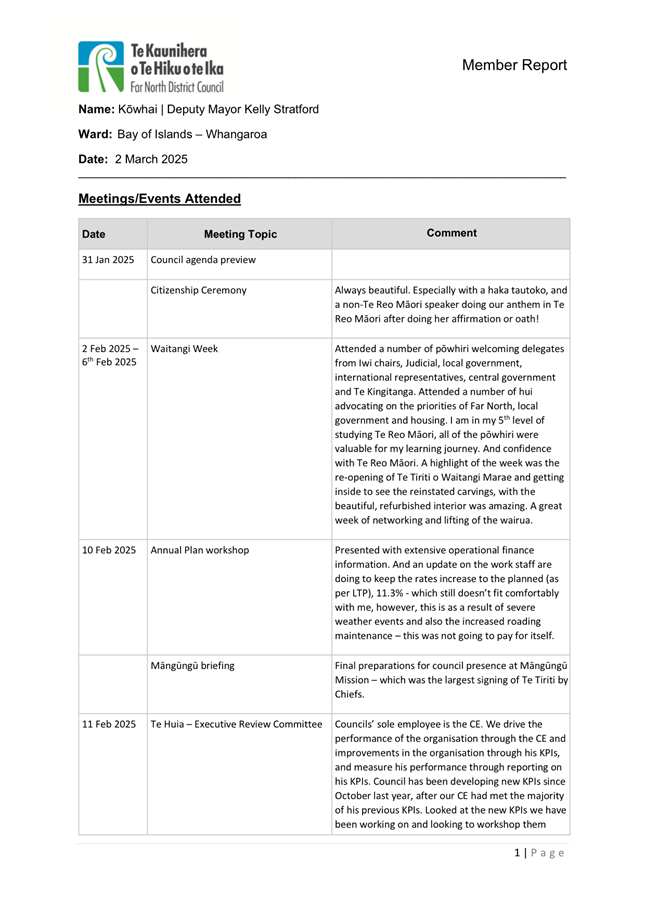
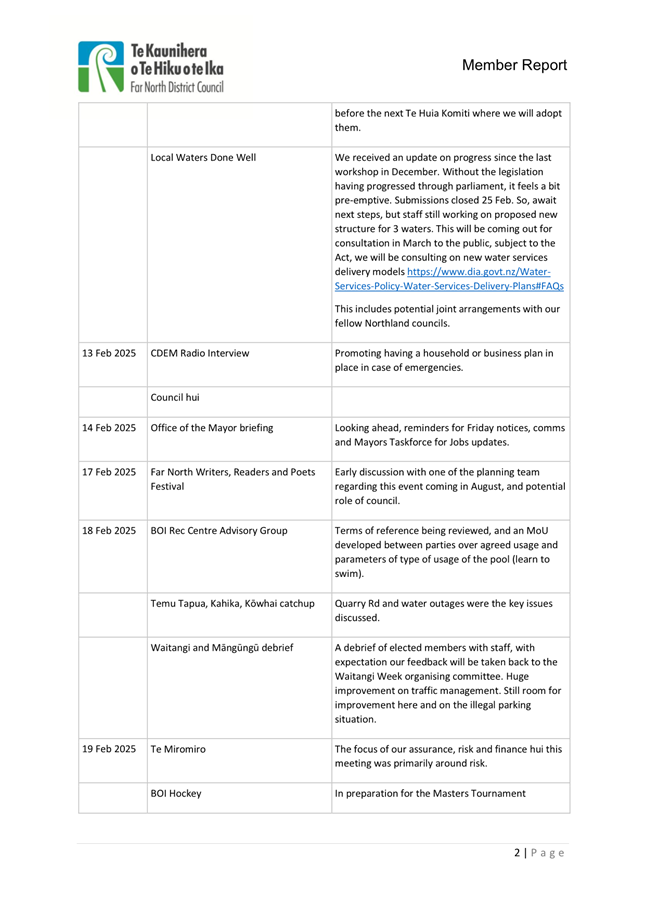
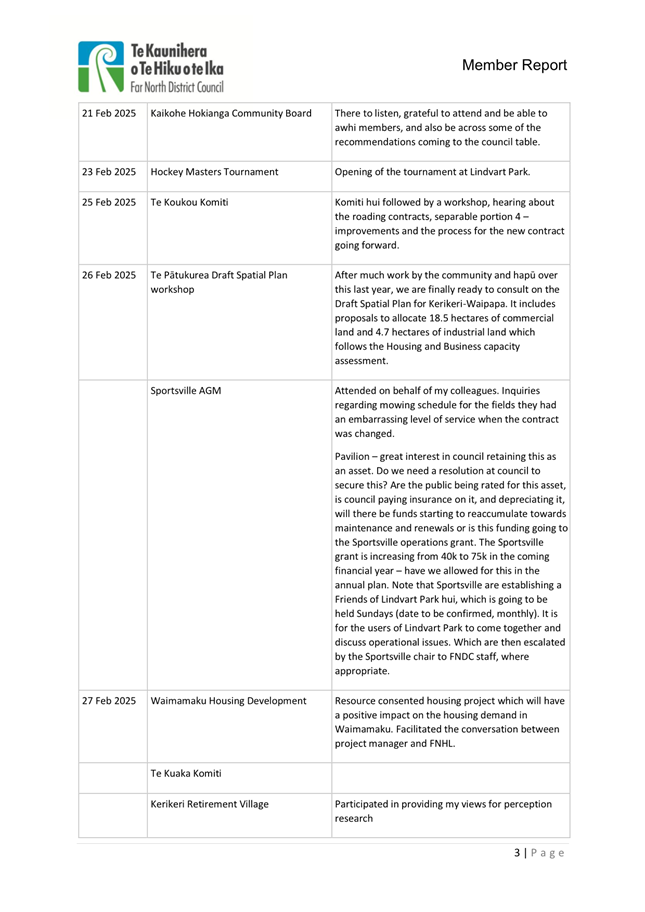
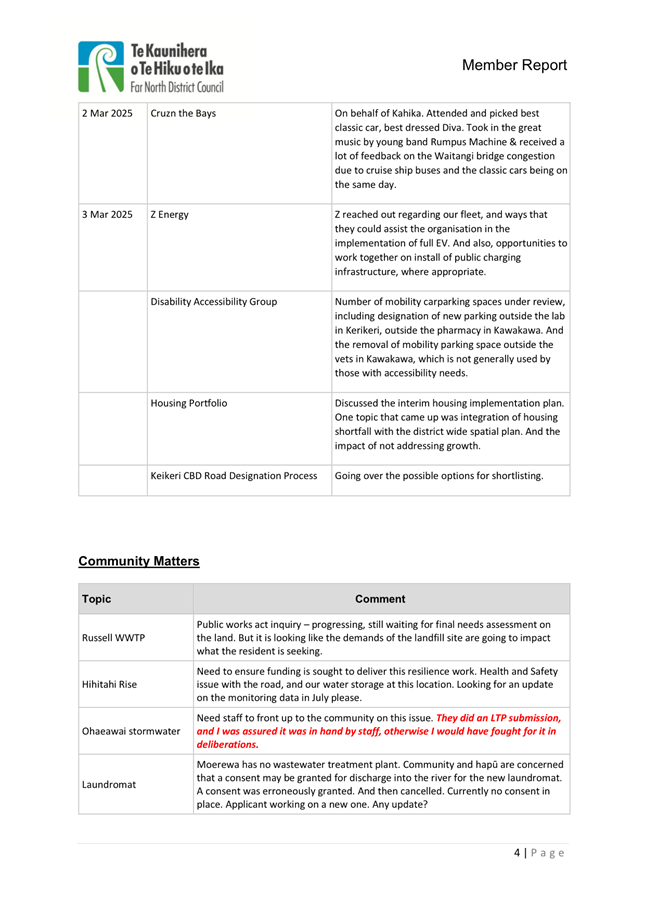
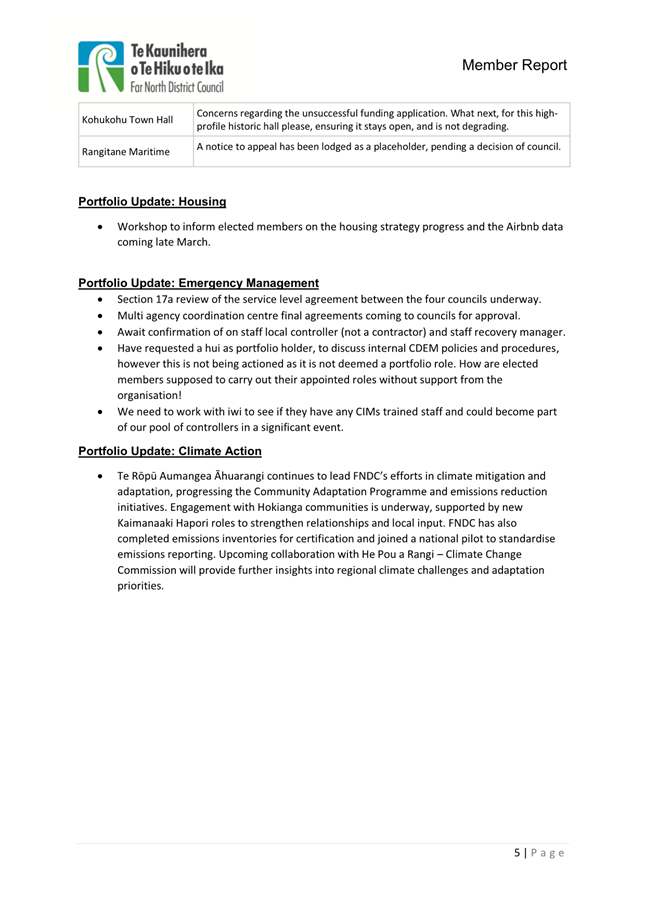
|
Ordinary Council
Meeting Agenda
|
13 March 2025
|
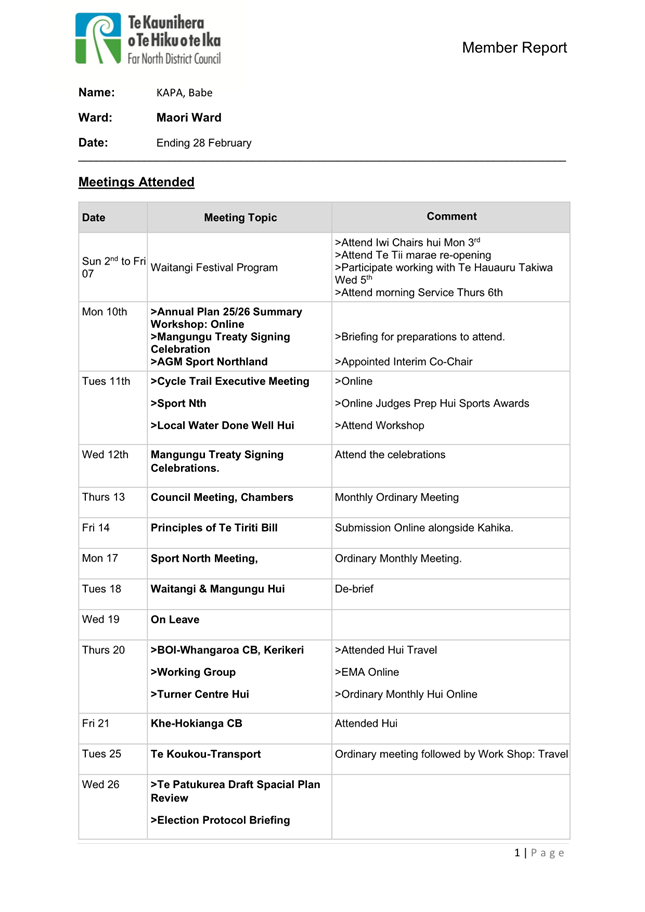
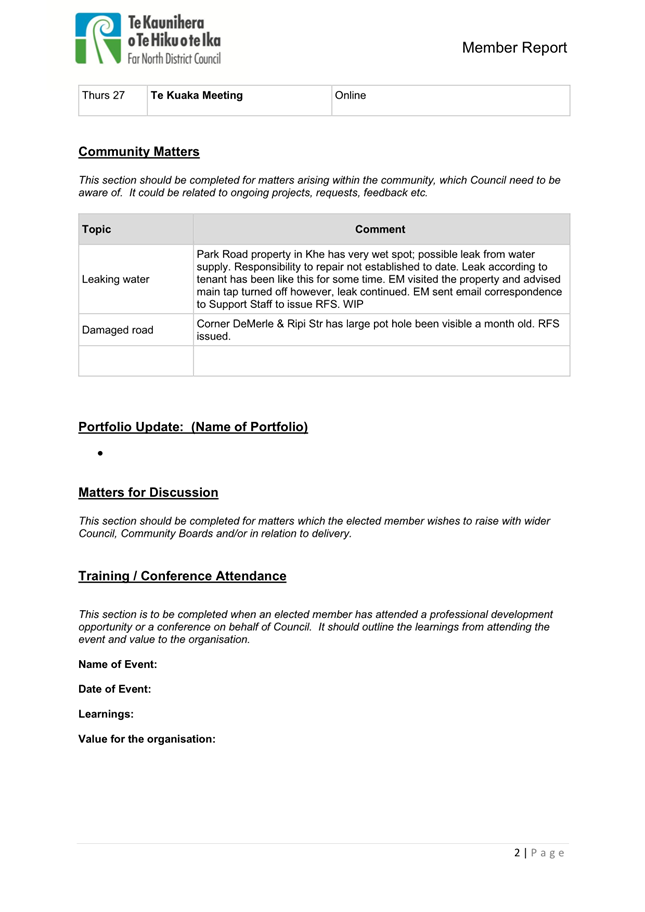
|
Ordinary Council
Meeting Agenda
|
13 March 2025
|
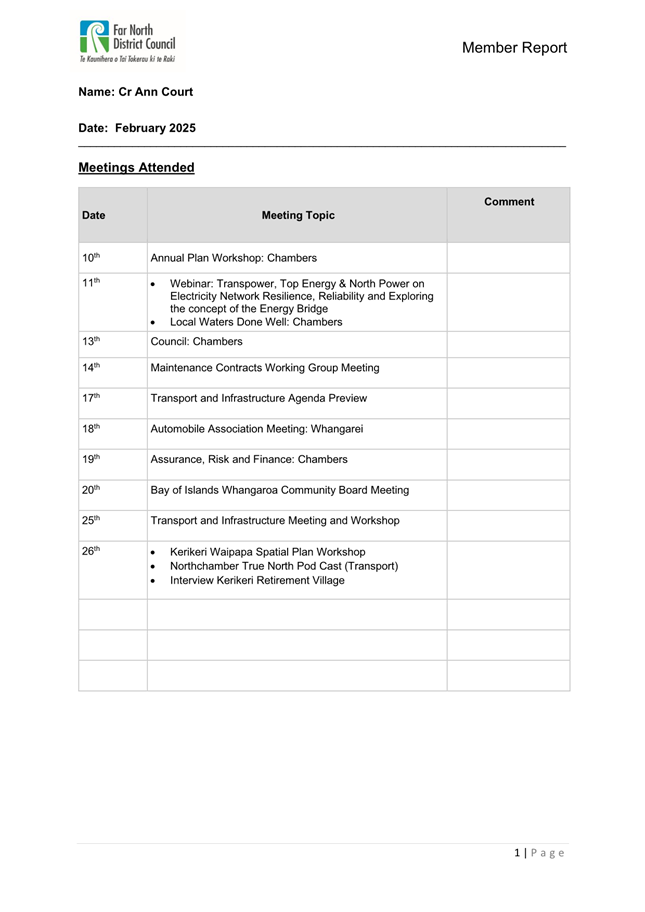
|
Ordinary
Council Meeting Agenda
|
13 March 2025
|


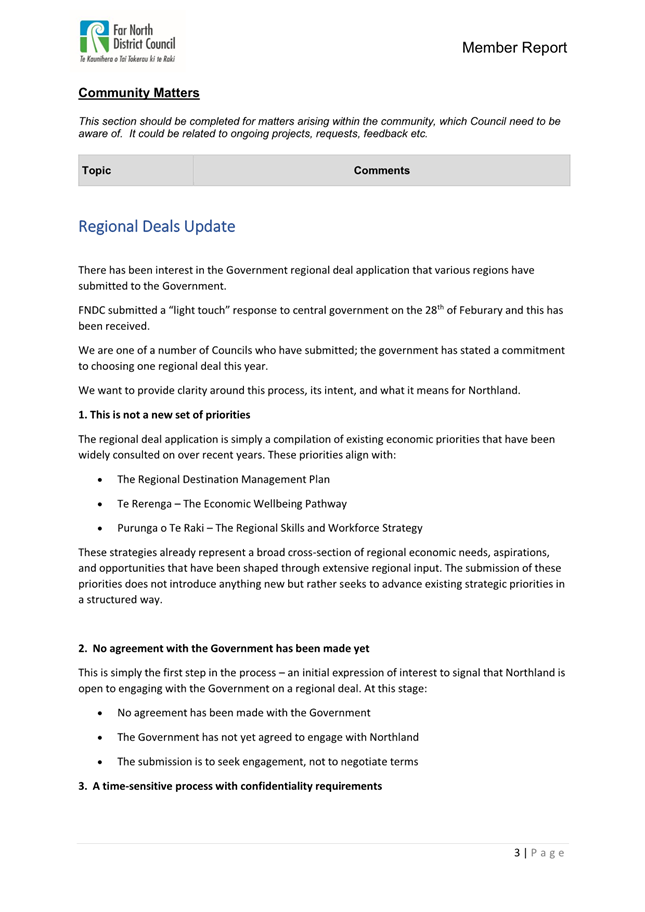

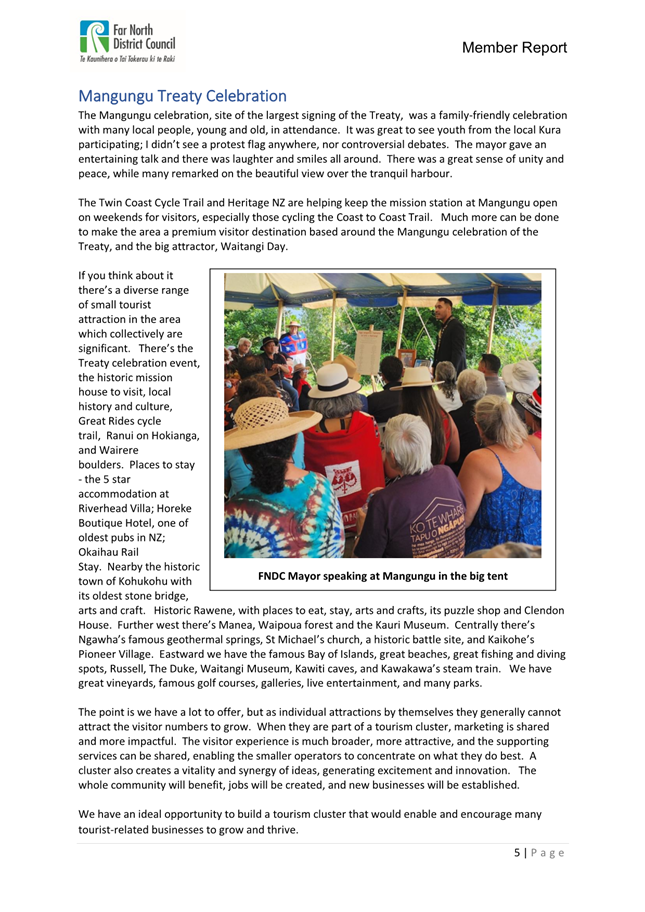
|
Ordinary Council
Meeting Agenda
|
13 March 2025
|
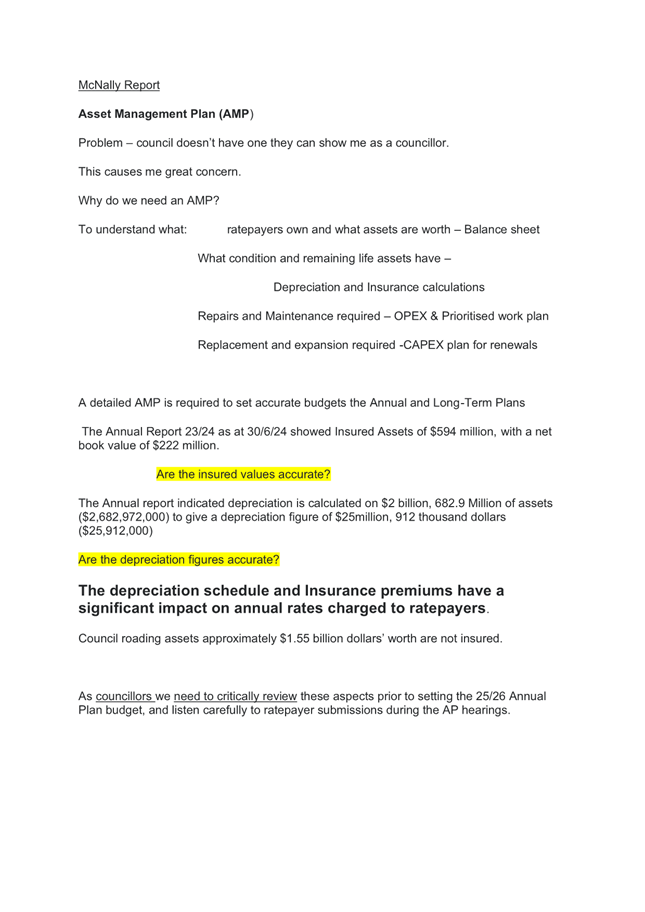
|
Ordinary
Council Meeting Agenda
|
13 March 2025
|


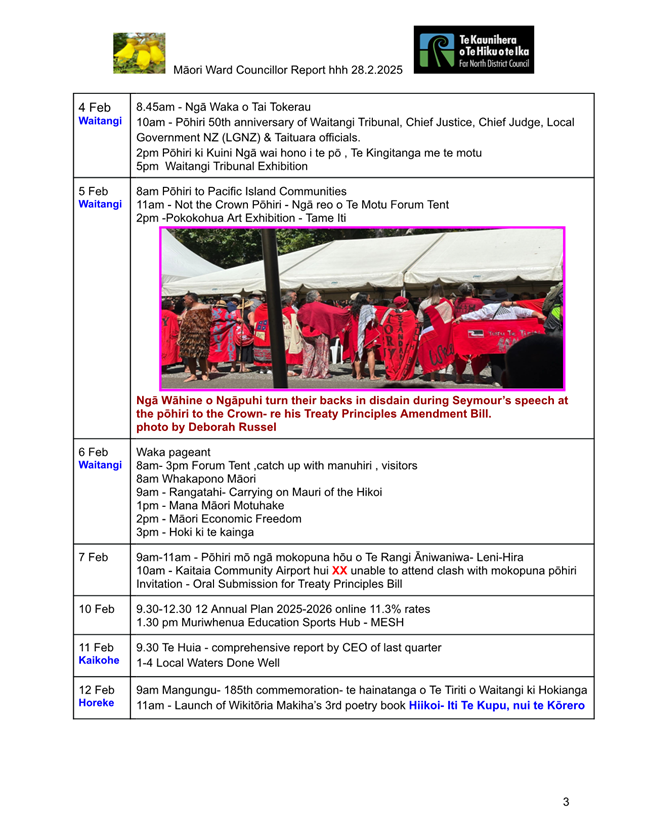
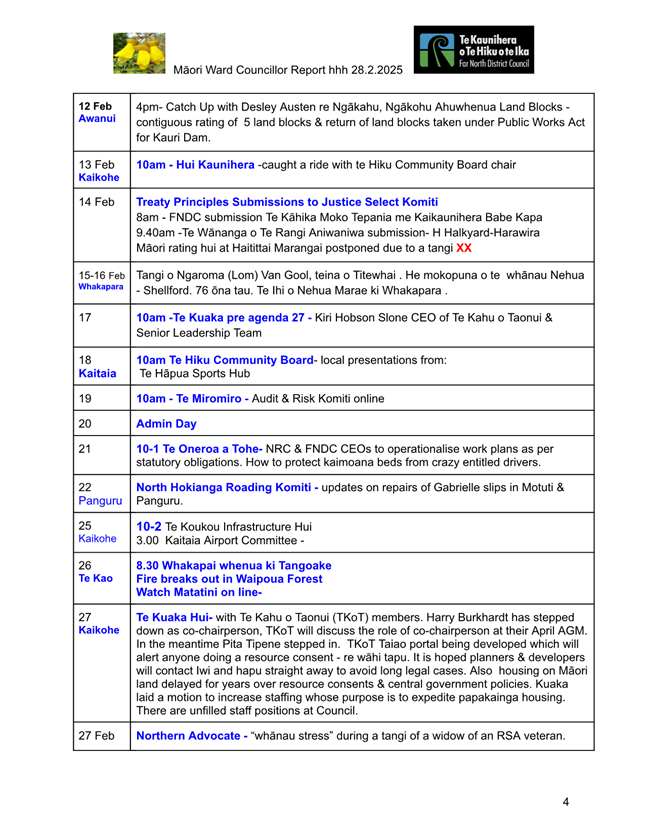
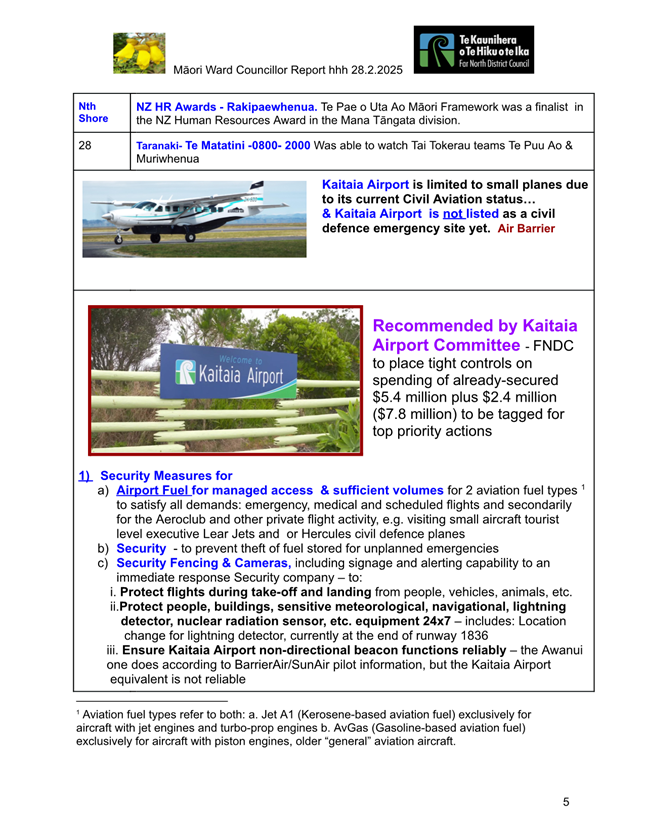
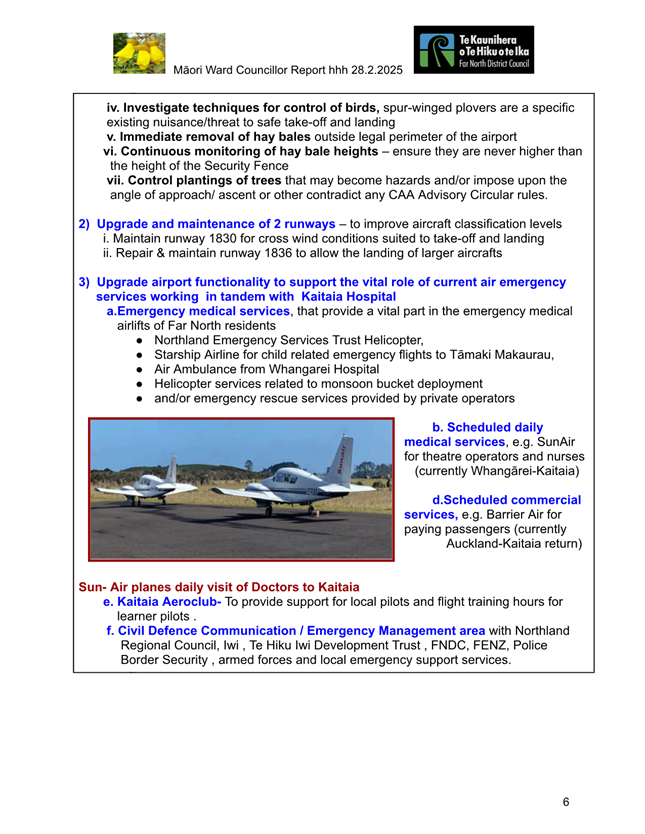

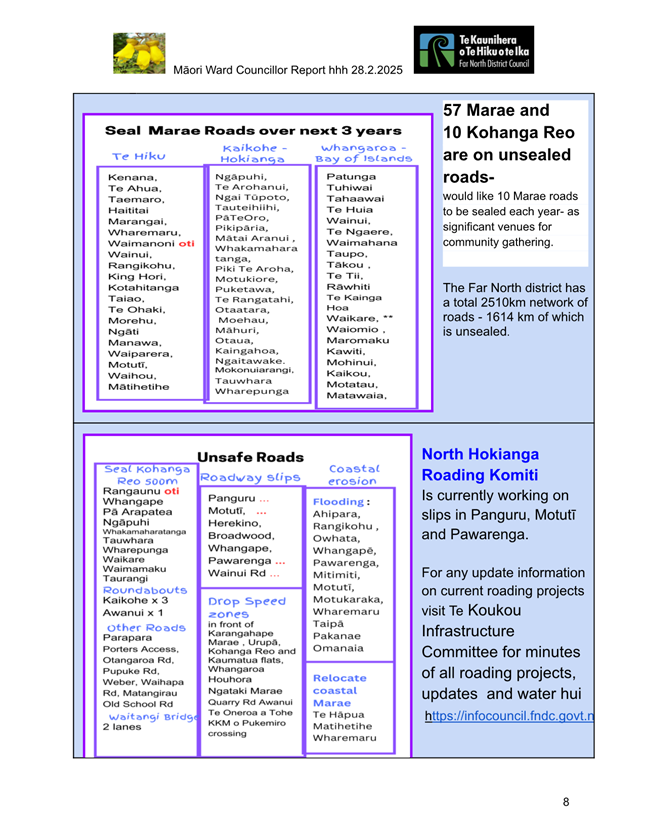
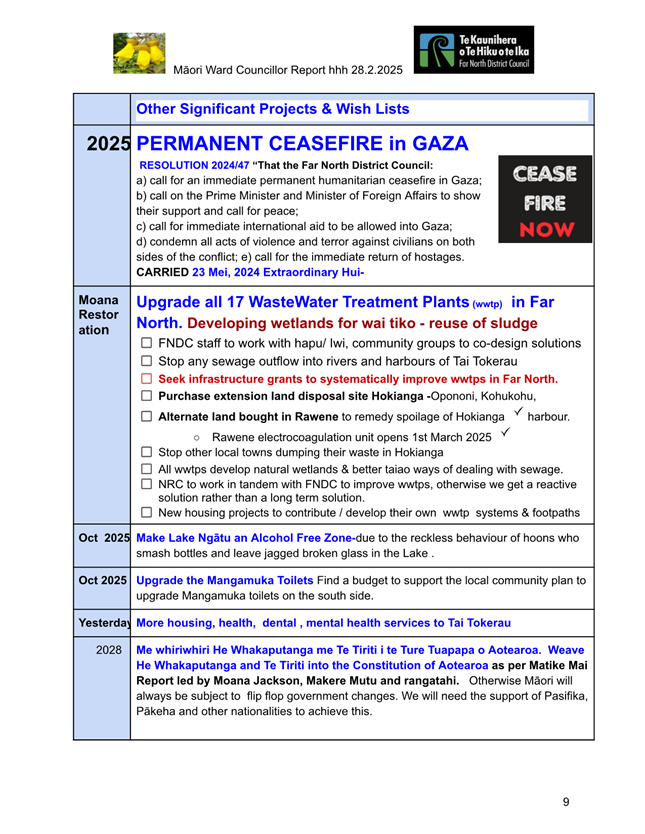
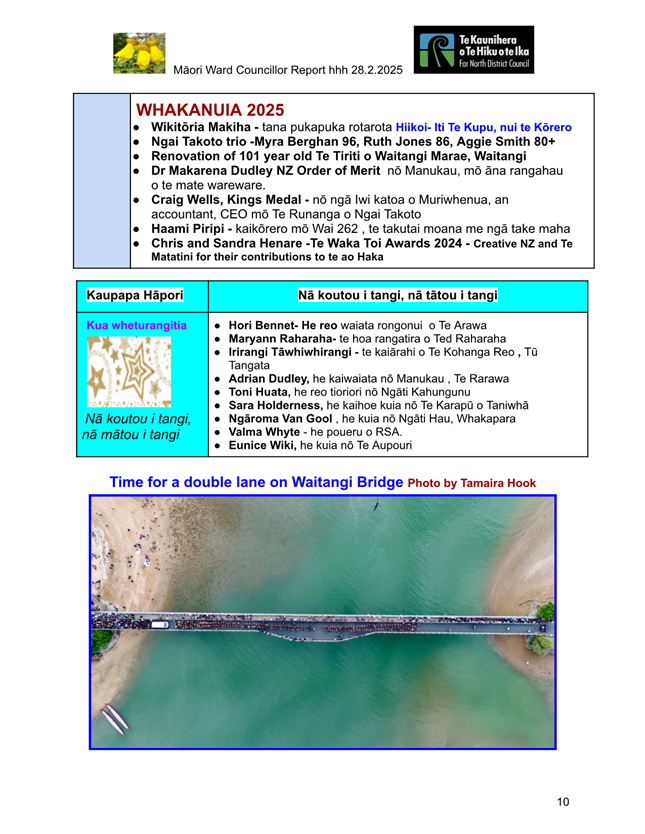
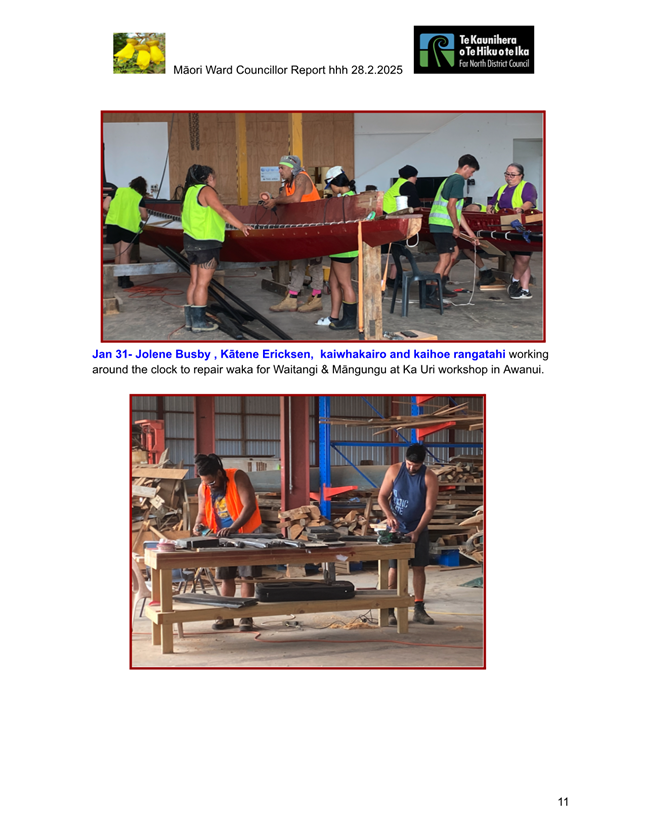
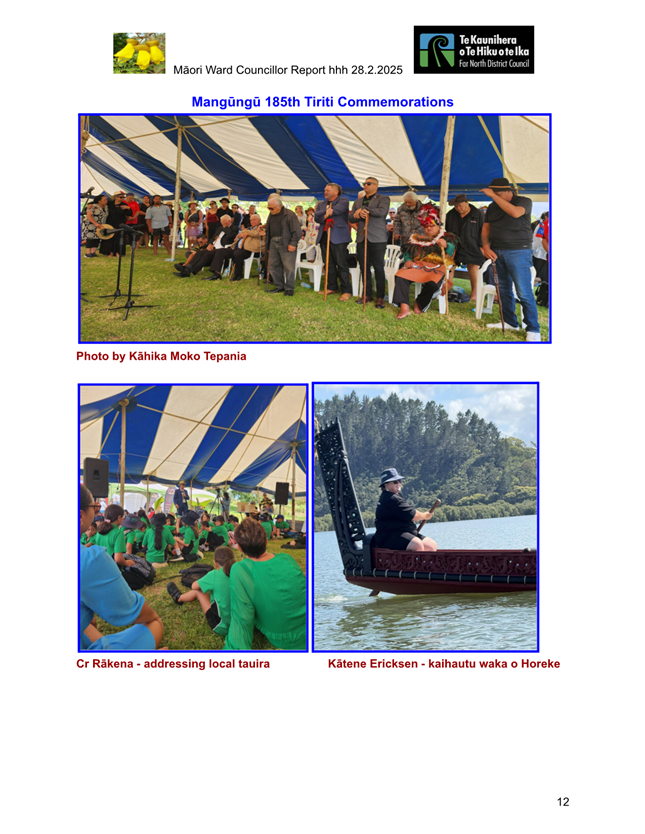
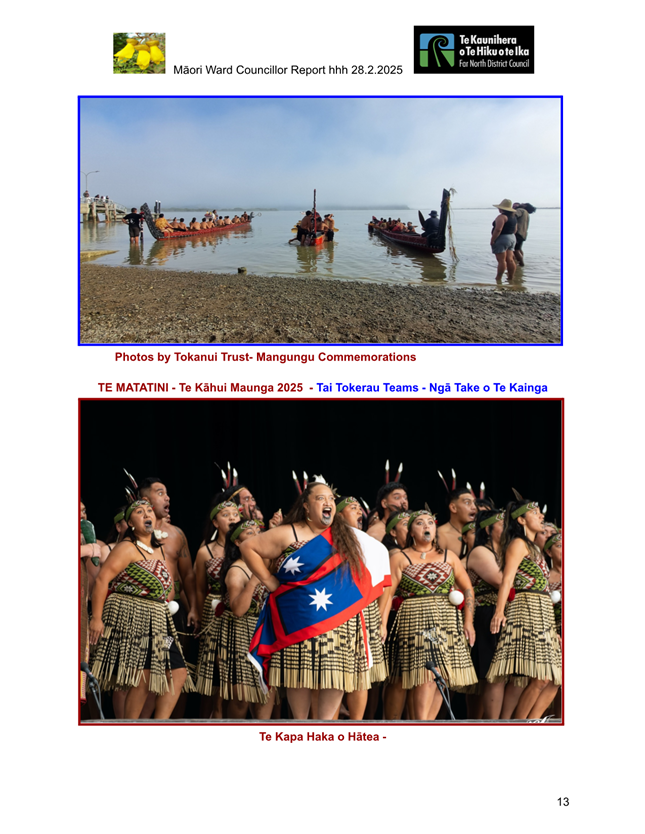
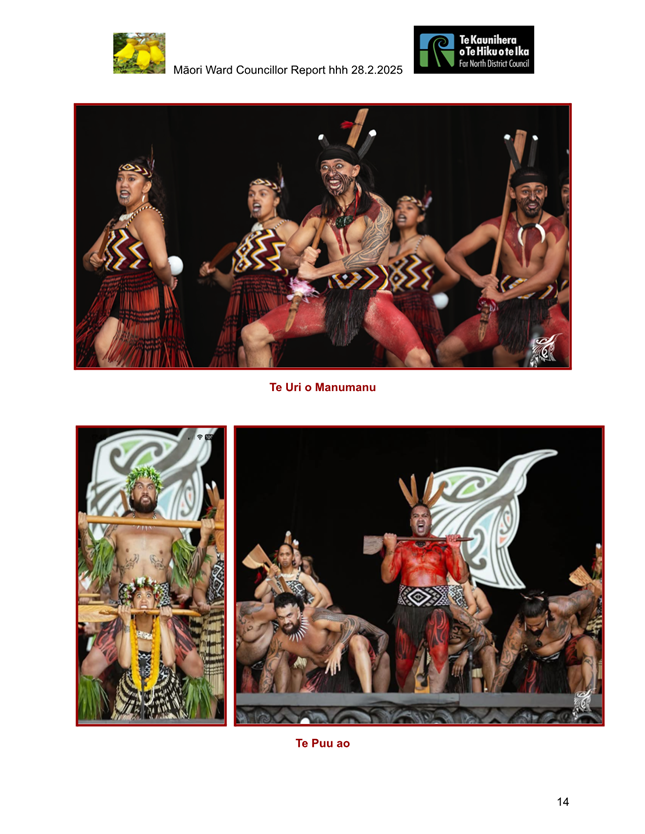
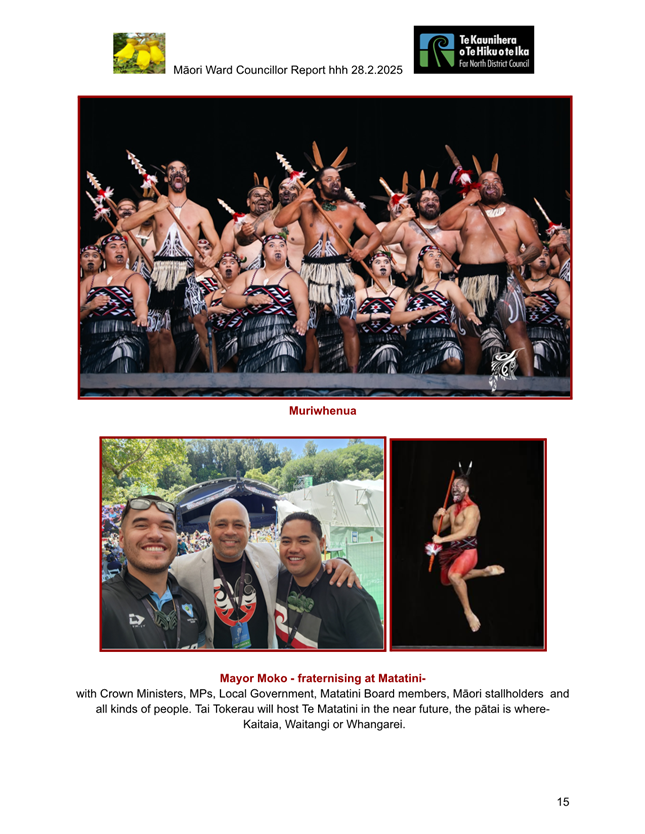
7.3 Draft
Community Adaptation Programme Plan - Part 1
File
Number: A5093712
Author: Katy
Simon, Senior Climate Action & Resilience Planner
Authoriser: Roger
Ackers, Group Manager - Planning & Policy
TAKE PŪRONGO / Purpose of the Report
To update Council on the
development of the Community Adaptation Programme and to seek initial direction
on the Draft Part 1 – Community Adaptation Programme Plan.
WHAKARĀPOPOTO MATUA / Executive SummarY
Te Kaunihera o Te Hiku o Te Ika- Far North District Council
(Council) has committed to community adaptation planning to prepare for and
respond to increasing natural hazards. Staff are developing a Community
Adaptation Programme to guide the adaptation planning work. This report
presents the draft contents of Part 1 of the Community Adaptation Programme
Plan and updates Council on community adaptation planning work.
|
TŪTOHUNGA
/ Recommendation
That the Council receive the report Draft Community
Adaptation Programme Plan - Part 1.
|
tĀHUHU KŌRERO / Background
Why community adaptation planning?
Adaptation can be understood as the different ways people
prepare for and respond to the local impacts of a changing climate. In
community adaptation planning, Council works alongside tangata whenua and
community to plan for increasing natural hazards.
Community adaptation planning feeds into and supports other
Council responsibilities, including:
· Infrastructure Strategy and asset management planning
· District Planning, land-use and resource management planning
· Civil Defence and emergency management planning
· Community development and placemaking
· Te Ao Māori and Tangata Whenua Relationships:
o Te Pae o Uta Te Ao Māori Framework
o Iwi Hapū Environmental Management Plan Support
Council has committed to community
adaptation planning with communities under the:
· Far North 2100 Strategy
· Climate Change Roadmap (approved 2020)
· Te Tai Tokerau Climate Adaptation Strategy (adopted 2022)
· Climate Action Policy (adopted December 2023)
· Long Term Plan 2024-2027
Council’s responsibilities
around adaptation planning come from the:
· Local Government Act 2002
· Resource Management Act 1991
· Climate Change Response Act 2002 and the National Adaptation Plan
(NAP)
· Civil Defence Emergency Management Act 2002
Te Tiriti o Waitangi and He Whakaputanga also strongly
inform Council’s climate action and resilience work, guiding
Council’s approach to community adaptation planning.
Why a Community Adaptation Programme Plan?
From 2020 – 2023, Council worked to design a community
adaptation planning programme. Council went through a multi-step process to
identify and prioritise areas across the district. In this process Council
looked at risks from coastal hazards and river flood hazards to community,
tangata whenua, infrastructure and private property assets. Council also
considered district coverage of each proposed area.
In February 2024, Council received a technical report in the
Friday notices recommending that Council deliver a community adaptation
programme in four stages, from 2024-2035. The staged recommendations in this
report came from previous Council direction and decisions. No formal approval
was sought.
In April 2024, Te Rōpū Aumangea Āhuarangi,
the Climate Action and Resilience Department, began work on Stage One in the
Hokianga - Whangapē - Herekino areas. As staff began the scoping and
preparation work, the team recognised a need for a wider programme plan. A
programme plan would draw from the existing programme design and connect all
four project stages under a shared vision, outcome and management approach. The
team also recognised a need for Council direction on, and approval of, a
programme plan to ensure governance awareness and buy-in of the full community
adaptation programme.
Staff now seek to address the programme plan gap, while
still delivering on the actual community adaptation planning work. Staff have
two parallel workstreams:
1. Create
an overarching Community Adaptation Programme Plan.
2. Prepare
the Stage One project in Hokianga - Whangapē - Herekino areas.
What adaptation planning work
has been done so far?
From April 2024 – February 2025, staff have carried
out a variety of preparation work for the Stage One project. This includes:
· Seeking early direction from relevant Community Board Members on
engagement and community needs.
· Establishing two Kaimanaaki Hapori, local community advisor roles,
to guide early kōrero and early engagement.
· Supporting the Kaimanaaki in over 20 early engagement initiatives
across Hokianga nui ā Kupe.
· Creating tools and templates for communities to jumpstart their
adaptation planning.
· Creating kaupapa Māori tools and templates to support tangata
whenua-led adaptation.
· Undertaking a natural hazards stocktake assessment and developing a
natural hazards risk GIS portal.
· Confirming an operational Memorandum of Understanding with Northland
Regional Council on adaptation planning roles, responsibilities and resourcing.
· Establishing a Kaupapa Māori lead to support tangata whenua
relationships and tangata whenua-led adaptation (this is an externally funded
role).
· Leading region-wide engagement at Waitangi Day and the North
Hokianga A&P.
Stage One progress is delayed by
about six months. This delay is due to reduced funding in the 24/25 Annual Plan
process and reduced staff capacity due to the redeployment of staff from the
Climate Action and Resilience Department to the Future of Severely Affected
Land programme.
MATAPAKI ME NGĀ KŌWHIRINGA /
Discussion and Next Steps
The
Community Adaptation Programme Plan will guide ten plus years of Council
adaptation work and will set a standard for each adaptation planning project
and for wider adaptation resources.
The
Programme Plan will be made up of two parts. Part 1 sets the foundational
elements of Council’s community adaptation work: vision, outcome, goals,
scope and engagement approach. Part 2 (not included) will outline the design
and management aspects: resource requirements, risk management, detailed
deliverables and outputs, and success measurements.
This is the
part that staff are putting forward for Council’s information and early
direction.
Please see Attachment
A for Part 1.
In addition
to this information report, staff have sought early feedback and direction from
Te Kuaka Te Ao Māori Committee. Staff asked the following questions.
· Do you agree with the vision, purpose, outcomes and goals? Any
changes to this content?
· Does the Part 1 content adequately reflect Te Kuaka and
Council’s commitments to climate action and resilience, and to iwi and
hapū?
· Is there anything to add to Part 1? (Noting that Part 2 will
follow.)
Staff also
asked Te Kuaka for any mihimihi, guiding kōrero, karakia,
whakataukī/whakatuākī, and if needed, he ingoa Māori for
the entire Community Adaptation Programme. Attachment B explains the
programme icon and design and introduces a possible te reo Māori name for
Council’s adaptation work: Urutaunga Āhuarangi.
PĀNGA PŪTEA ME NGĀ WĀHANGA
TAHUA / Financial Implications and Budgetary Provision
The complete draft
Community Adaptation Programme Plan will indicate core resourcing
requirements.
Current resourcing for
the community adaptation planning is set under the 2024-2027 Long Term Plan.
Any future changes to the Programme’s financial implications and
budgetary provisions will be addressed through the Long Term Plan and Annual
Plan processes.
Āpitihanga
/ Attachments
1. Attachment
A - Draft Part 1 Community Adaptation Programme Plan - A5094612 ⇩ 
2. Attachment
B - Programme branding and themes - A5094614 ⇩ 
|
Ordinary
Council Meeting Agenda
|
13 March 2025
|
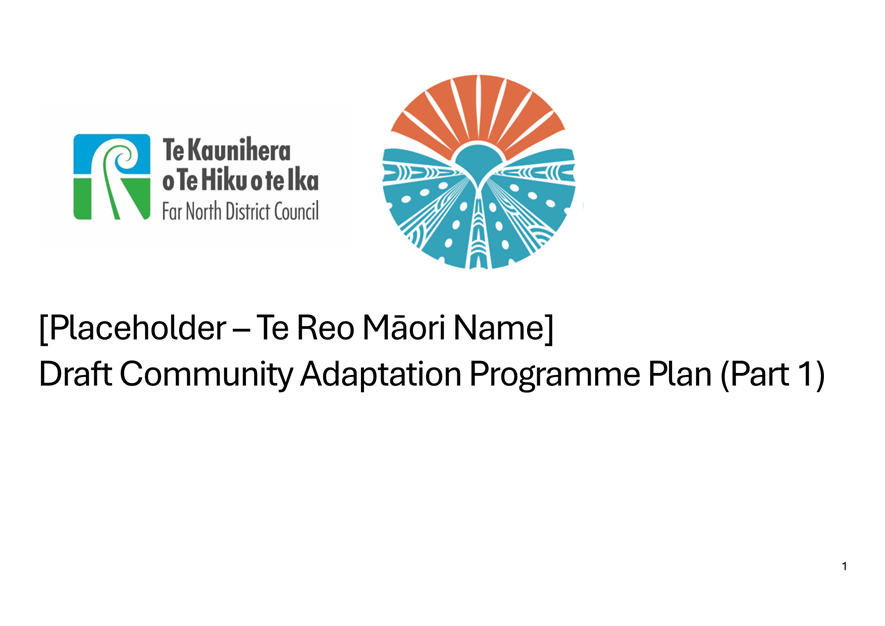
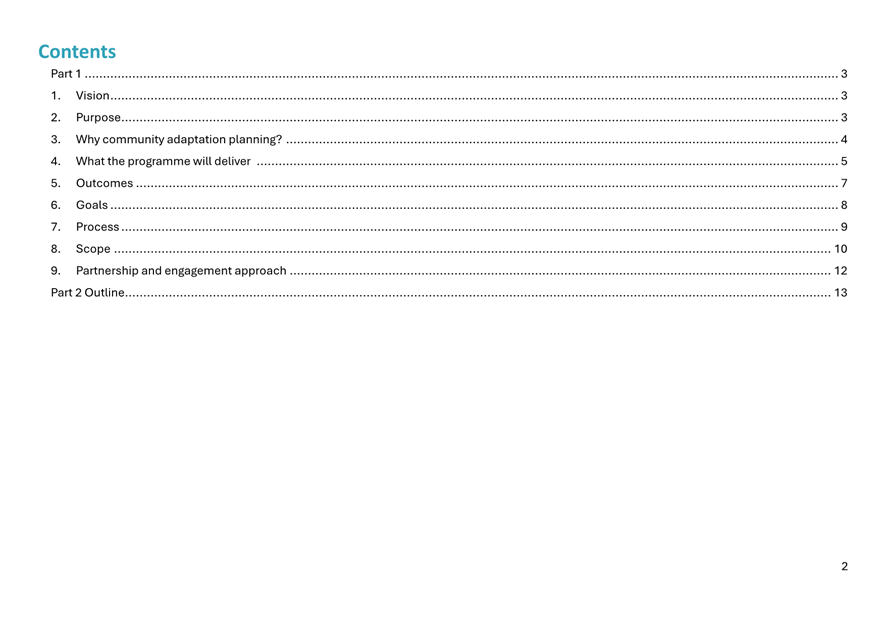


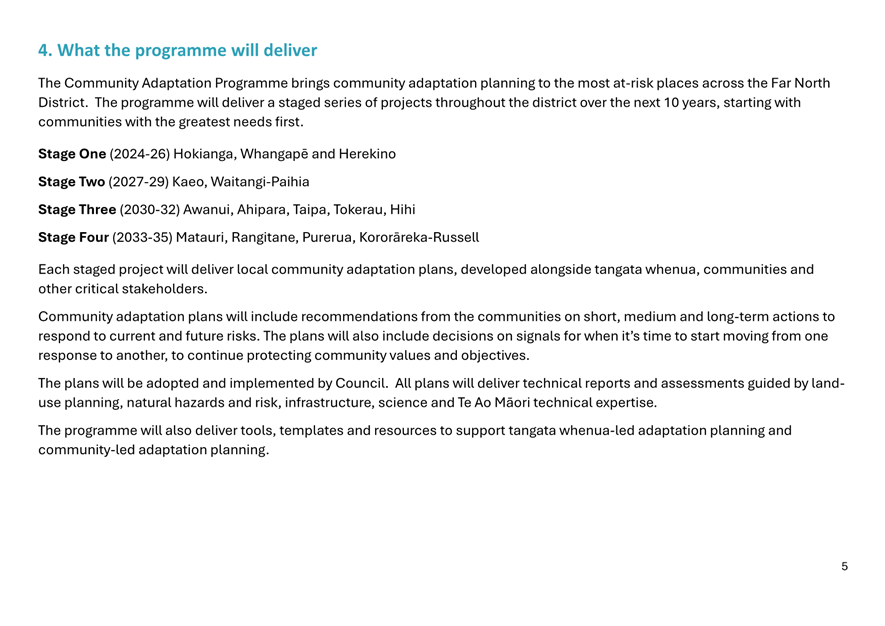
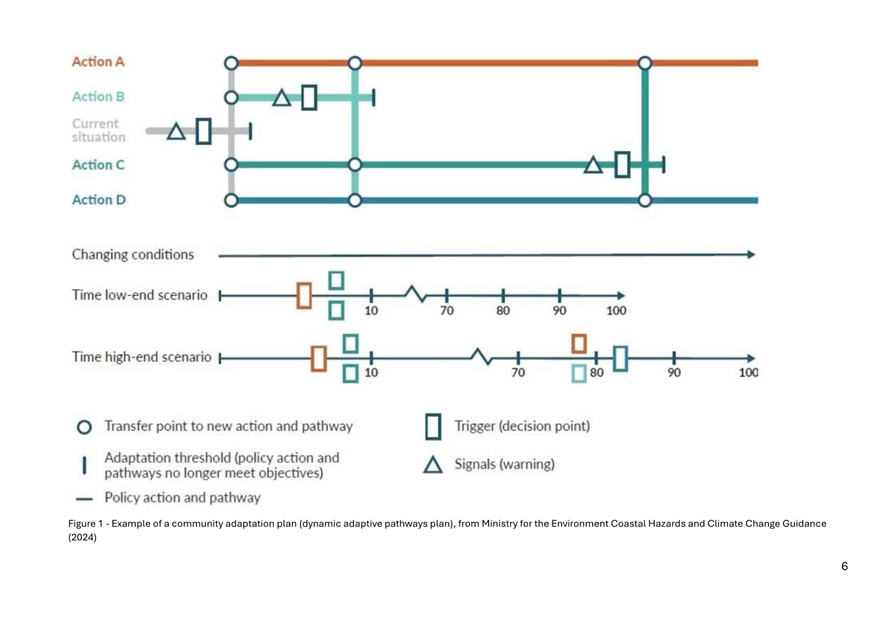
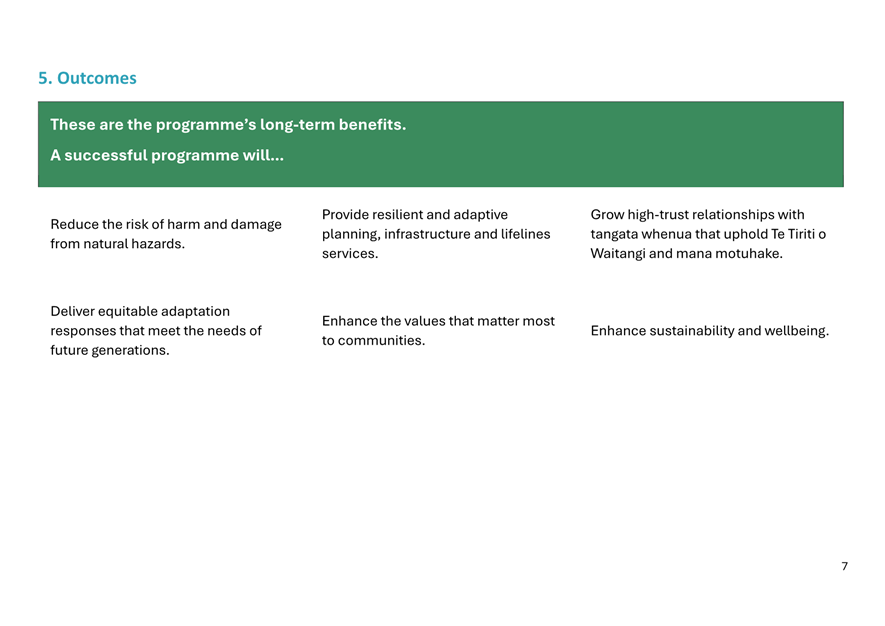
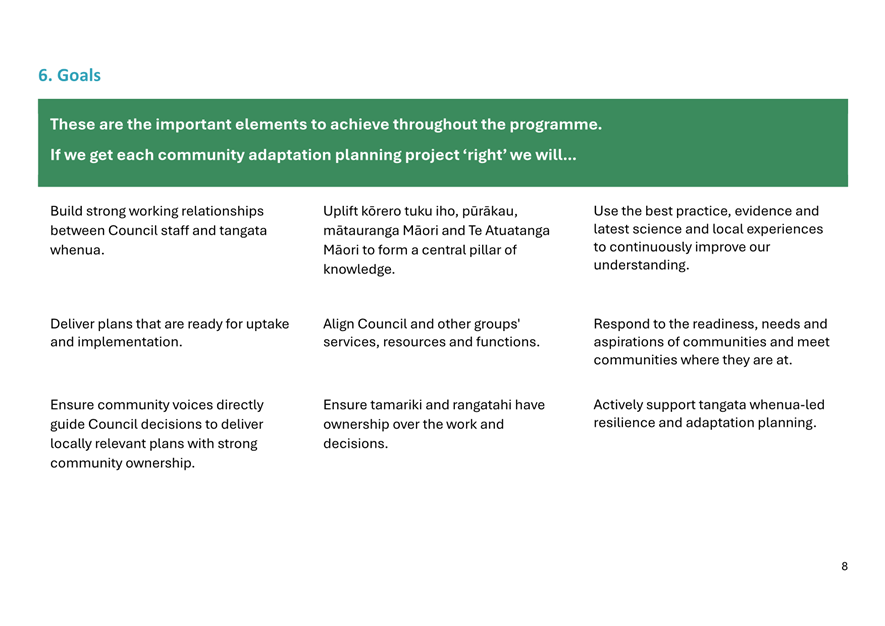



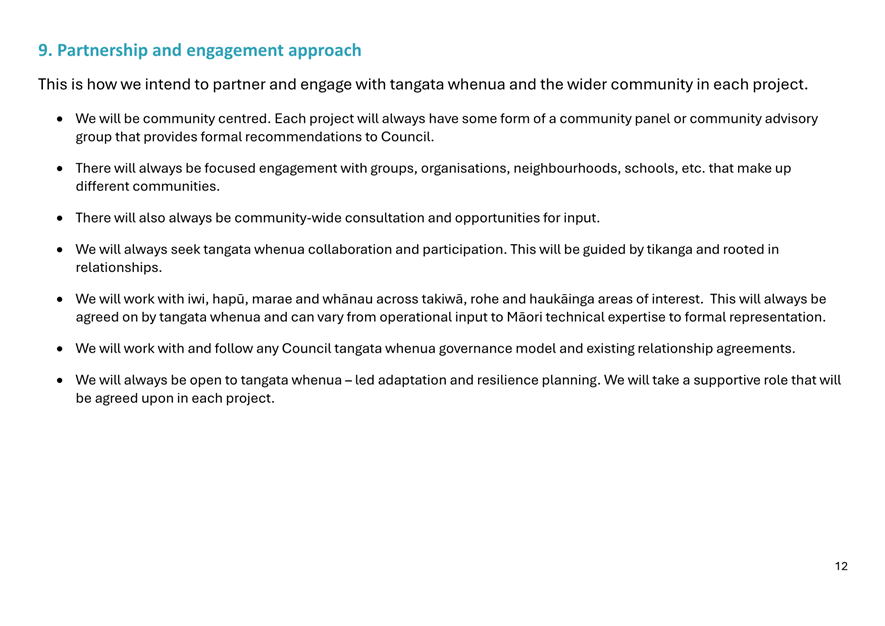

|
Ordinary Council
Meeting Agenda
|
13 March 2025
|

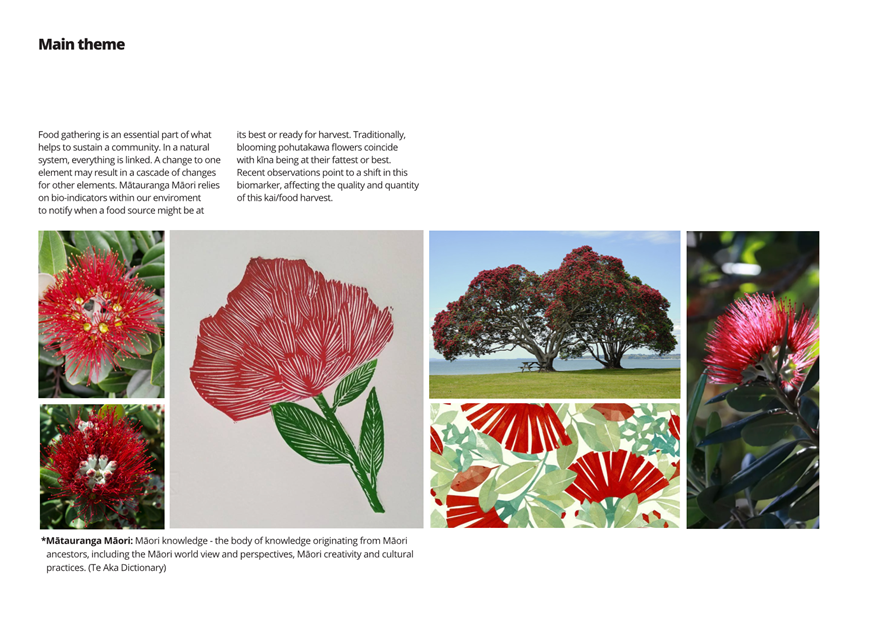
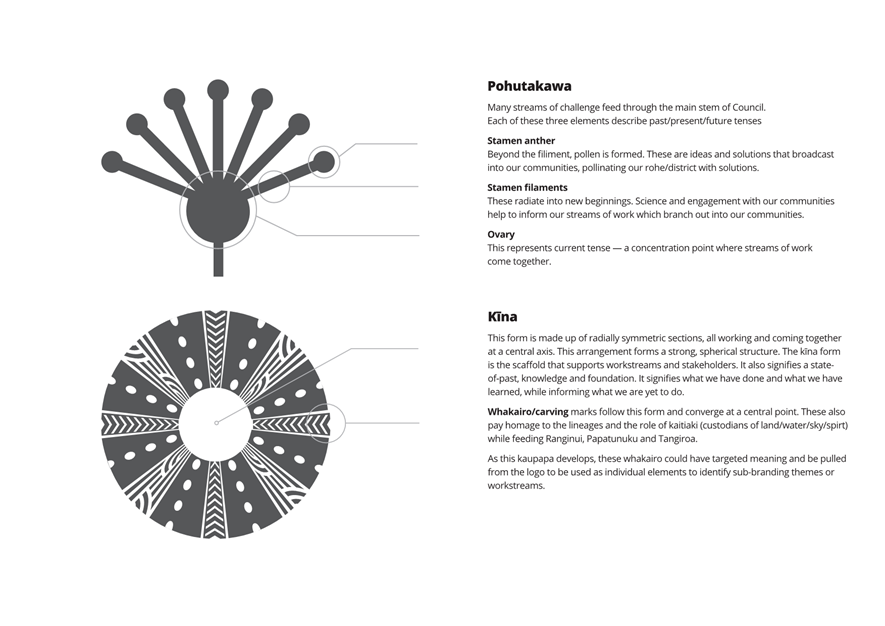

7.4 Council
Open Resolutions Update March 2025
File
Number: A5056501
Author: Maria
Bullen, Democracy Advisor
Authoriser: Aisha
Huriwai, Manager - Democracy Services
Take Pūrongo / Purpose of the Report
To provide Council with
an overview of outstanding Council and the previous term Committee decisions
from 1 January 2020.
WhakarĀpopoto matua / Executive Summary
· Open resolutions are a mechanism to communicate progress against
decisions/resolutions.
· Open resolutions are also in place for all formal elected member
meetings.
|
tŪtohunga
/ Recommendation
That Council receive the report Council Open
Resolution Update March 2025.
|
1) TĀhuhu kŌrero / Background
Any resolution or decision from a meeting is compiled on an
open resolution status report, to capture actions trigged by Council decisions.
Staff provide updates on progress against tasks that are not yet completed.
The open resolution report also includes outstanding actions
from previous triennium committees.
2) matapaki me NgĀ KŌwhiringa /
Discussion and Options
The outstanding tasks are often multi-facet projects that
take longer to fully complete. Where a decision differs to the recommendation
of staff there may be unintended consequences or challenges that take longer
for staff to work through.
TAKE TŪTOHUNGA
/ REASON FOR THE RECOMMENDATION.
To provide Council with
an overview of outstanding Council decisions from 1 January 2020.
3) PĀnga PŪtea me ngĀ
wĀhanga tahua / Financial Implications and Budgetary Provision
There are no financial
implications or need for budgetary provision in receiving this report.
Āpitihanga
/ Attachments
1. Open
Resolutions Report - A5104545 ⇩ 
|
Ordinary
Council Meeting Agenda
|
13 March 2025
|

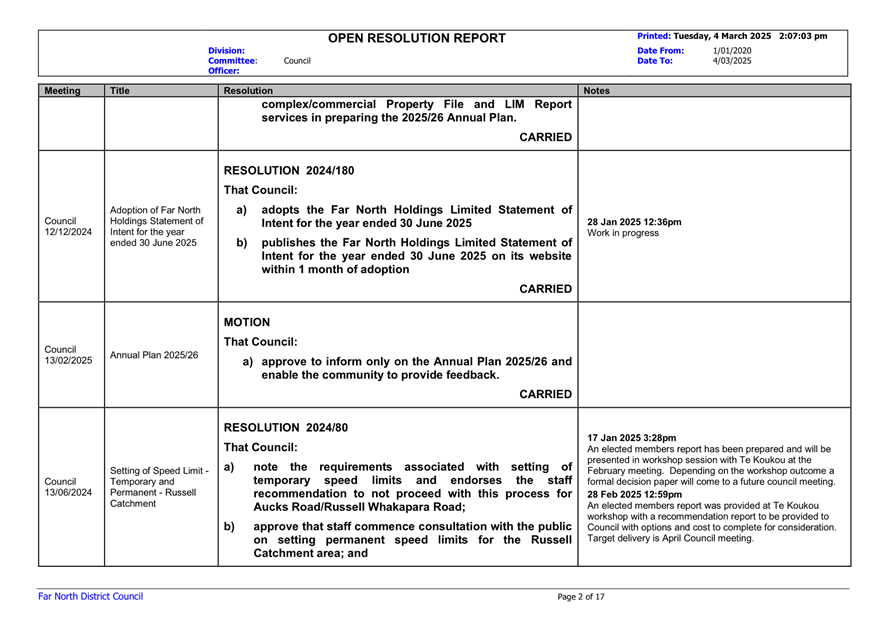

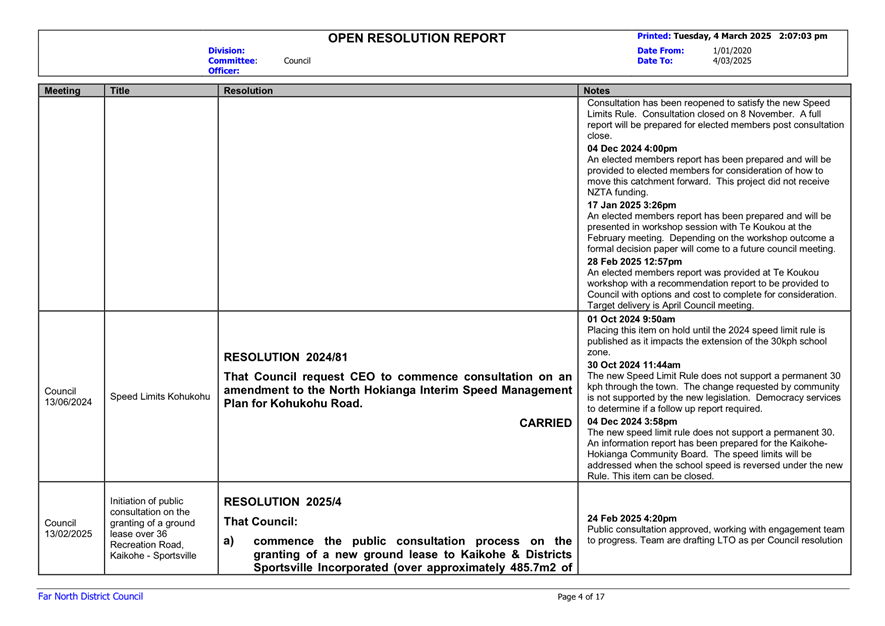
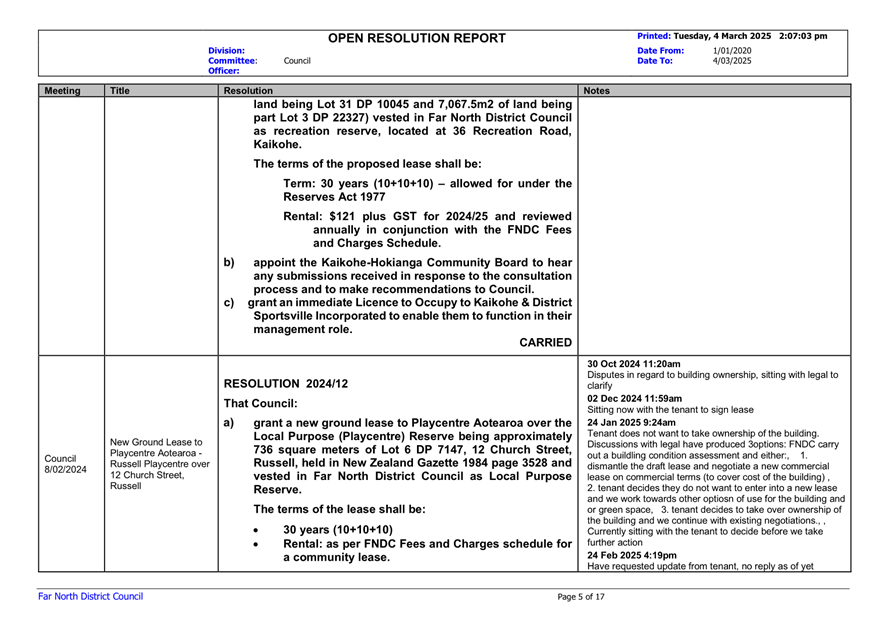
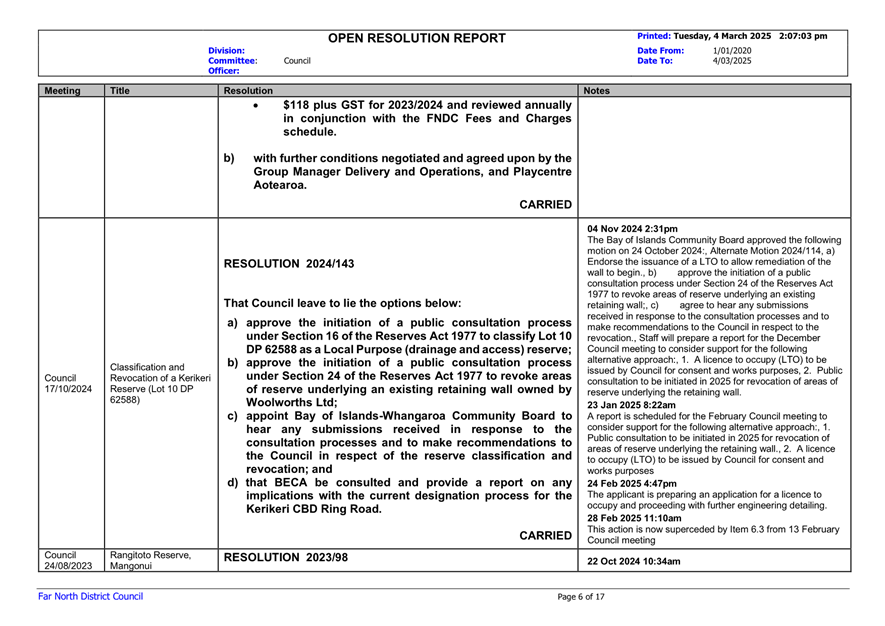
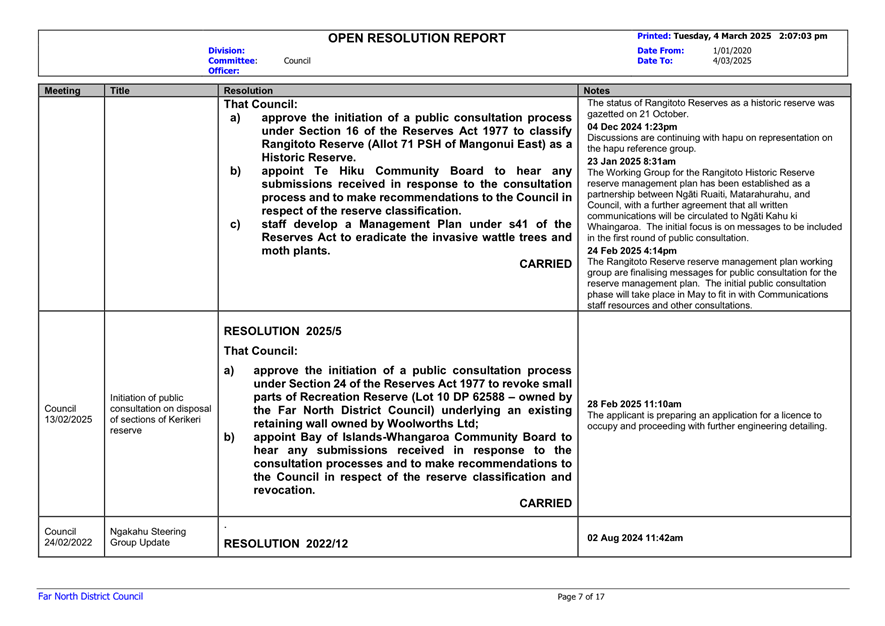
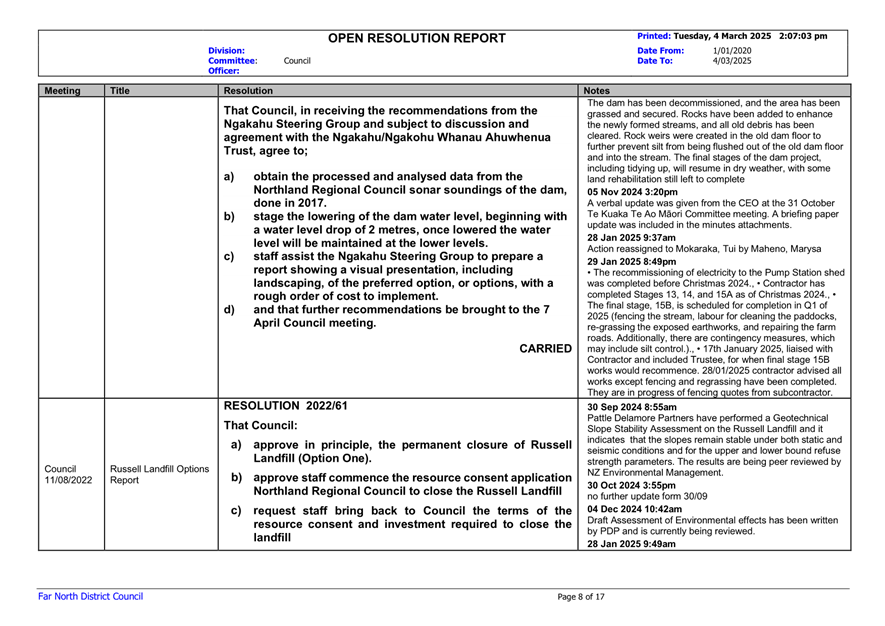

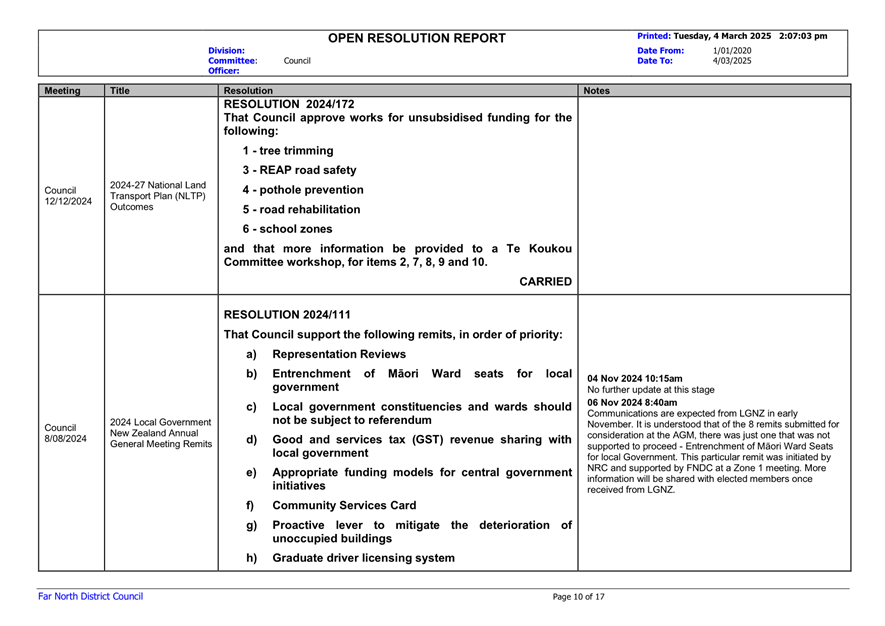
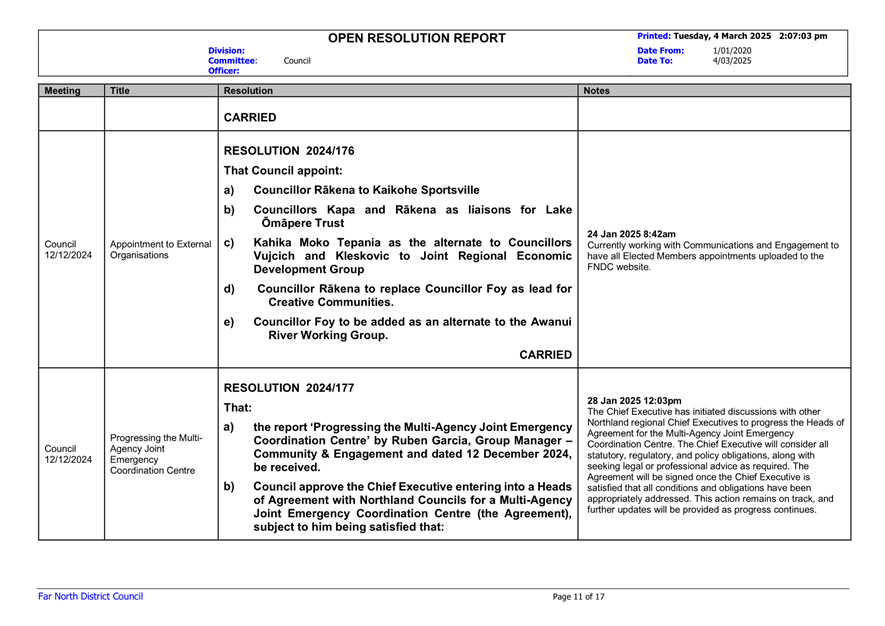
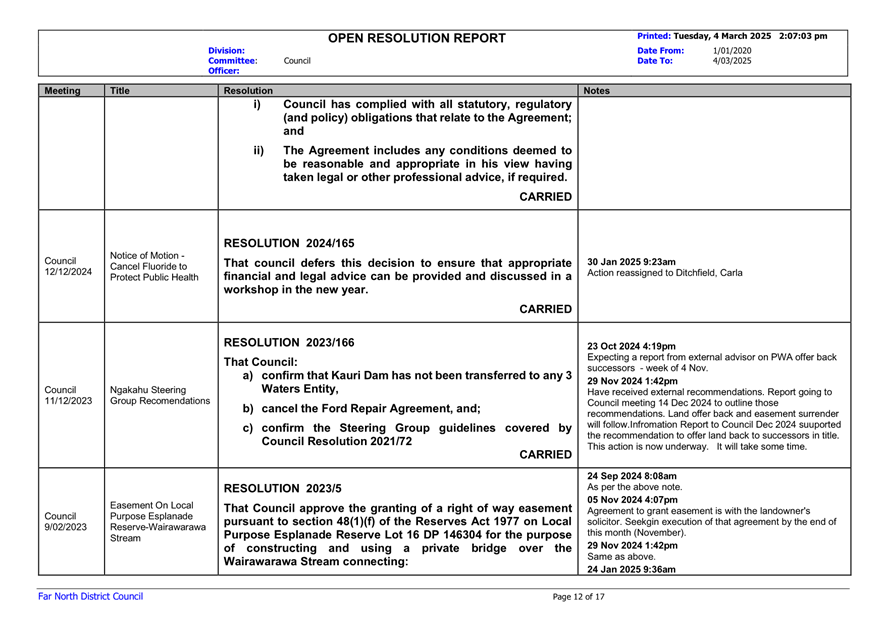
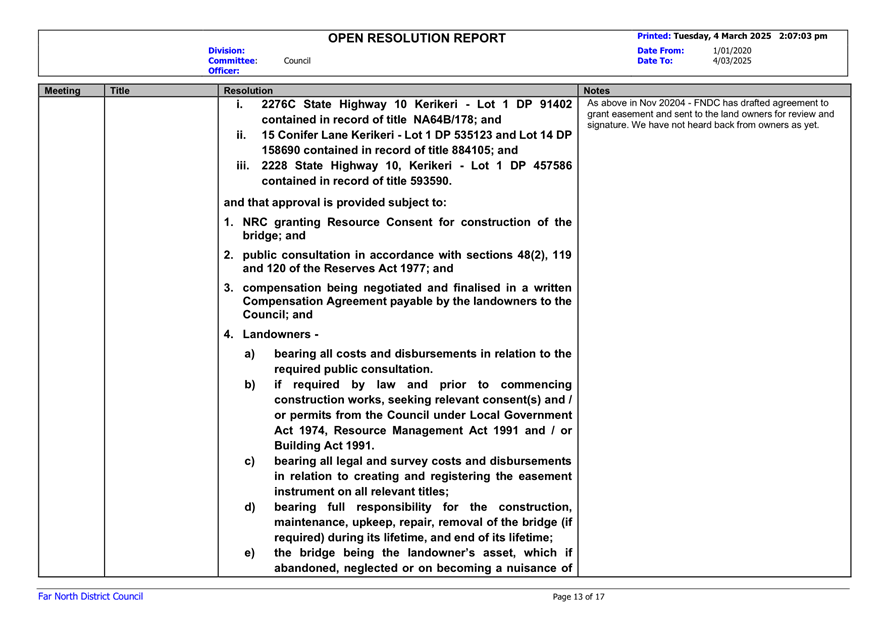

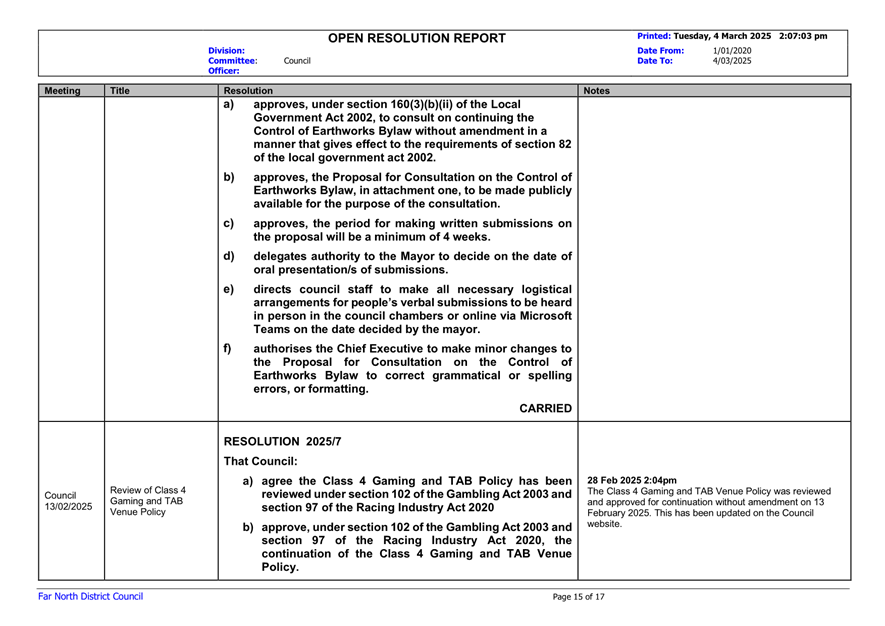
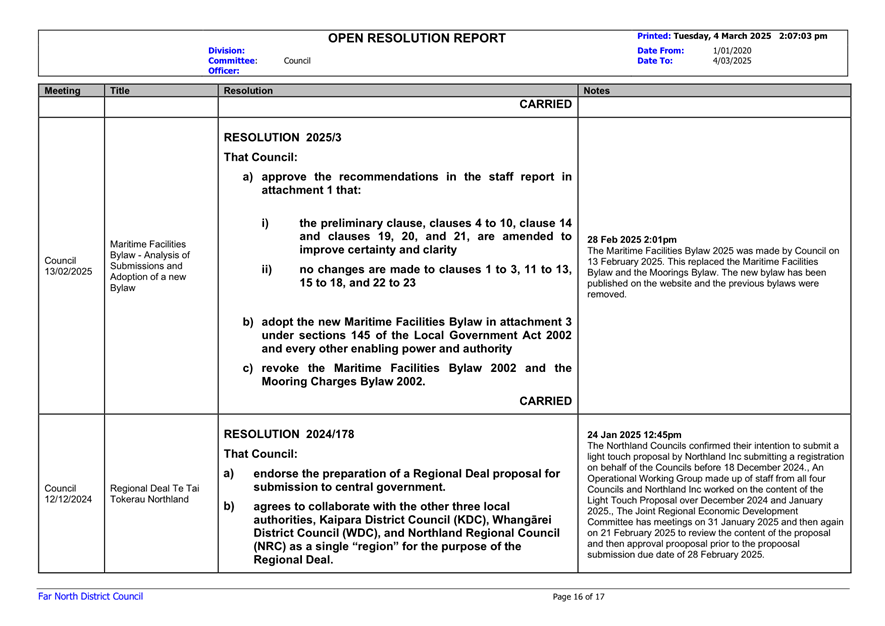
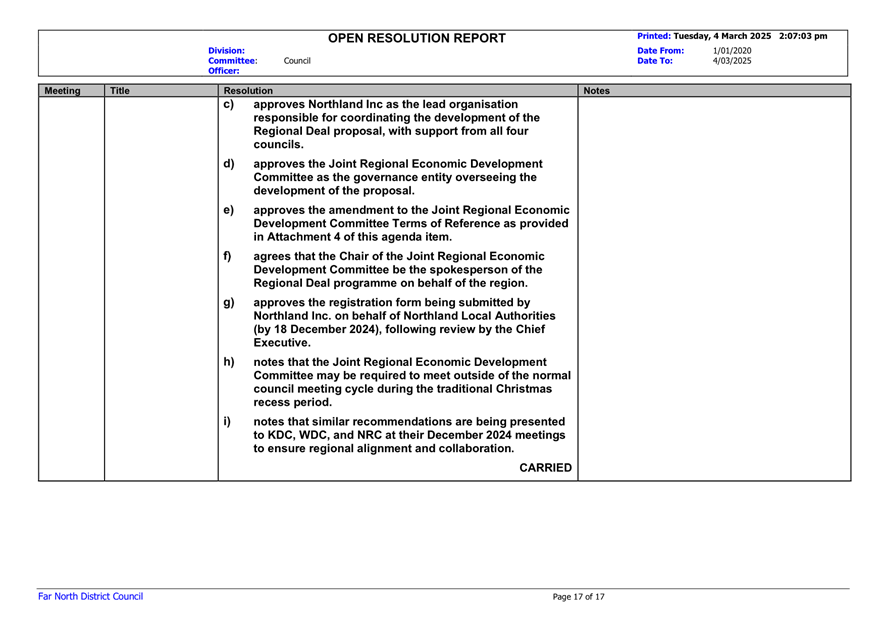
7.5 Local
Authority Elections 2025 Guidelines for Elected Members
File
Number: A5104198
Author: Casey
Gannon, Manager - Civic Engagement and Education
Authoriser: Ian
Wilson, Acting Group Manager - Strategic Relationships
TAKE PŪRONGO / Purpose of the Report
Provide
Elected Members with the guidelines for communication in the pre-election
period, as published by Local Government New Zealand/Taituarā (reviewed by
the Office of the Auditor General and the Department of internal Affairs). The
pre-election period runs from 11 July 2025 to 11 October 2025 (election day).
WHAKARĀPOPOTO MATUA / Executive SummarY
Elected Members are responsible for adhering to Local
Authority Elections 2025 Guidelines for Elected Members during pre-election
period. The pre-election period begins on 11 July 2025 and ends on election day
and is defined in alignment to the ‘applicable period’ in section
104 of the Local Electoral Act 2001.
Key Dates:
· 4 July –
Nominations open (pre-election period begins)
· 1 August –
Nominations close (noon)
· 9 to 22 September
– Voting documents delivered
· 11 October –
Voting closes (noon)
|
TŪTOHUNGA
/ Recommendation
That the Council receive the report Local Authority
Elections 2025 Guidelines for Elected Members.
|
tĀHUHU KŌRERO / Background
Electoral Officer – Dale Ofsoske delivered a briefing
open to all Far North District Council elected members 26 February in Kaikohe
Chamber, community boards are scheduled to receive briefings from Deputy
Electoral Officer – Casey Gannon at March meetings for those that missed
the 26 Feb briefing.
A briefing to all Northland elected members at their
respective Councils are scheduled for:
· NRC: 19 March
· KDC: 5 March
· WDC: 25 Feb
MATAPAKI ME NGĀ KŌWHIRINGA /
Discussion and Next Steps
Council business as usual
for all elected members, either seeking re-election or not, continues until the
official results are declared.
Key Points for Incumbents
Seeking Re-election:
· Differentiation
between council duties and campaign activities is essential.
· Council
resources must not be used for election purposes.
· Social
media channels must remain neutral and not be used for campaigning.
· Elected
members will have access to necessary information but cannot use it for
electioneering.
Questions, clarity or
concerns contact Deputy Electoral Officer (Casey Gannon 09 401-5676,
casey.gannon@fndc.govt.nz) in the first instance.
PĀNGA PŪTEA ME NGĀ WĀHANGA
TAHUA / Financial Implications and Budgetary Provision
No budgetary implications
to consider for this report.
Āpitihanga
/ Attachments
1. 2025
Elected Member Guidelines - Local Government Election - A5104158 ⇩ 
2. 2025
FNDC-Pre-Election-EMProtocols-Dale Ofsoske - A5104152 ⇩ 
3. LGNZTaituara
Communication in the pre-election period Guidelines - A5104163 ⇩ 
|
Ordinary
Council Meeting Agenda
|
13 March 2025
|
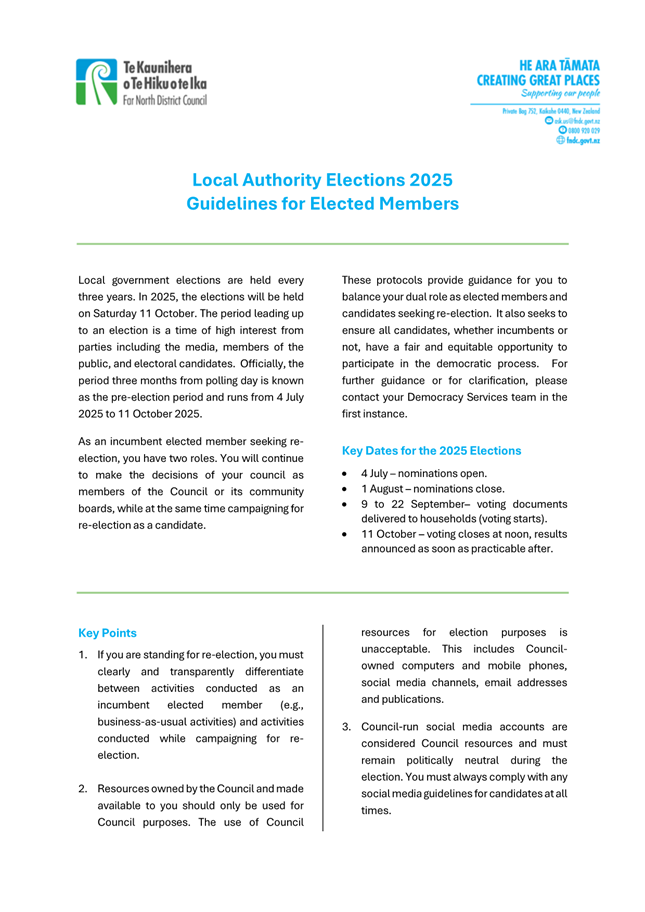
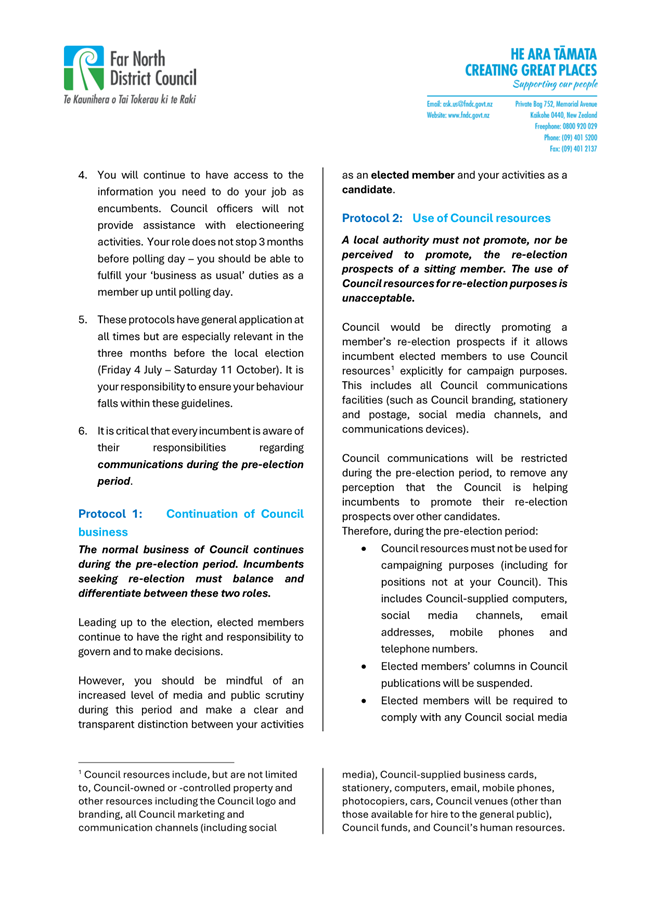
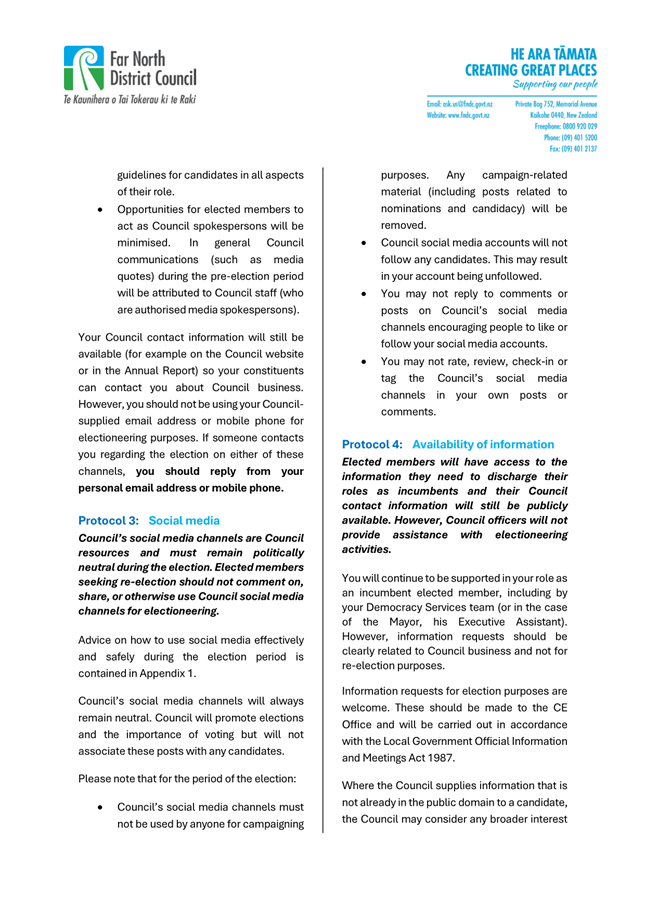
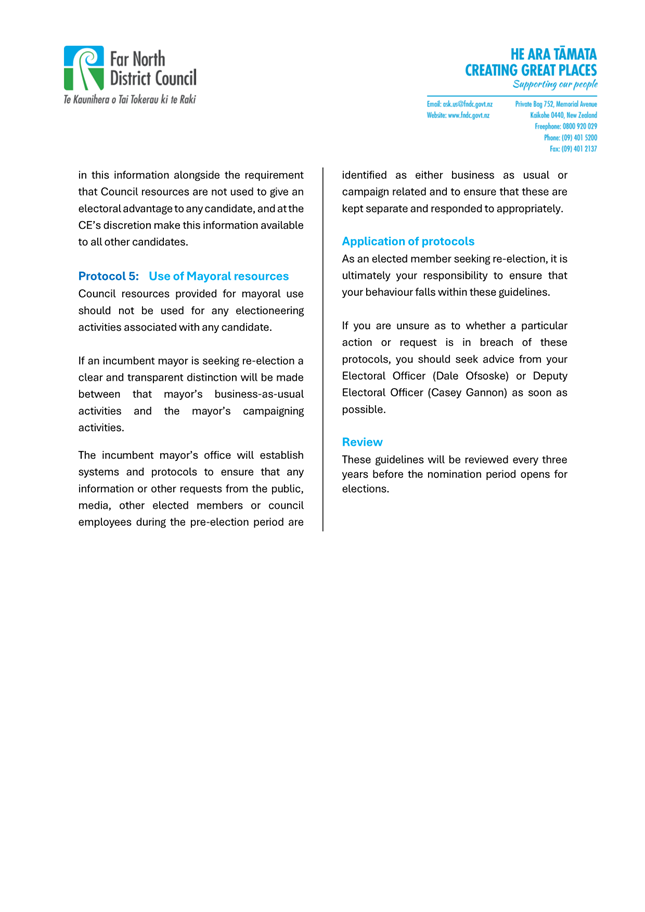
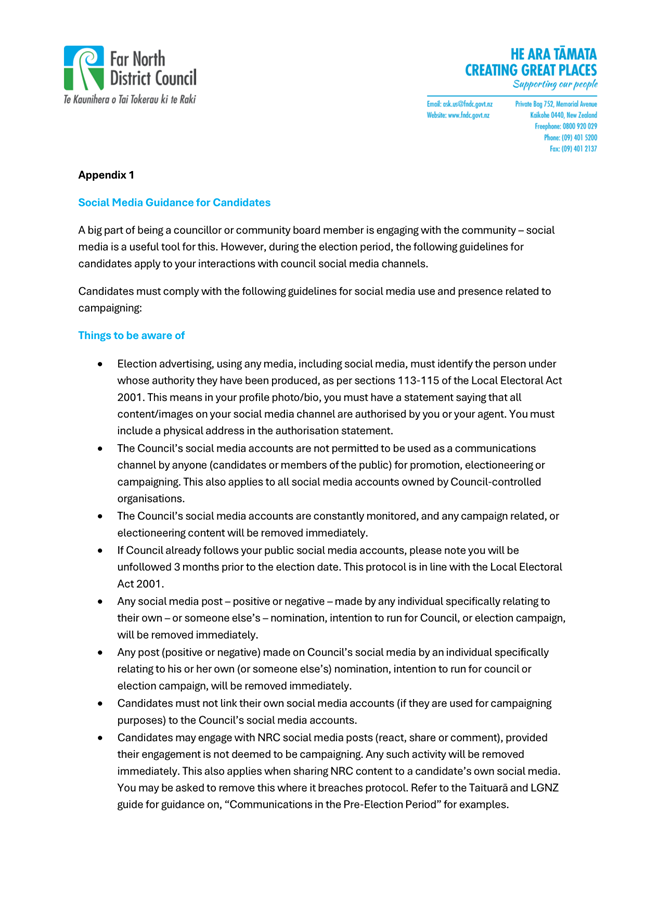
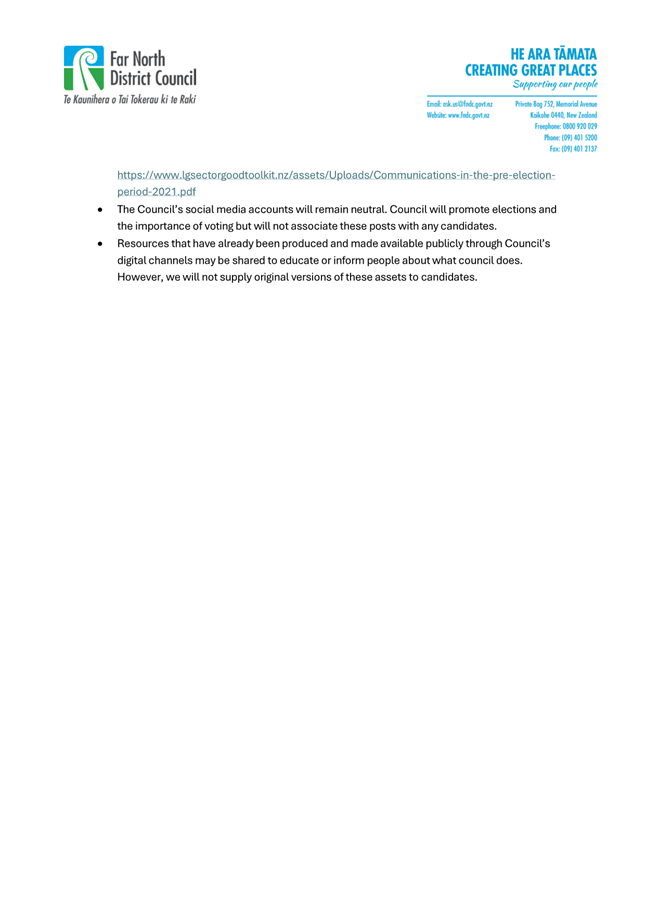
|
Ordinary Council
Meeting Agenda
|
13 March 2025
|

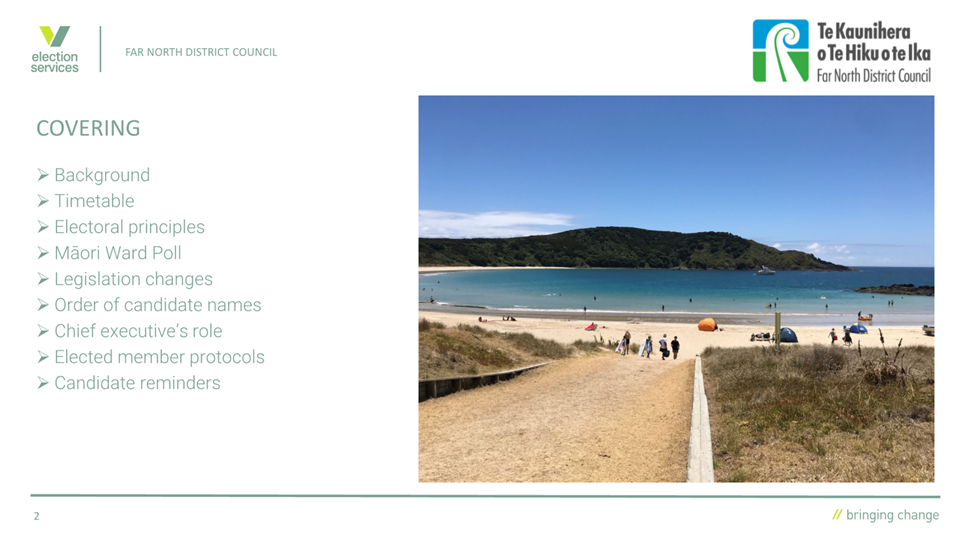
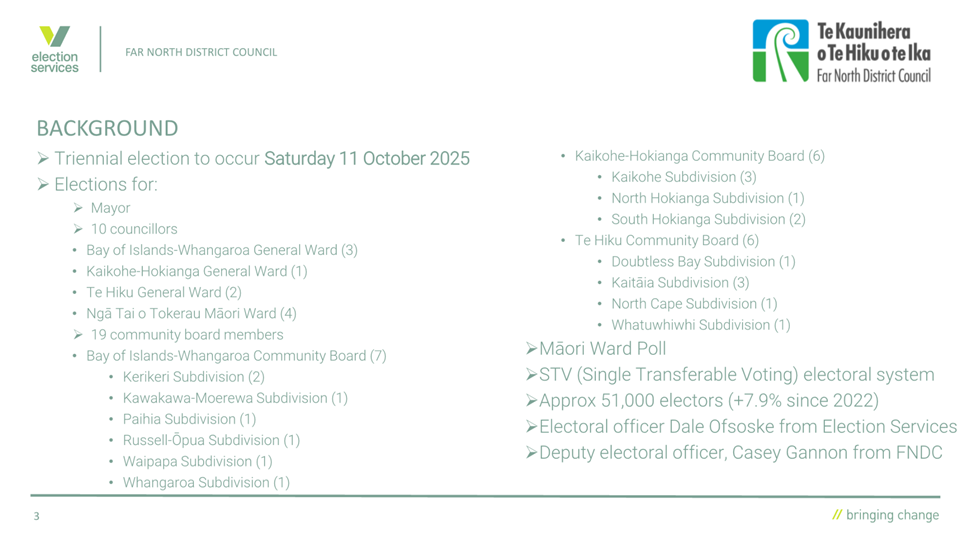
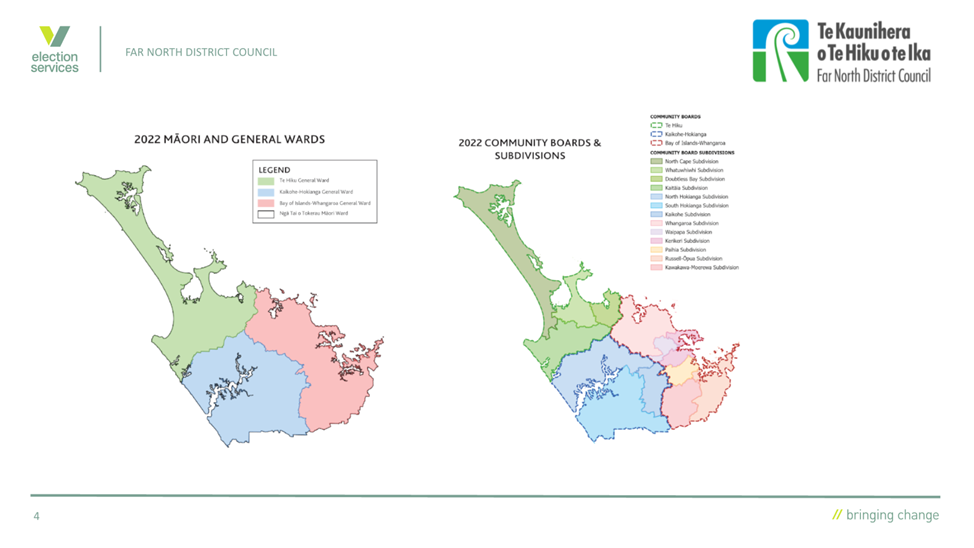

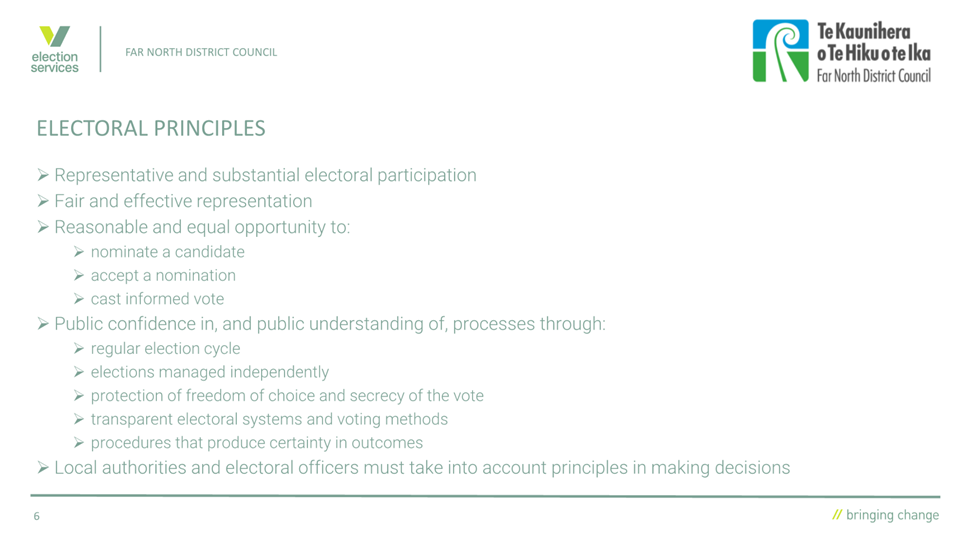

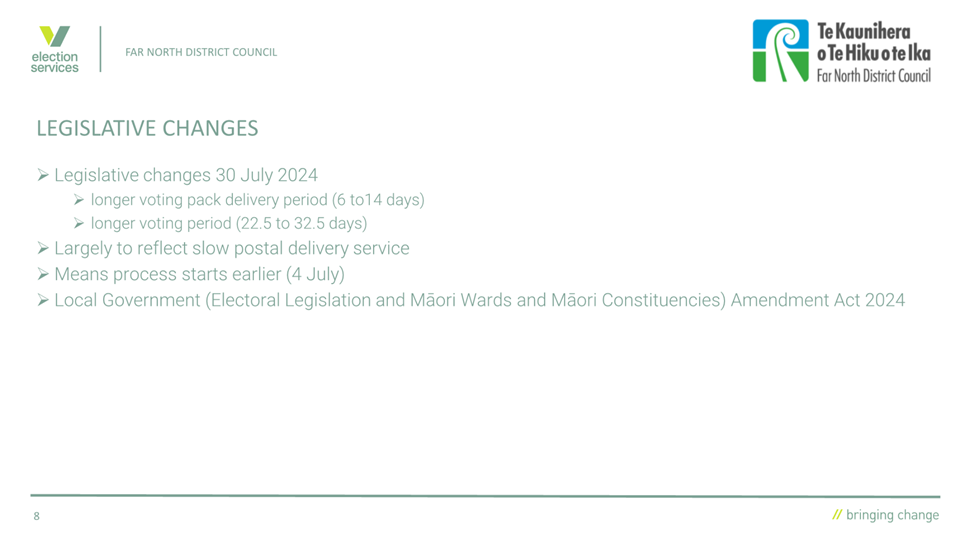
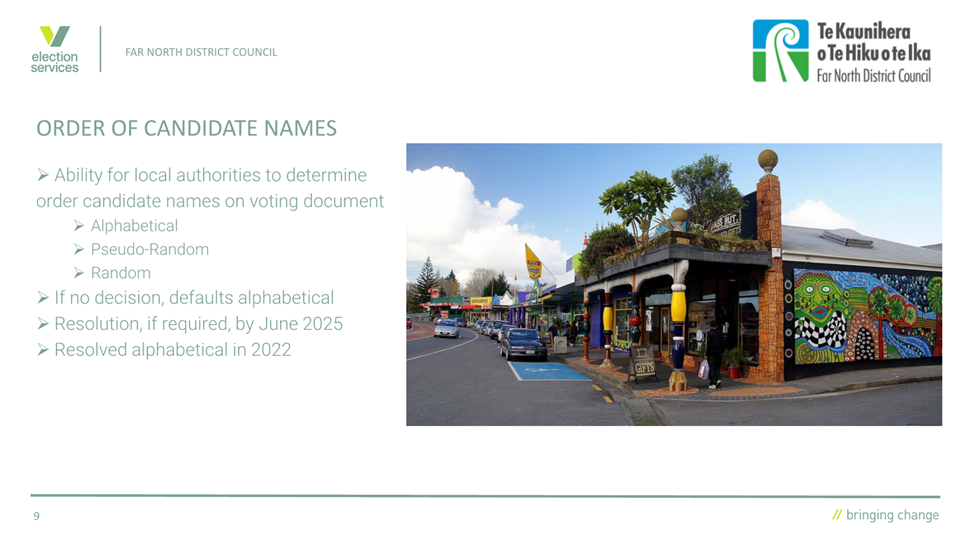
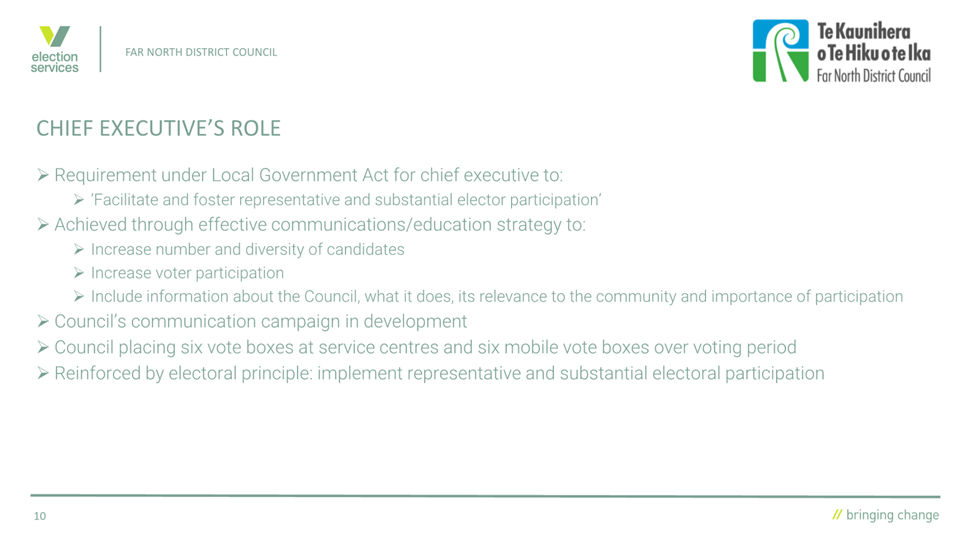
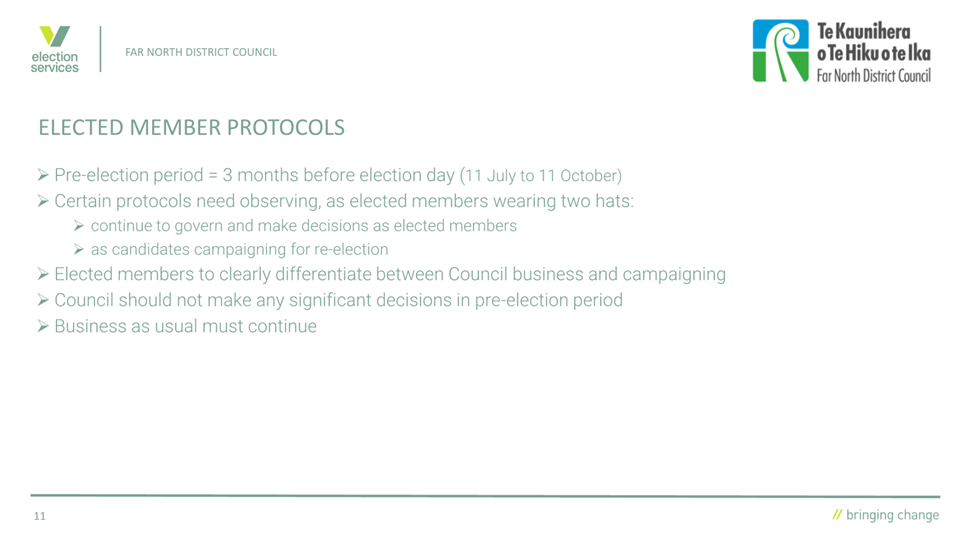
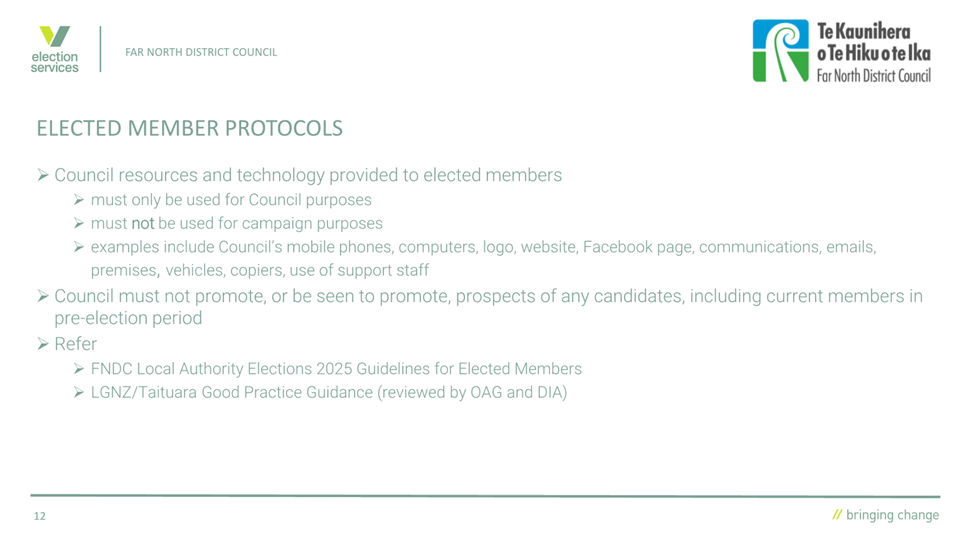
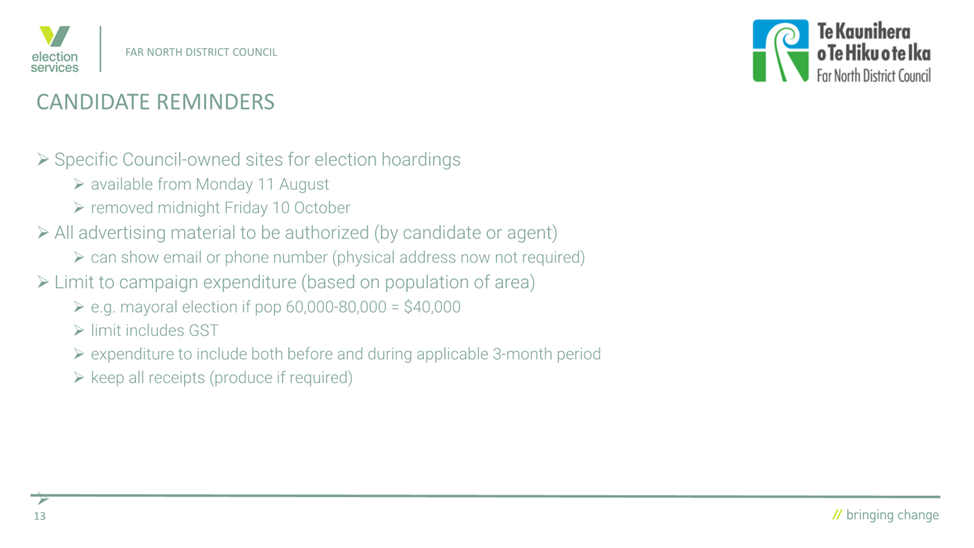
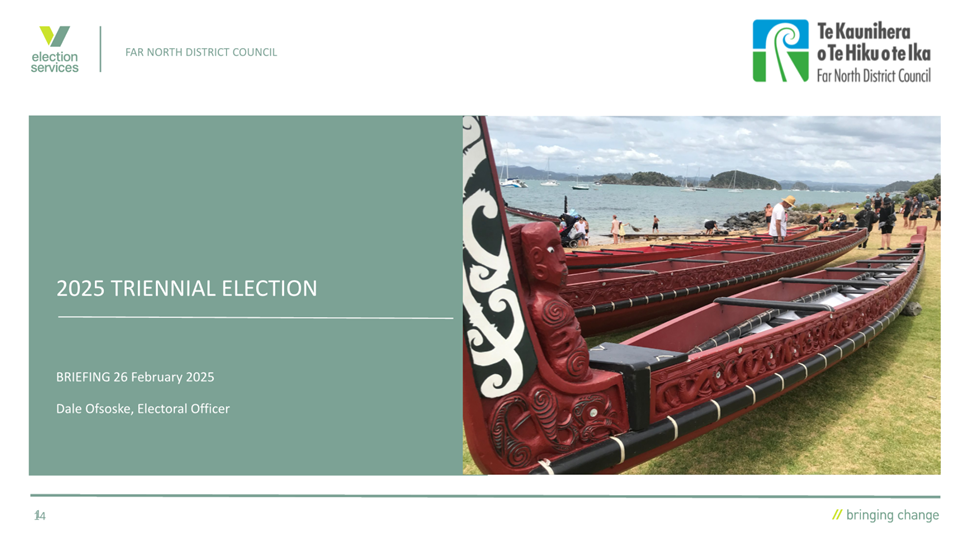
|
Ordinary Council
Meeting Agenda
|
13 March 2025
|
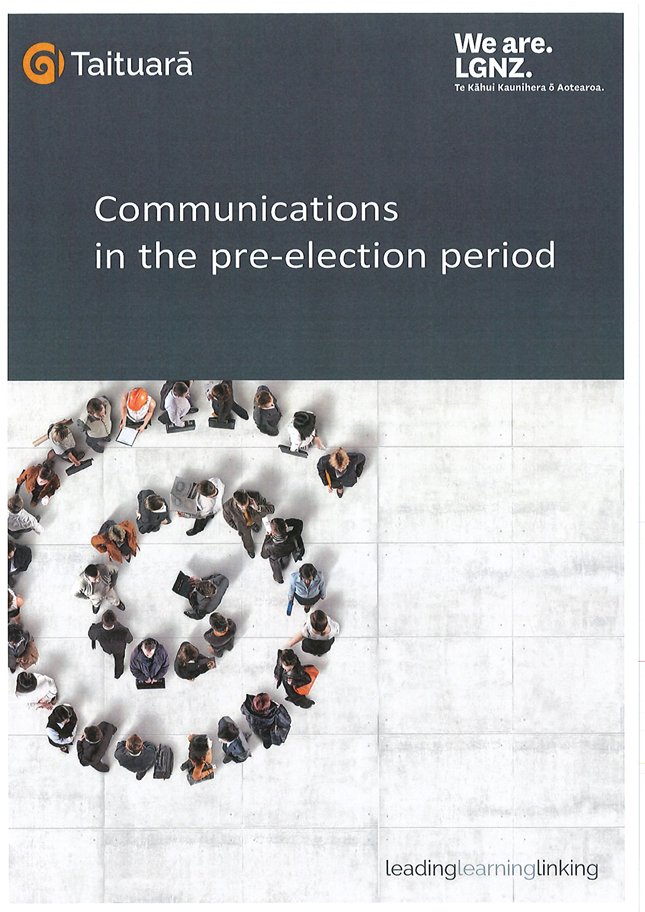

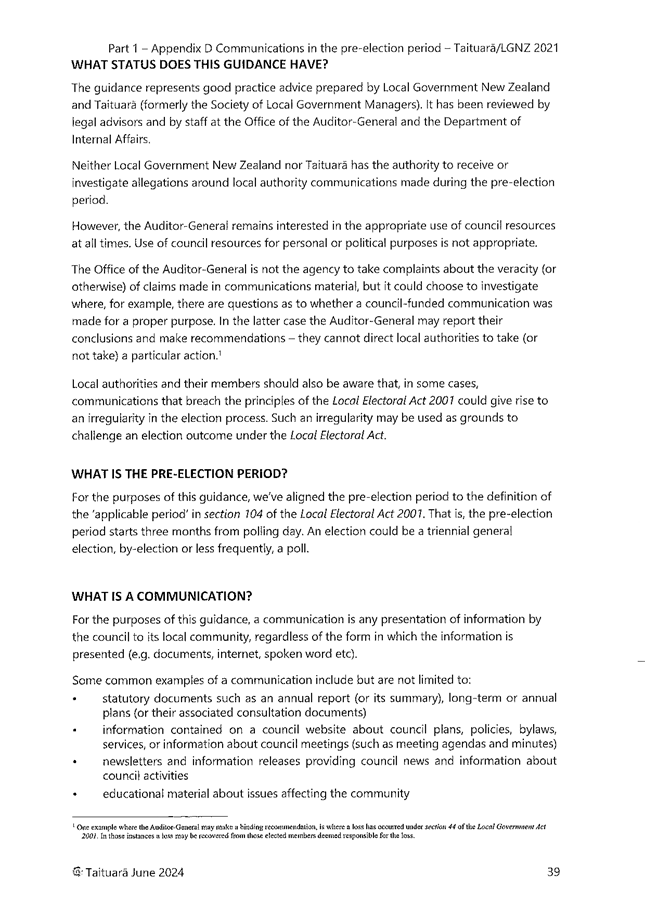

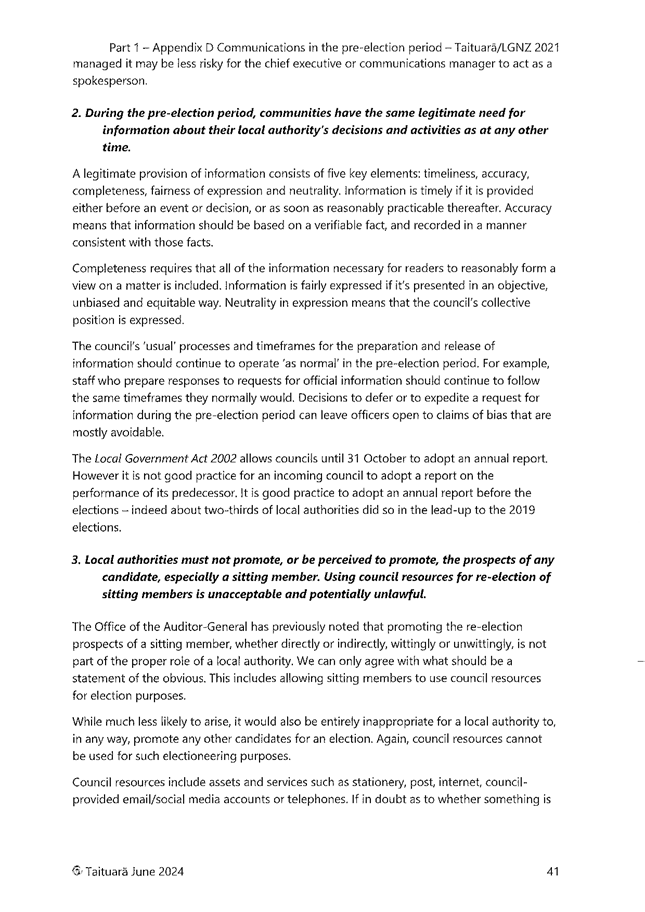
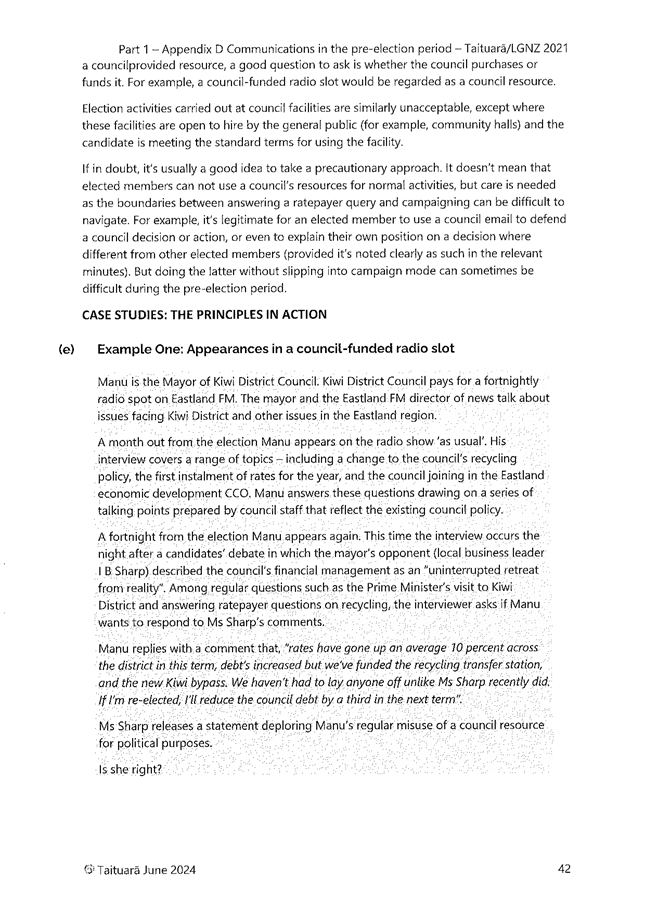
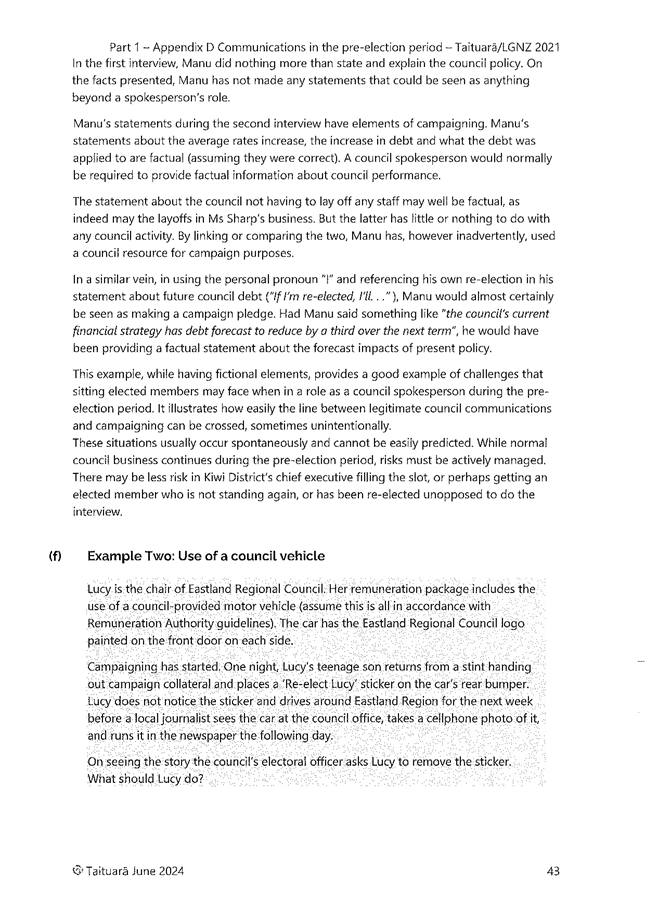

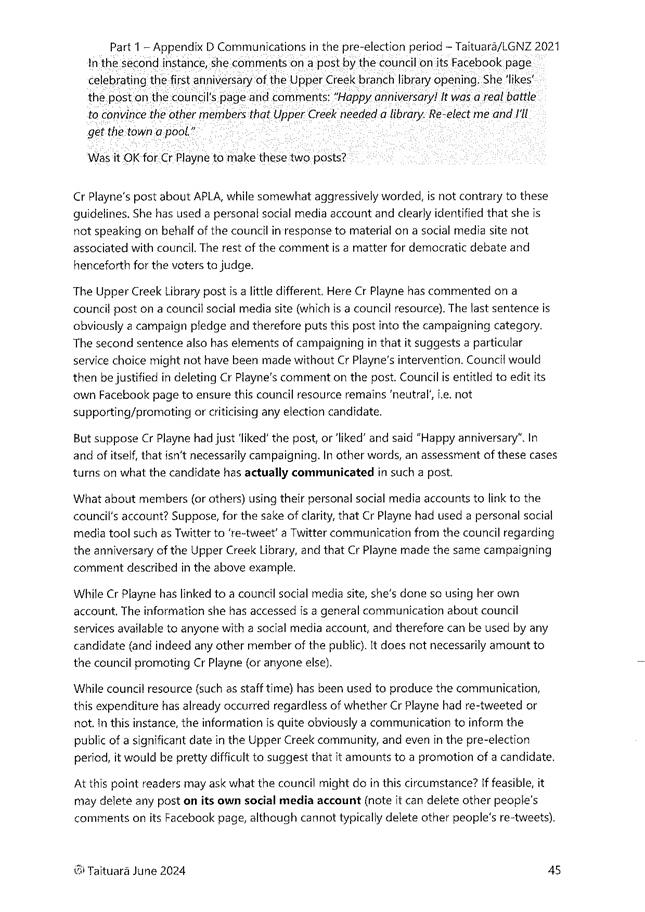


|
Ordinary
Council Meeting Agenda
|
13 March 2025
|
8 Te
Wāhanga Tūmataiti / Public Excluded
RESOLUTION TO
EXCLUDE THE PUBLIC
|
Recommendation
That the public be excluded from the following parts of
the proceedings of this meeting.
The general subject matter of each matter to be considered
while the public is excluded, the reason for passing this resolution in
relation to each matter, and the specific grounds under section 48 of the
Local Government Official Information and Meetings Act 1987 for the passing
of this resolution are as follows:
|
General subject of each matter to be
considered
|
Reason for passing this resolution in
relation to each matter
|
Ground(s) under section 48 for the
passing of this resolution
|
|
8.1 - Confirmation of Previous Minutes
- Public Excluded
|
s7(2)(a) - the withholding of the information is
necessary to protect the privacy of natural persons, including that of
deceased natural persons
s7(2)(h) - the withholding of the information is
necessary to enable Council to carry out, without prejudice or
disadvantage, commercial activities
s7(2)(i) - the withholding of the information is
necessary to enable Council to carry on, without prejudice or disadvantage,
negotiations (including commercial and industrial negotiations)
|
s48(1)(a)(i) - the public conduct of the relevant
part of the proceedings of the meeting would be likely to result in the
disclosure of information for which good reason for withholding would exist
under section 6 or section 7
|
|
8.2 - Community Board Public Excluded
Minutes - February 2025
|
s48(2)(a)(i) - the exclusion of the public from
the whole or the relevant part of the proceedings of the meeting is
necessary to enable the Council to deliberate in private on its decision or
recommendation where a right of appeal lies to any court or tribunal
against the final decision of the Council in these proceedings
|
s48(2)(a)(i) - the exclusion of the public from
the part of the meeting is necessary to enable the local authority to
deliberate in private on its decision or recommendation
|
|
8.3 - Council Public Excluded Open
Resolutions Update March 2025
|
s7(2)(g) - the withholding of the information is
necessary to maintain legal professional privilege
s7(2)(i) - the withholding of the information is
necessary to enable Council to carry on, without prejudice or disadvantage,
negotiations (including commercial and industrial negotiations)
|
s48(1)(a)(i) - the public conduct of the relevant
part of the proceedings of the meeting would be likely to result in the
disclosure of information for which good reason for withholding would exist
under section 6 or section 7
|
|
8.4 - General Employment Matter
|
s7(2)(a) - the withholding of the information is
necessary to protect the privacy of natural persons, including that of
deceased natural persons
s7(2)(i) - the withholding of the information is
necessary to enable Council to carry on, without prejudice or disadvantage,
negotiations (including commercial and industrial negotiations)
|
s48(1)(a)(i) - the public conduct of the relevant
part of the proceedings of the meeting would be likely to result in the
disclosure of information for which good reason for withholding would exist
under section 6 or section 7
|
|
 AGENDA
AGENDA
































































































































































































